In 2016-17, West Ham finished 11th with 45 points with below par metrics that roughly merited their points haul. By the start of the following November, Slaven Bilić had steered them downwards to 18th with bad metrics and a worse goal difference. He promptly exited and David Moyes was hired. Moyes did nothing for the underlying metrics (they were fairly stable at -0.5 xG per game across both managers) but eked out just enough from his team to keep them up. Moyes may have felt some displeasure at not being handed a longer tenure at that point but objectively, despite fulfilling the first remit of keeping the team in the Premier League, only a very charitable-minded review could say that he had improved his team. Mauricio Pellegrini was hired instead. In 2018-19, West Ham finished 10th with 52 points with below par metrics that did not merit their points haul. By end of the following December, Manuel Pellegrini had steered them downwards to 17th with a bad goal difference and worse metrics. He promptly exited and David Moyes was hired. Moyes did nothing for the underlying metrics (they were fairly stable at -0.6 xG per game across both managers) then the world fell apart, everyone stopped playing football and stayed in the house for three months. Pellegrini’s main issue had been a horribly open defence: the value of the shots they were giving up was higher than any other team in the league (0.13 xG/shot) and Moyes, ever the pragmatist, set about shutting that down. In the ten games before the suspension of play, West Ham recorded the lowest PPDA (pass per defensive action) value in the league (16.2). They had the deepest average defensive distance (39.8m). They were the least aggressive pressers of opponent ball receipts (19%). They had less of the ball than any other team. Translation for all that? They sat off. It had barely any effect though, as opponent shot quality remained high (0.12 xG/shot). Under either manager opponents could get nice and deep into the penalty box and grab good shots: 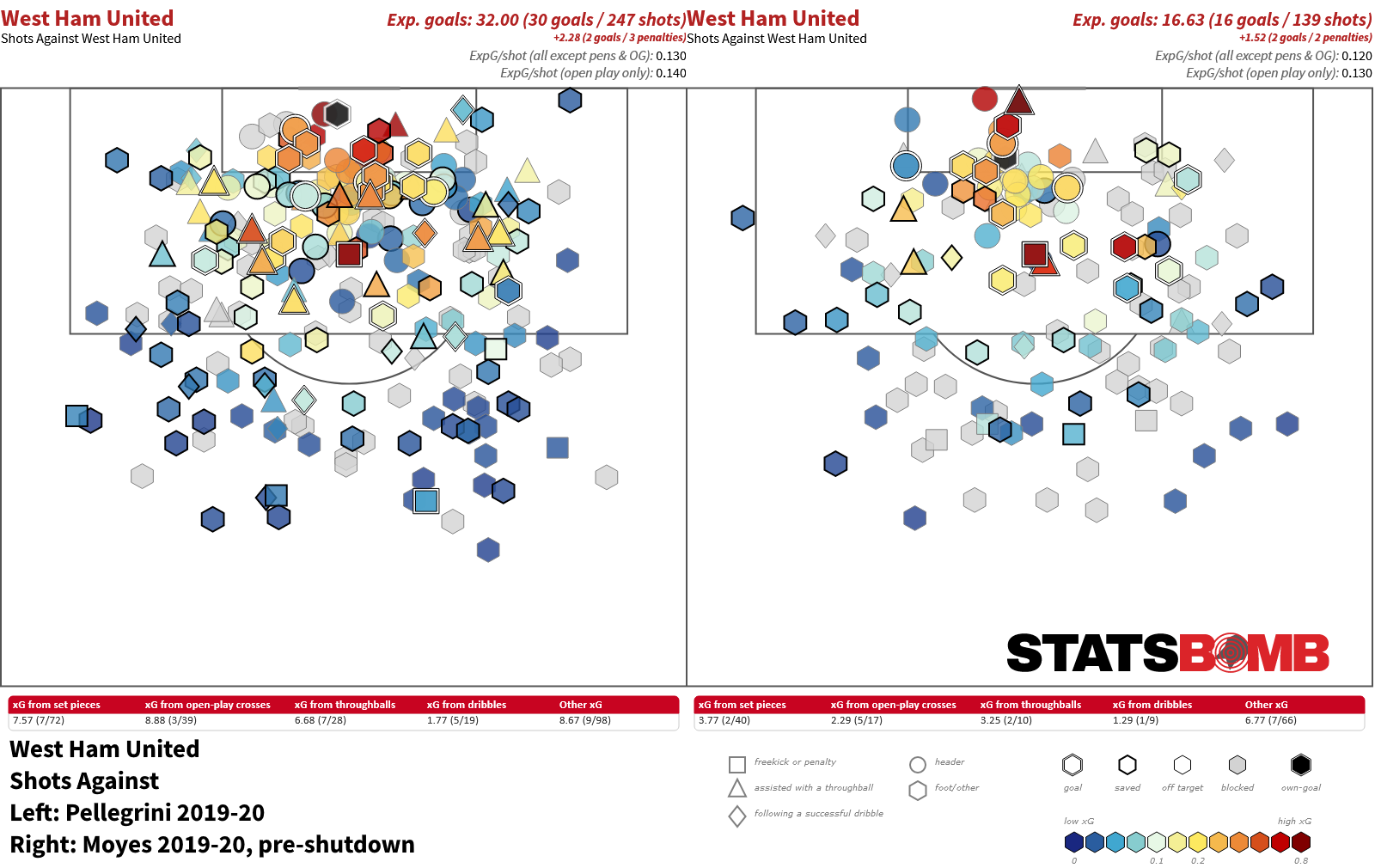 It’s an open question what may have happened to West Ham’s season had the viral intervention not occurred. The team were in sixteenth on 27 points, level with Watford and Bournemouth in seventeenth and eighteenth and with nine games left to rescue themselves from possible relegation. It's also an open question as to how reliable the form is of this concentrated post-lockdown period. Oddly, since leaving Everton and starting at Manchester United, Moyes has had four further managerial tenures, and apart from the summer of 2015 while in charge of Real Sociedad, the Covid break has been the only time he has had an extended period as a manager outside the grind of regular in season games. And given three months to prepare, Moyes managed to hit upon something that worked. The initial Moyes period did have the misfortune of some schedule stacking--they faced Liverpool twice, and Manchester City-- so there is room for some caution when considering the apparent improvement the team made, but he chopped and changed his formations in that early run, and post-lockdown stuck with a 4-2-3-1. As the season wound up, his starting eleven became more consistent too: Łukasz Fabiański in goal, a back four of Ryan Fredricks, Issa Diop, Angelo Ogbonna, Aaron Cresswell, Declan Rice and Tomáš Souček sitting, Pablo Fornals or Manuel Lanzini left, Jarrod Bowen right, Mark Noble's aging legs parked upfield as an attacking midfielder, at least in name, and Michail Antonio up front. This left a selection of expensive potential game-changers often manning the bench. Sébastien Haller, Andriy Yarmolenko and Felipe Anderson's combined cost was around £100m and they watched a good deal of football in those final weeks, occasionally, pitching in late on in games. The players that benefited most from Moyes' June reboot were the two January signings, Bowen and Souček and converted striker Antonio. Souček is a fascinating player for a central midfielder as despite many column inches being spent on the possibility of his midfield partner Rice becoming a centre back, at least from a data perspective he looks to have more centre back aligned tools. No central midfielder in the league got anywhere near his 5.1 aerial wins per 90 (next best was Phillip Billing at 3.4). He's also useful at the other end of the pitch as a goal threat in open play and from set-pieces having scored 30 goals in his last two seasons at Slavia Prague. He's added three more since arriving in England. He's a curious passer for a defensive midfielder too. Keeping the ball on the deck and playing short, he's just about secure enough (he completed over 90% of passes, still less than Rice's 95%) but as soon as he puts the ball forward and in the air it drops to 40% (down from 60% at Slavia). Quick analysis suggests that quite a lot of these failed attempts are out balls aimed at Antonio or Bowen, and Rice scopes out better at those too. Add Noble into the mix, who nominally played in the middle of the attacking midfield band as the season drew to a close, but effectively sat a lot closer to the other two defensive midfielders, and we see a clear strategy--find Antonio or Bowen if you can--that is effective only sporadically. Just 28% of high and longer passes from their own half forward and into the opponent half are finding their intended target. All this feeds into the idea of what you can get from Bowen and Antonio. Each is effective at carrying the ball deep into opposition territory (as is Felipe Anderson, moreso even, across the whole season, he ranks second behind Adama Traoré for these long carries) and are a danger to the opponent's goal:
It’s an open question what may have happened to West Ham’s season had the viral intervention not occurred. The team were in sixteenth on 27 points, level with Watford and Bournemouth in seventeenth and eighteenth and with nine games left to rescue themselves from possible relegation. It's also an open question as to how reliable the form is of this concentrated post-lockdown period. Oddly, since leaving Everton and starting at Manchester United, Moyes has had four further managerial tenures, and apart from the summer of 2015 while in charge of Real Sociedad, the Covid break has been the only time he has had an extended period as a manager outside the grind of regular in season games. And given three months to prepare, Moyes managed to hit upon something that worked. The initial Moyes period did have the misfortune of some schedule stacking--they faced Liverpool twice, and Manchester City-- so there is room for some caution when considering the apparent improvement the team made, but he chopped and changed his formations in that early run, and post-lockdown stuck with a 4-2-3-1. As the season wound up, his starting eleven became more consistent too: Łukasz Fabiański in goal, a back four of Ryan Fredricks, Issa Diop, Angelo Ogbonna, Aaron Cresswell, Declan Rice and Tomáš Souček sitting, Pablo Fornals or Manuel Lanzini left, Jarrod Bowen right, Mark Noble's aging legs parked upfield as an attacking midfielder, at least in name, and Michail Antonio up front. This left a selection of expensive potential game-changers often manning the bench. Sébastien Haller, Andriy Yarmolenko and Felipe Anderson's combined cost was around £100m and they watched a good deal of football in those final weeks, occasionally, pitching in late on in games. The players that benefited most from Moyes' June reboot were the two January signings, Bowen and Souček and converted striker Antonio. Souček is a fascinating player for a central midfielder as despite many column inches being spent on the possibility of his midfield partner Rice becoming a centre back, at least from a data perspective he looks to have more centre back aligned tools. No central midfielder in the league got anywhere near his 5.1 aerial wins per 90 (next best was Phillip Billing at 3.4). He's also useful at the other end of the pitch as a goal threat in open play and from set-pieces having scored 30 goals in his last two seasons at Slavia Prague. He's added three more since arriving in England. He's a curious passer for a defensive midfielder too. Keeping the ball on the deck and playing short, he's just about secure enough (he completed over 90% of passes, still less than Rice's 95%) but as soon as he puts the ball forward and in the air it drops to 40% (down from 60% at Slavia). Quick analysis suggests that quite a lot of these failed attempts are out balls aimed at Antonio or Bowen, and Rice scopes out better at those too. Add Noble into the mix, who nominally played in the middle of the attacking midfield band as the season drew to a close, but effectively sat a lot closer to the other two defensive midfielders, and we see a clear strategy--find Antonio or Bowen if you can--that is effective only sporadically. Just 28% of high and longer passes from their own half forward and into the opponent half are finding their intended target. All this feeds into the idea of what you can get from Bowen and Antonio. Each is effective at carrying the ball deep into opposition territory (as is Felipe Anderson, moreso even, across the whole season, he ranks second behind Adama Traoré for these long carries) and are a danger to the opponent's goal: 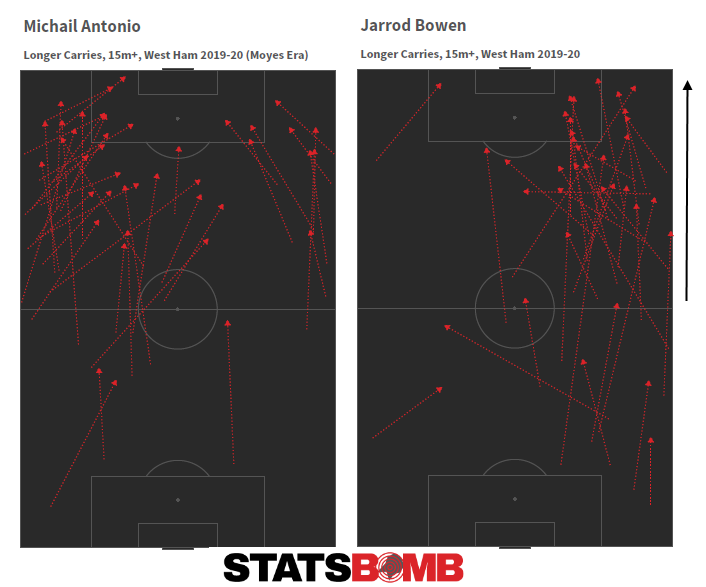 Once they have the ball, there's a good chance you'll see a shot at the end of it. One of Bowen's known weaknesses is shot selection, but from enforced turnovers, his rate of getting shots (any kind) leads the league, with Antonio not that far behind:
Once they have the ball, there's a good chance you'll see a shot at the end of it. One of Bowen's known weaknesses is shot selection, but from enforced turnovers, his rate of getting shots (any kind) leads the league, with Antonio not that far behind: 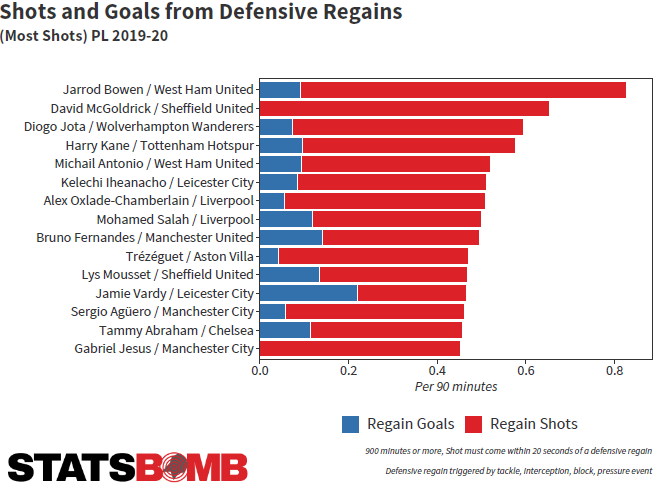 So Moyesball 2.0 is thus: defence first, a defensive midfielder with centre back qualities and an eye for goal, a converted passing defensive midfielder in the 10 slot and targeting zone movers to get the ball up the pitch and shoot. The result of this was spectacular for Antonio, who was second only to Raheem Sterling for xG per 90 after the restart. Once more reborn as a striker, he was more than a handful:
So Moyesball 2.0 is thus: defence first, a defensive midfielder with centre back qualities and an eye for goal, a converted passing defensive midfielder in the 10 slot and targeting zone movers to get the ball up the pitch and shoot. The result of this was spectacular for Antonio, who was second only to Raheem Sterling for xG per 90 after the restart. Once more reborn as a striker, he was more than a handful: 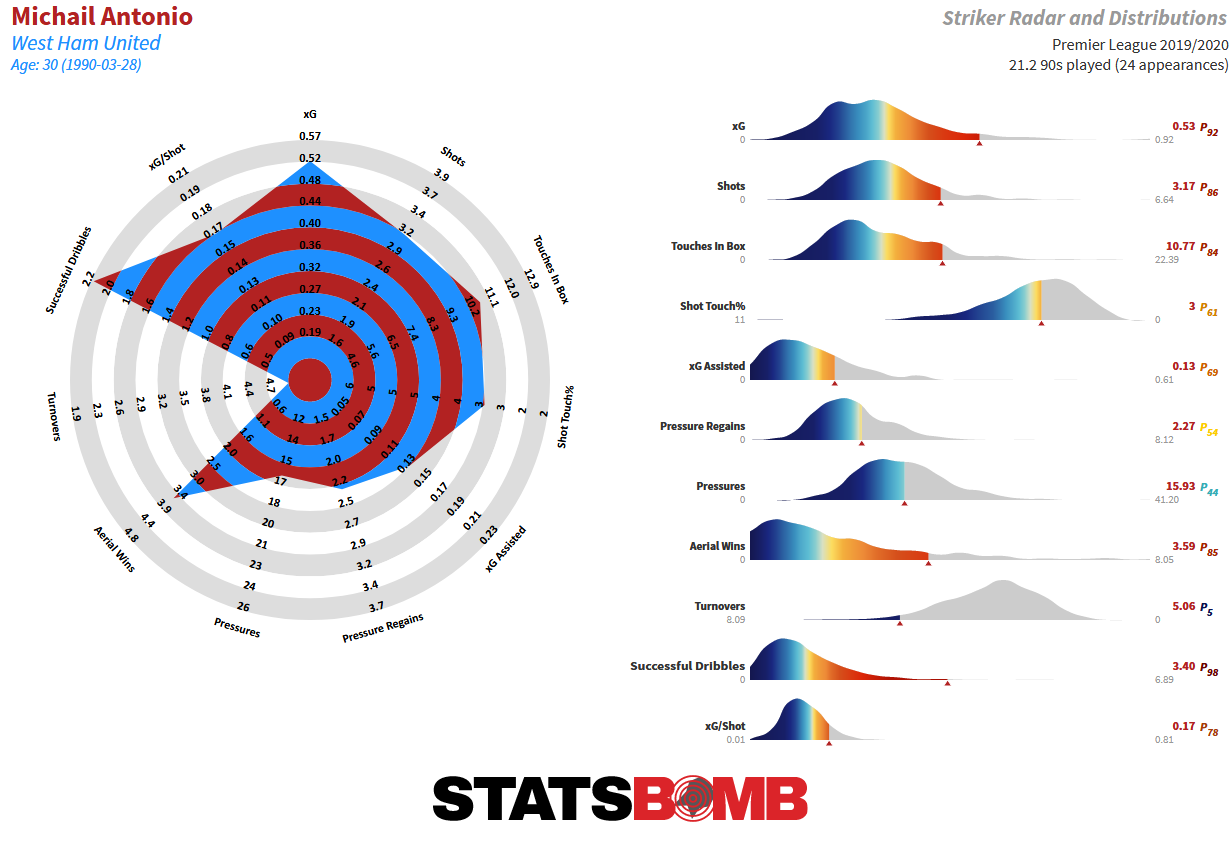 Even if we unfairly disregard his four-goal, nine shot, 2.1 xG game against Norwich, he still scopes out very well. A shade under three shots and 0.55 xG per 90 in the Moyes era is everything you want from a centre forward on a non-elite team. It will be hard to keep him out of the starting line-up when the league resumes providing an injury sustained in a warm-up match against Brentford does not persist. The period of summer football saw West Ham pick up twelve points from nine games. Not bad. But among that their metrics took a huge u-turn moving from "actually bad" to "really quite good":
Even if we unfairly disregard his four-goal, nine shot, 2.1 xG game against Norwich, he still scopes out very well. A shade under three shots and 0.55 xG per 90 in the Moyes era is everything you want from a centre forward on a non-elite team. It will be hard to keep him out of the starting line-up when the league resumes providing an injury sustained in a warm-up match against Brentford does not persist. The period of summer football saw West Ham pick up twelve points from nine games. Not bad. But among that their metrics took a huge u-turn moving from "actually bad" to "really quite good": 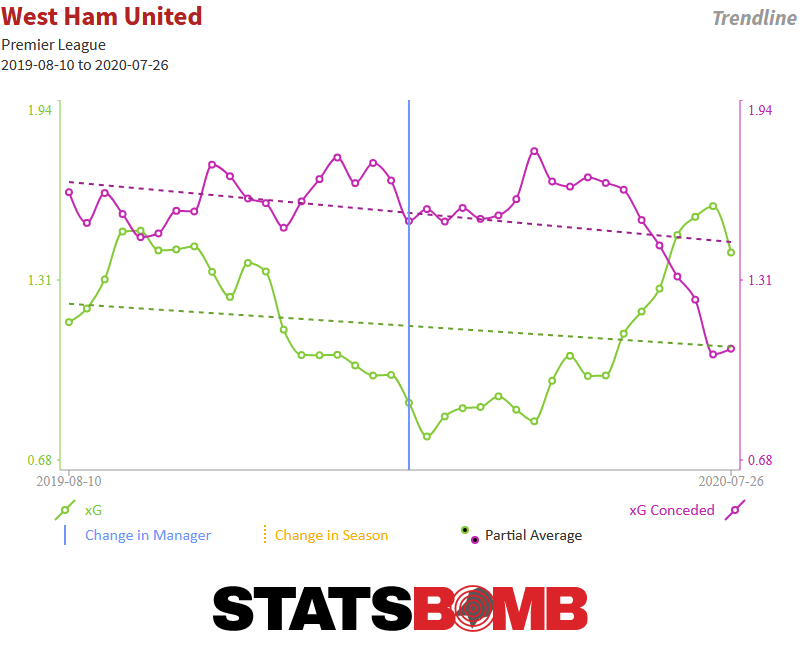 Post-lockdown xG difference was around +0.3 per 90, and goal difference matched it. The key to this defensively was the opposition shot quality finally taking a positive hit. It crashed down to 0.09 per shot. This shaved around a third off versus their season long xG Against during this period, and they also had the better end of set-pieces, scoring four and allowing just one, in line with expectation there too. Now a lot of these movements fall into the realm of possible variance within a short period of time, but West Ham haven't see this kind of positive move in metrics for a long time. At least, for now, there can be some hope that they can continue to play the style of football they provided in the summer of 2020 and be more successful, perhaps even lift themselves out of the mix for a relegation battle. Recruitment and fitness of key men may play a part in how successful that desire is. Personnel Director of Football Mario Husillos left with Manuel Pellegrini in December 2019. His record was embodied by a lot of money spent on appealing attackers, few of which have really made enough of a mark when factored against fees spent. This senior role hasn’t subsequently been publicly filled by anyone, though somebody signed off on the transfers of Bowen and Souček in January. Moyes appeared clear minded in what he wanted to do this window in an early August interview with the Evening Standard and is presumably close to the throne here, and is perhaps sitting in it: “We would like to strengthen in a lot of areas. We’re lacking in defensive cover … We’re trying to bring in a younger group but we will also need a couple of experienced players. Central defenders are usually better when they’re more experienced … Anyone who knows anything about football would surely say, ‘This is a club that could do with a period of stability.’” With the extended transfer window not shutting til October, West Ham haven't yet been active, so it's hard to get a handle on any specific recruits. Rice's future is surely more settled now that Chelsea have purchased elsewhere and in the very short term West Ham's overall squad is relatively well set for the season ahead without overt tinkering. There are aging players in the squad--Ogbonna and Noble in particular saw high minutes last season and may perhaps need extra monitoring as they enter their 33rd and 34th years--but most recent recruitment has prioritised youth or prime ages. Antonio and Cresswell are two more starters that are the wrong side of 30 now, but, as Moyes alluded, an awareness of balancing youth and experience needs to be maintained. Prediction How good is this team? In the Moyes-era overall, West Ham collected points at 40 point pace. In the Moyes-post-lockdown-period, they were better and their 12 points in 9 games was 50 point pace. Expected goals under Moyes pegs then as among the best of the rest, top of the bottom half type range, so twelfth, and the Sporting Index pre-season points prediction has them about there too. Recent spending indicates a desire to exceed the old Pulis zone (40 to 50 points) and that may be enough to set sail for better times to come, providing the owners are happy to be solid first and entertaining second, something that they haven't always appeared to endorse. You know what you will get from Moyes teams. It might not be pretty, and there's not quite enough evidence in the tank to suggest that it will definitely be effective again, but there is a route for this team to create a stable and safe outcome. They just have to commit to it and execute.
Post-lockdown xG difference was around +0.3 per 90, and goal difference matched it. The key to this defensively was the opposition shot quality finally taking a positive hit. It crashed down to 0.09 per shot. This shaved around a third off versus their season long xG Against during this period, and they also had the better end of set-pieces, scoring four and allowing just one, in line with expectation there too. Now a lot of these movements fall into the realm of possible variance within a short period of time, but West Ham haven't see this kind of positive move in metrics for a long time. At least, for now, there can be some hope that they can continue to play the style of football they provided in the summer of 2020 and be more successful, perhaps even lift themselves out of the mix for a relegation battle. Recruitment and fitness of key men may play a part in how successful that desire is. Personnel Director of Football Mario Husillos left with Manuel Pellegrini in December 2019. His record was embodied by a lot of money spent on appealing attackers, few of which have really made enough of a mark when factored against fees spent. This senior role hasn’t subsequently been publicly filled by anyone, though somebody signed off on the transfers of Bowen and Souček in January. Moyes appeared clear minded in what he wanted to do this window in an early August interview with the Evening Standard and is presumably close to the throne here, and is perhaps sitting in it: “We would like to strengthen in a lot of areas. We’re lacking in defensive cover … We’re trying to bring in a younger group but we will also need a couple of experienced players. Central defenders are usually better when they’re more experienced … Anyone who knows anything about football would surely say, ‘This is a club that could do with a period of stability.’” With the extended transfer window not shutting til October, West Ham haven't yet been active, so it's hard to get a handle on any specific recruits. Rice's future is surely more settled now that Chelsea have purchased elsewhere and in the very short term West Ham's overall squad is relatively well set for the season ahead without overt tinkering. There are aging players in the squad--Ogbonna and Noble in particular saw high minutes last season and may perhaps need extra monitoring as they enter their 33rd and 34th years--but most recent recruitment has prioritised youth or prime ages. Antonio and Cresswell are two more starters that are the wrong side of 30 now, but, as Moyes alluded, an awareness of balancing youth and experience needs to be maintained. Prediction How good is this team? In the Moyes-era overall, West Ham collected points at 40 point pace. In the Moyes-post-lockdown-period, they were better and their 12 points in 9 games was 50 point pace. Expected goals under Moyes pegs then as among the best of the rest, top of the bottom half type range, so twelfth, and the Sporting Index pre-season points prediction has them about there too. Recent spending indicates a desire to exceed the old Pulis zone (40 to 50 points) and that may be enough to set sail for better times to come, providing the owners are happy to be solid first and entertaining second, something that they haven't always appeared to endorse. You know what you will get from Moyes teams. It might not be pretty, and there's not quite enough evidence in the tank to suggest that it will definitely be effective again, but there is a route for this team to create a stable and safe outcome. They just have to commit to it and execute.
If you're a club, media or gambling entity and want to know more about what StatsBomb can do for you, please contact us at Sales@StatsBomb.com We also provide education in this area, so if this taste of football analytics sparked interest, check out our Introduction to Football Analytics course Follow us on twitter in English and Spanish and also on LinkedIn
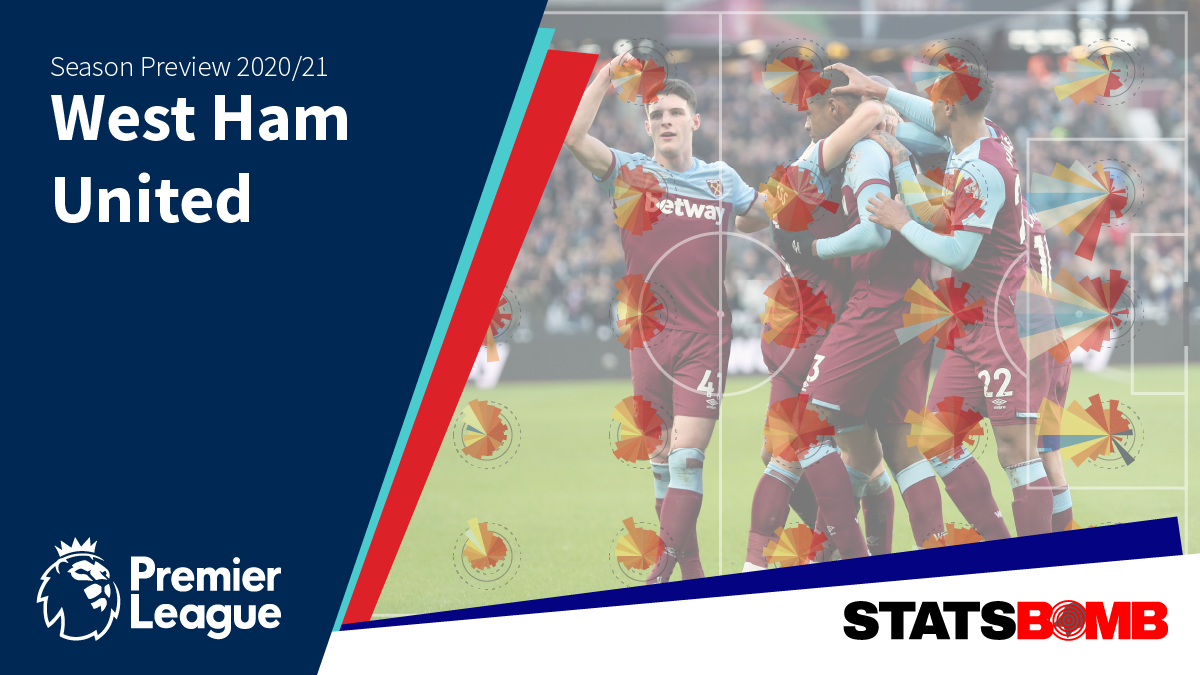
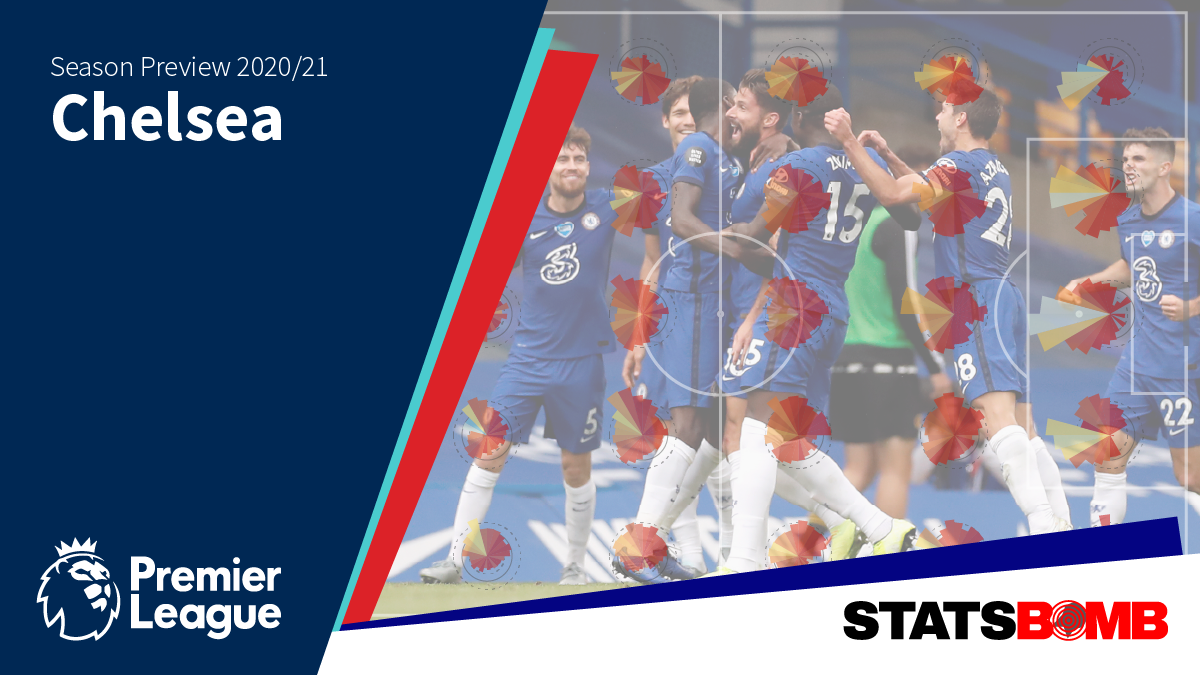
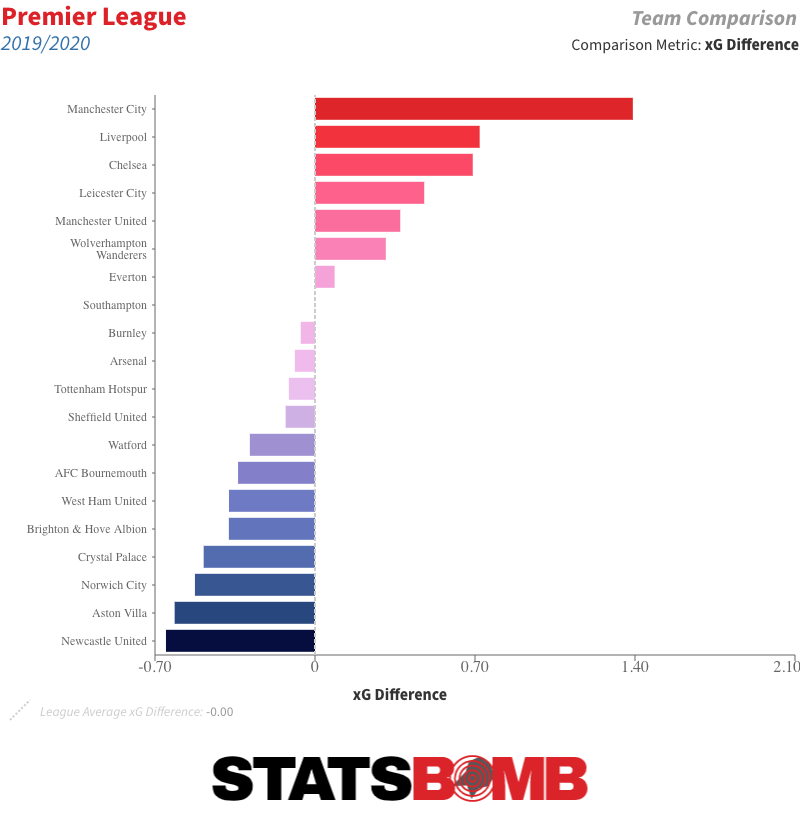 Chelsea regularly dominated the shot count. Only Manchester City took more than their 16.29 per match or conceded less than their 8.32 per match. The transitions forward were slightly quicker and more direct than under Sarri, and there was less of an overt focus on possession, although Lampard did continue the shift to a more aggressive high press.
Chelsea regularly dominated the shot count. Only Manchester City took more than their 16.29 per match or conceded less than their 8.32 per match. The transitions forward were slightly quicker and more direct than under Sarri, and there was less of an overt focus on possession, although Lampard did continue the shift to a more aggressive high press. 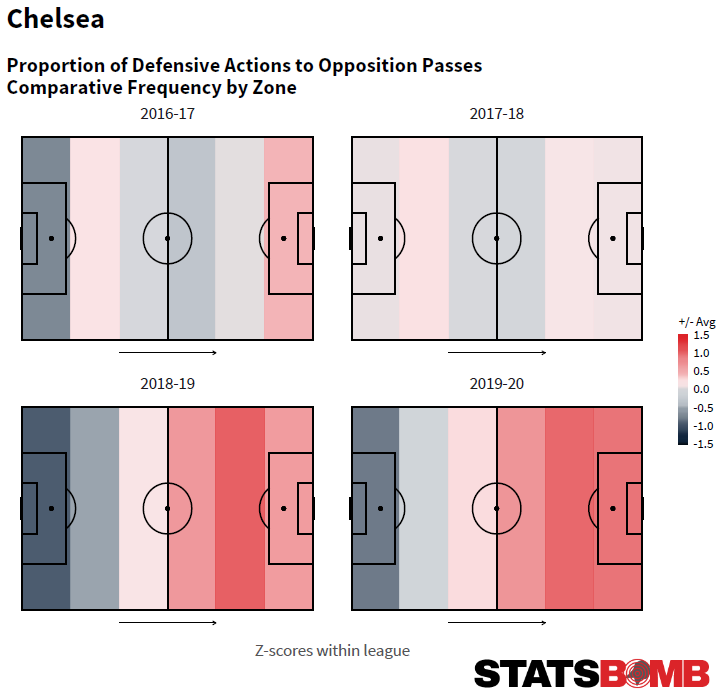 That was the main commonality with Lampard’s Derby team, who were also more aggressive in contesting possession high up the pitch than an average Championship side. Unlike at Derby, this approach was successful in suppressing opposition shot volume, but with the classic tradeoff: the average quality of the shots Chelsea conceded was amongst the highest in the league.
That was the main commonality with Lampard’s Derby team, who were also more aggressive in contesting possession high up the pitch than an average Championship side. Unlike at Derby, this approach was successful in suppressing opposition shot volume, but with the classic tradeoff: the average quality of the shots Chelsea conceded was amongst the highest in the league. 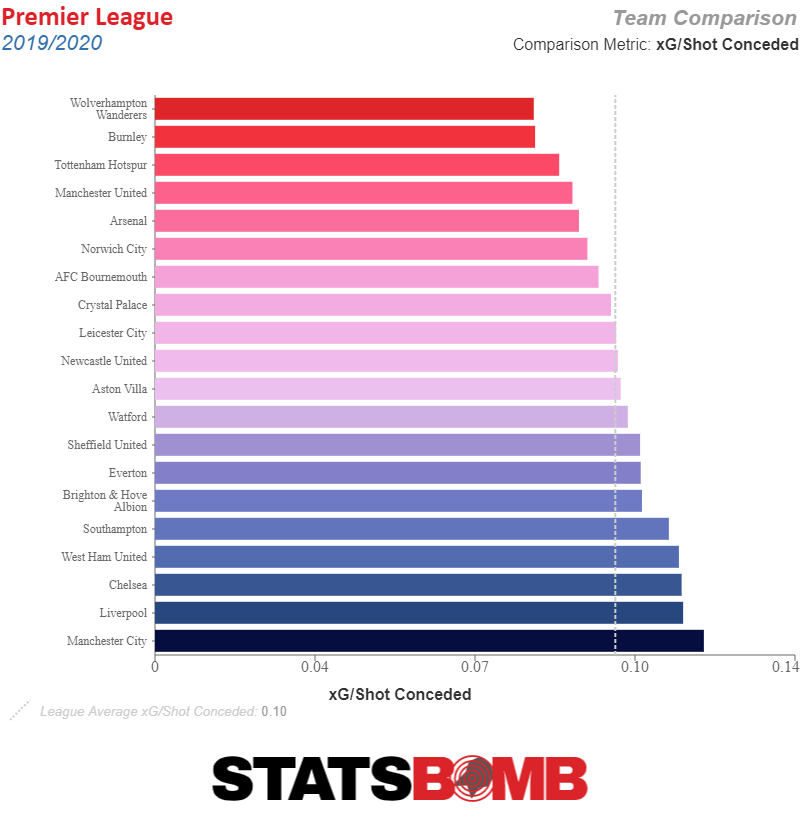 It was on the defensive side that Chelsea severely underperformed their metrics. They were about par in attack, scoring 62 non-penalty goals from 63.06 xG; in defence, they conceded 16 goals more than the expectation: 52 non-penalty goals from 36.03 xG.
It was on the defensive side that Chelsea severely underperformed their metrics. They were about par in attack, scoring 62 non-penalty goals from 63.06 xG; in defence, they conceded 16 goals more than the expectation: 52 non-penalty goals from 36.03 xG. 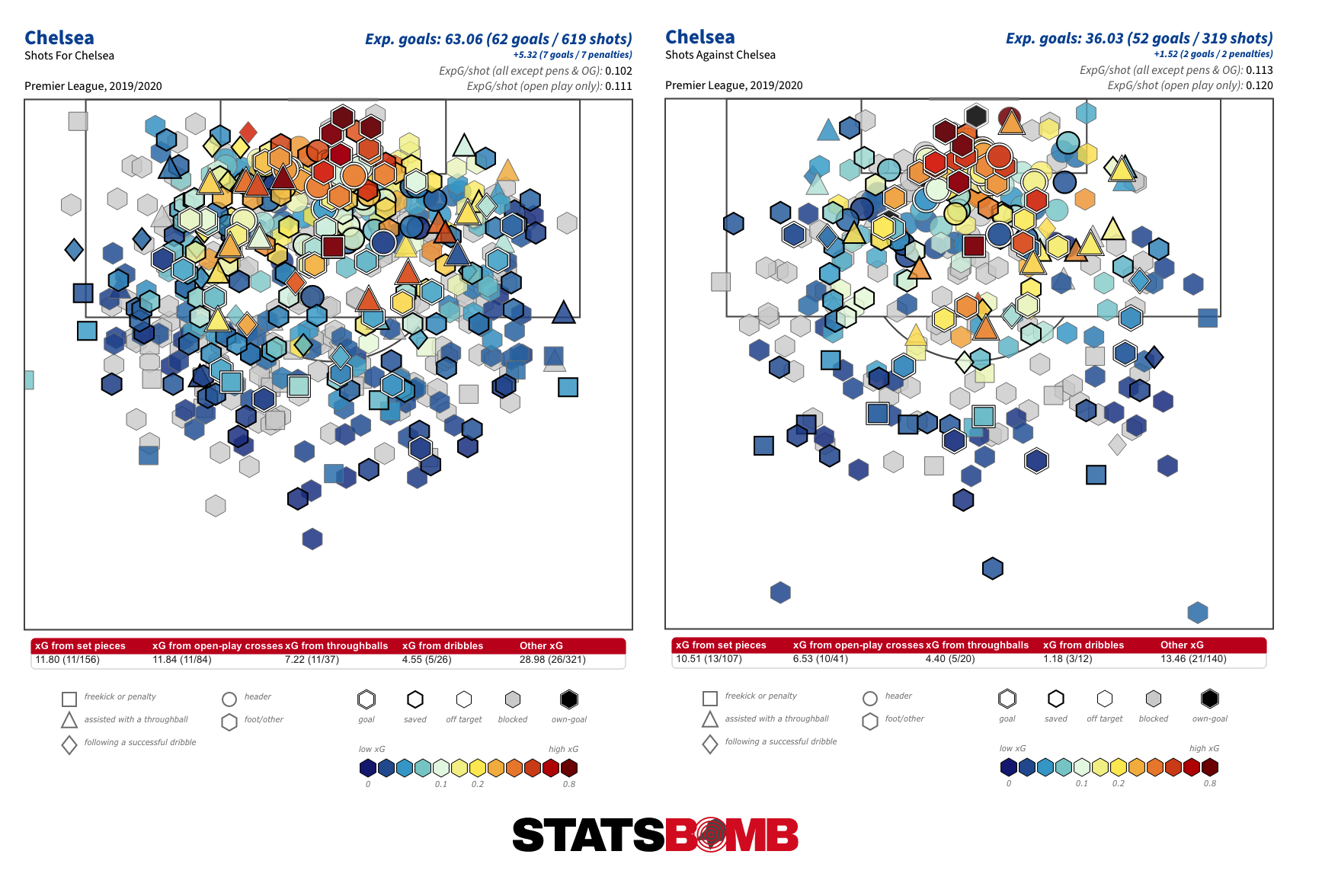 We’ve been
We’ve been 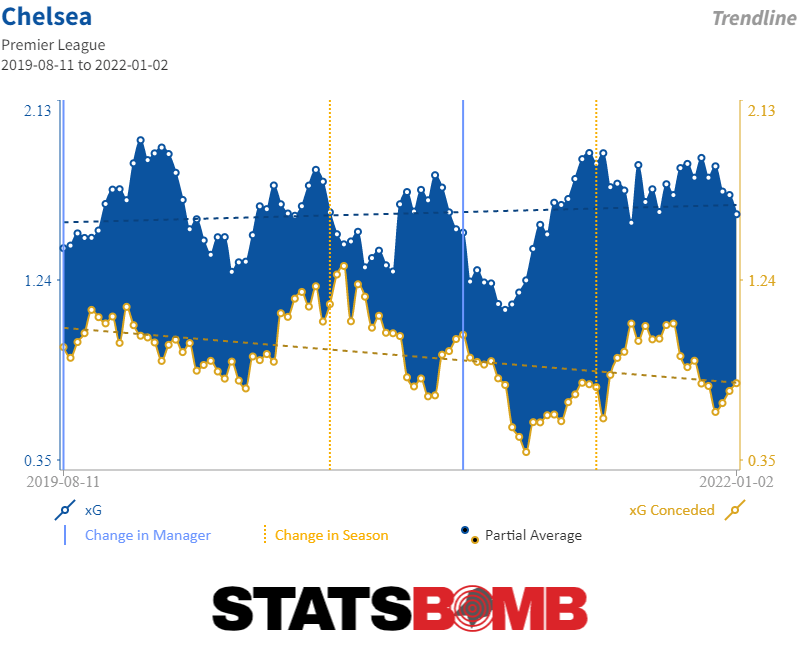 A small part of last season's difference can perhaps be assigned to set pieces, where Chelsea conceded 13 times (only two teams conceded more) from 10.51 xG. That is an area in which you'd usually expect to see most variation from the model. The tape does also suggest that they were pretty open in midfield. The previously bulletproof N’Golo Kanté missed 16 matches through injury, and covering large swathes of midfield territory in transition is not exactly Jorginho’s strongpoint. The backline was often left exposed, given impossibly large spaces to defend. Now, our xG model already includes goalkeeper and defender positioning, which is a huge help in determining how clear chances really are. Perhaps there is something on the margins of what the model picks up, like balance, relative body positioning, etc, that has made a small (and it would be small) contribution to the difference? Or maybe last season was just the latest episode in a particularly long run of bad luck in terms of opposition finishing? We won’t get a stable sample with which to test those theories because
A small part of last season's difference can perhaps be assigned to set pieces, where Chelsea conceded 13 times (only two teams conceded more) from 10.51 xG. That is an area in which you'd usually expect to see most variation from the model. The tape does also suggest that they were pretty open in midfield. The previously bulletproof N’Golo Kanté missed 16 matches through injury, and covering large swathes of midfield territory in transition is not exactly Jorginho’s strongpoint. The backline was often left exposed, given impossibly large spaces to defend. Now, our xG model already includes goalkeeper and defender positioning, which is a huge help in determining how clear chances really are. Perhaps there is something on the margins of what the model picks up, like balance, relative body positioning, etc, that has made a small (and it would be small) contribution to the difference? Or maybe last season was just the latest episode in a particularly long run of bad luck in terms of opposition finishing? We won’t get a stable sample with which to test those theories because 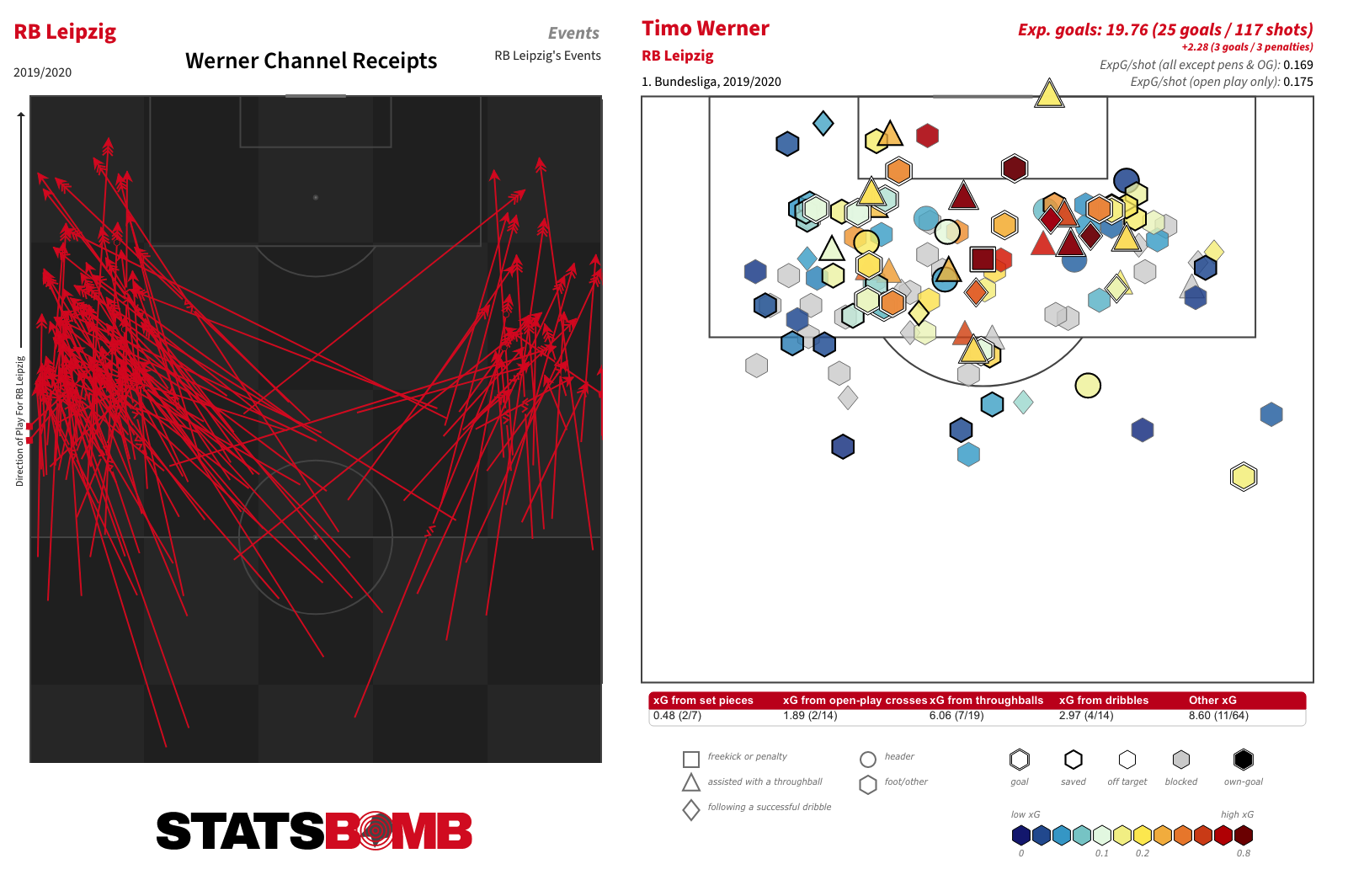 Hakim Ziyech is a high-usage, high risk/reward passer and shooter. You might think his high shot count last season (4.89 per 90) was conditioned by Ajax’s strength relative the rest of the Eredivisie, but he got off even more on their run to the final four of the 2018-19 Champions League. In fact, he’s always been a high volume shooter, even back to his Heerenveen and Twente days. How he’ll work out on a team who had a fairly equitable share of shots between their players last season remains to be seen.
Hakim Ziyech is a high-usage, high risk/reward passer and shooter. You might think his high shot count last season (4.89 per 90) was conditioned by Ajax’s strength relative the rest of the Eredivisie, but he got off even more on their run to the final four of the 2018-19 Champions League. In fact, he’s always been a high volume shooter, even back to his Heerenveen and Twente days. How he’ll work out on a team who had a fairly equitable share of shots between their players last season remains to be seen. 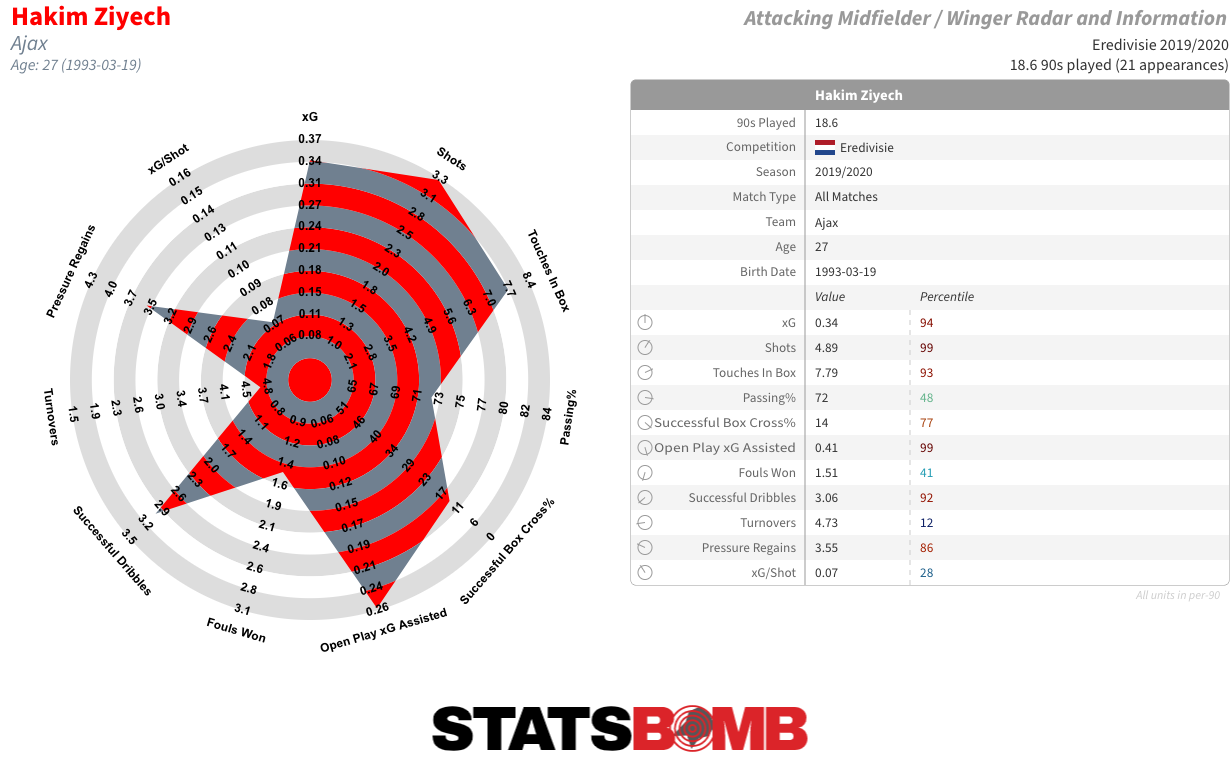 Havertz is a tall, skilled and deceptively quick player who fulfilled a variety of roles at Bayer Leverkusen last season. He saw minutes as a right winger, central attacking midfielder and even as a false nine. He provides both shot and creative output, tallying 11 goals and six assists from 14.61 xG and xG assisted last season, and might be ready to explode.
Havertz is a tall, skilled and deceptively quick player who fulfilled a variety of roles at Bayer Leverkusen last season. He saw minutes as a right winger, central attacking midfielder and even as a false nine. He provides both shot and creative output, tallying 11 goals and six assists from 14.61 xG and xG assisted last season, and might be ready to explode. 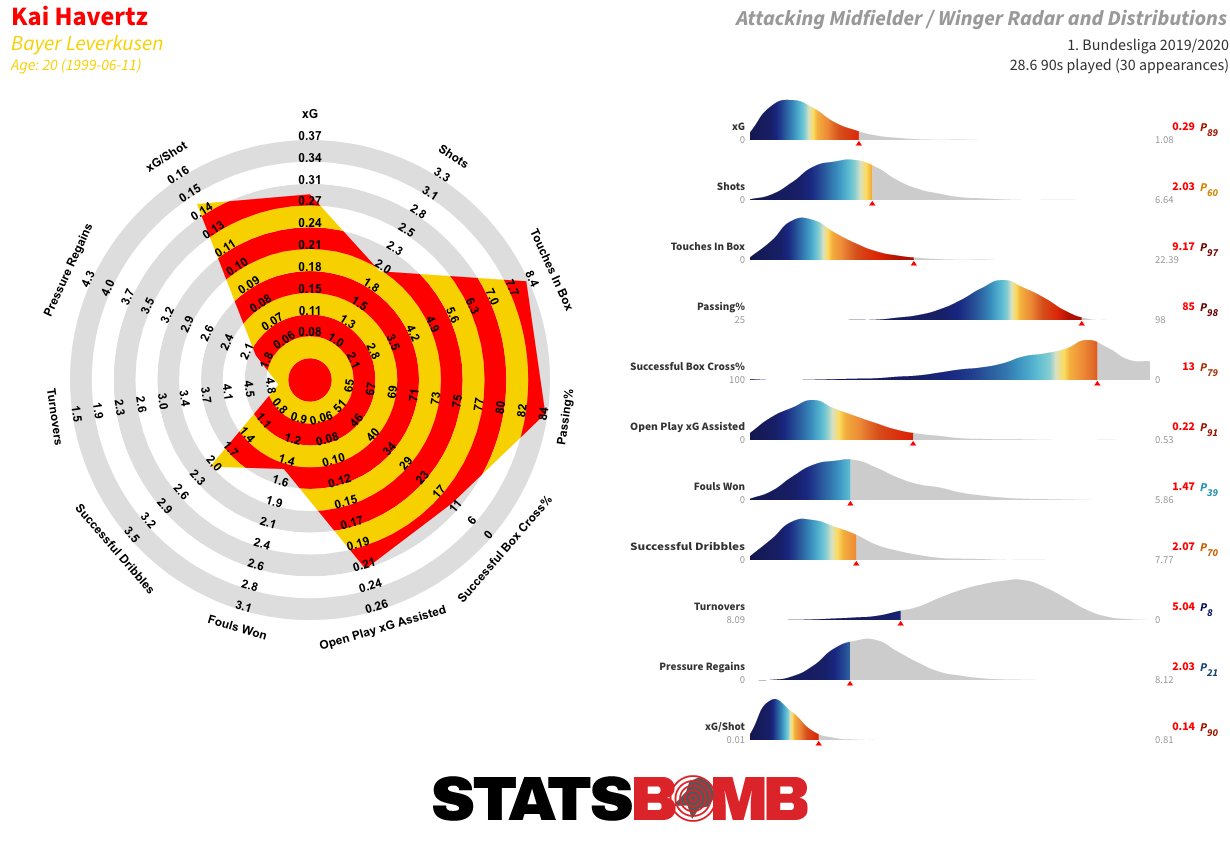 Those three will all have to fit in around Christian Pulisic, who produced over a goal or assist for every two matches he played in terms of both expected and actual output in his first season at the club. Lampard seemed hesitant to start him during the early part of the campaign, but he got two good runs of starts either side of his mid-season injury, and established himself as a key player down the final stretch. Lampard now has a superb set of options for the four forward-most positions, and there is enough wiggle room in their respective skillsets to fit them all together into a somewhat coherent system. There is also natural symmetry there, with Pulisic and Werner generally preferring to receive towards the left; Havertz and Ziyech, the right. Elsewhere, there is no replacement yet for Kepa nor a capable ball-winner in midfield. In addition to question marks over whether Lampard's system makes best use of Kanté's attributes, there may be concerns that last season’s fitness issues were the early signs of physical decline. The money spent in the final third might prove a little superfluous if those needs are not also addressed. There have been reinforcements in defence. Ben Chilwell is a good, solid Premier League full-back, better going forward than he is at defending. He's not a huge upgrade on what Chelsea already had on the left, but he is both homegrown and younger, which may be justification enough. He’ll likely be a relatively dependable performer, and he still has time to refine the defensive side of his game, but the feeling persists that they might have found someone a little more inspiring at that price point.
Those three will all have to fit in around Christian Pulisic, who produced over a goal or assist for every two matches he played in terms of both expected and actual output in his first season at the club. Lampard seemed hesitant to start him during the early part of the campaign, but he got two good runs of starts either side of his mid-season injury, and established himself as a key player down the final stretch. Lampard now has a superb set of options for the four forward-most positions, and there is enough wiggle room in their respective skillsets to fit them all together into a somewhat coherent system. There is also natural symmetry there, with Pulisic and Werner generally preferring to receive towards the left; Havertz and Ziyech, the right. Elsewhere, there is no replacement yet for Kepa nor a capable ball-winner in midfield. In addition to question marks over whether Lampard's system makes best use of Kanté's attributes, there may be concerns that last season’s fitness issues were the early signs of physical decline. The money spent in the final third might prove a little superfluous if those needs are not also addressed. There have been reinforcements in defence. Ben Chilwell is a good, solid Premier League full-back, better going forward than he is at defending. He's not a huge upgrade on what Chelsea already had on the left, but he is both homegrown and younger, which may be justification enough. He’ll likely be a relatively dependable performer, and he still has time to refine the defensive side of his game, but the feeling persists that they might have found someone a little more inspiring at that price point. 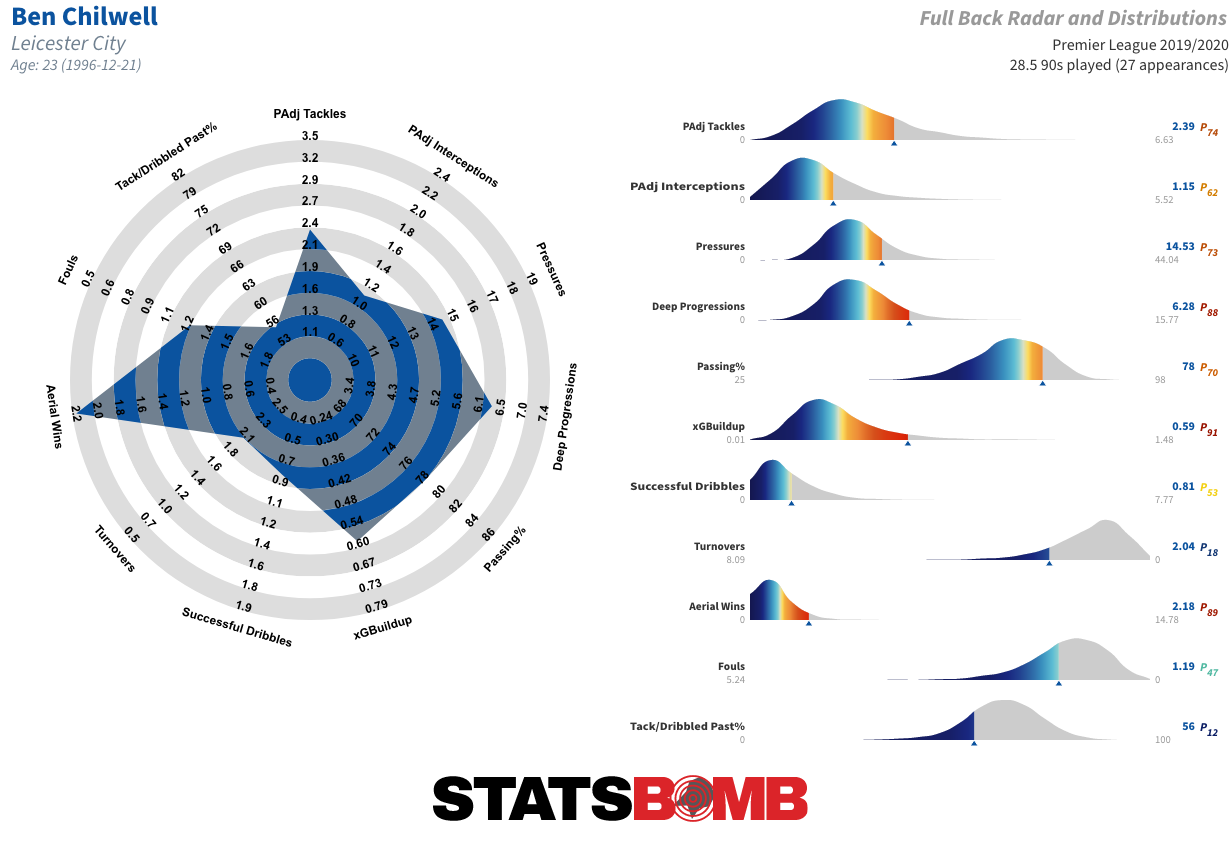 Thiago Silva obviously has great pedigree and even at this late stage of his career probably represents an improvement on last season’s starters. But at 35, soon to be 36, any physical decline is likely to be a bit more obvious at Chelsea than it was at PSG. Malang Sarr, another free transfer arrival, is an the opposite end of the age curve. Now 21, he's been a starter at Nice since he was 17. There are some suggestions he might be loaned out, and this could simply be Chelsea taking advantage of value in the market with an eye on future profit, but he seems to roughly fit the profile of what they might be looking for in a central defender. The incomings raise doubts over the future and development of some of the younger players who got good game time last season, particularly Callum Hudson-Odoi, who produced solid output when he made the pitch but never seemed to totally convince Lampard. It is also likely that Abraham and Mason Mount will see their minutes reduced. The enforced use of internal options has, though, had clear benefit. Chelsea now have good, first-hand information on a group of young players who, if nothing else, have had their market value raised by a year in the first team. So where should expectations be set for Chelsea this season? The points gap to Liverpool and Manchester City is probably too large to overcome in a single campaign, even if all of the new signings do immediately click, but the level of their spending suggests that reducing it will be the minimum requirement. A third-place finish seems the most likely outcome. If that isn't achieved, and previous problems also persist, Lampard's job may well be at risk.
Thiago Silva obviously has great pedigree and even at this late stage of his career probably represents an improvement on last season’s starters. But at 35, soon to be 36, any physical decline is likely to be a bit more obvious at Chelsea than it was at PSG. Malang Sarr, another free transfer arrival, is an the opposite end of the age curve. Now 21, he's been a starter at Nice since he was 17. There are some suggestions he might be loaned out, and this could simply be Chelsea taking advantage of value in the market with an eye on future profit, but he seems to roughly fit the profile of what they might be looking for in a central defender. The incomings raise doubts over the future and development of some of the younger players who got good game time last season, particularly Callum Hudson-Odoi, who produced solid output when he made the pitch but never seemed to totally convince Lampard. It is also likely that Abraham and Mason Mount will see their minutes reduced. The enforced use of internal options has, though, had clear benefit. Chelsea now have good, first-hand information on a group of young players who, if nothing else, have had their market value raised by a year in the first team. So where should expectations be set for Chelsea this season? The points gap to Liverpool and Manchester City is probably too large to overcome in a single campaign, even if all of the new signings do immediately click, but the level of their spending suggests that reducing it will be the minimum requirement. A third-place finish seems the most likely outcome. If that isn't achieved, and previous problems also persist, Lampard's job may well be at risk. 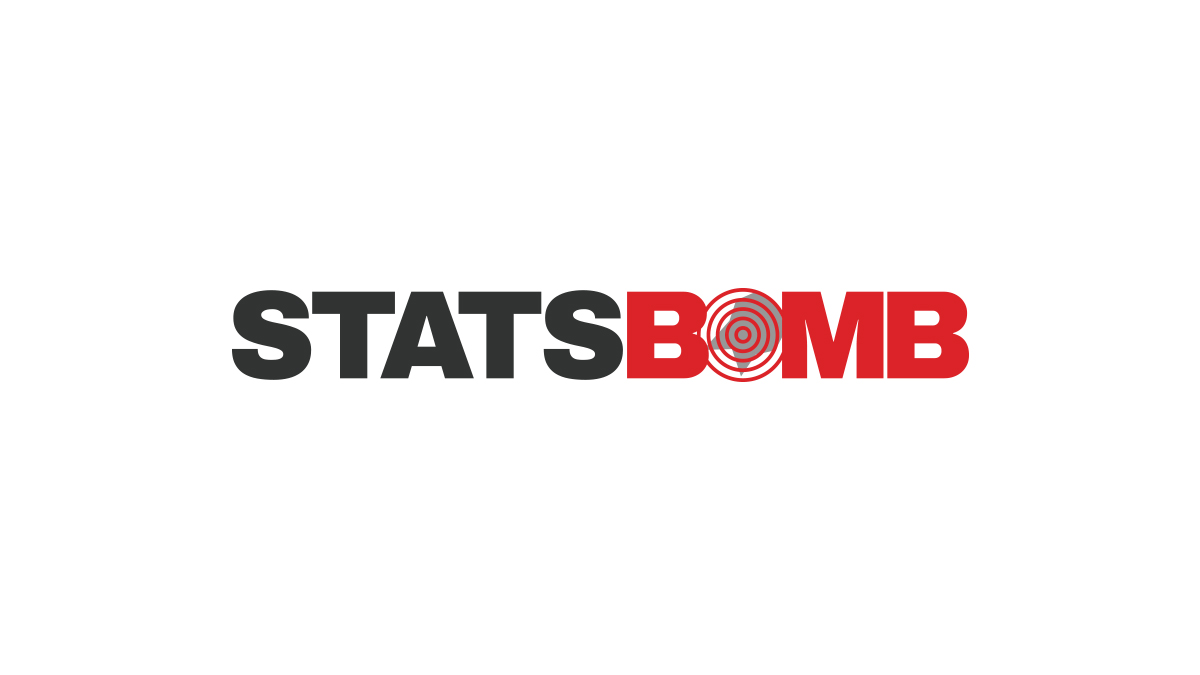

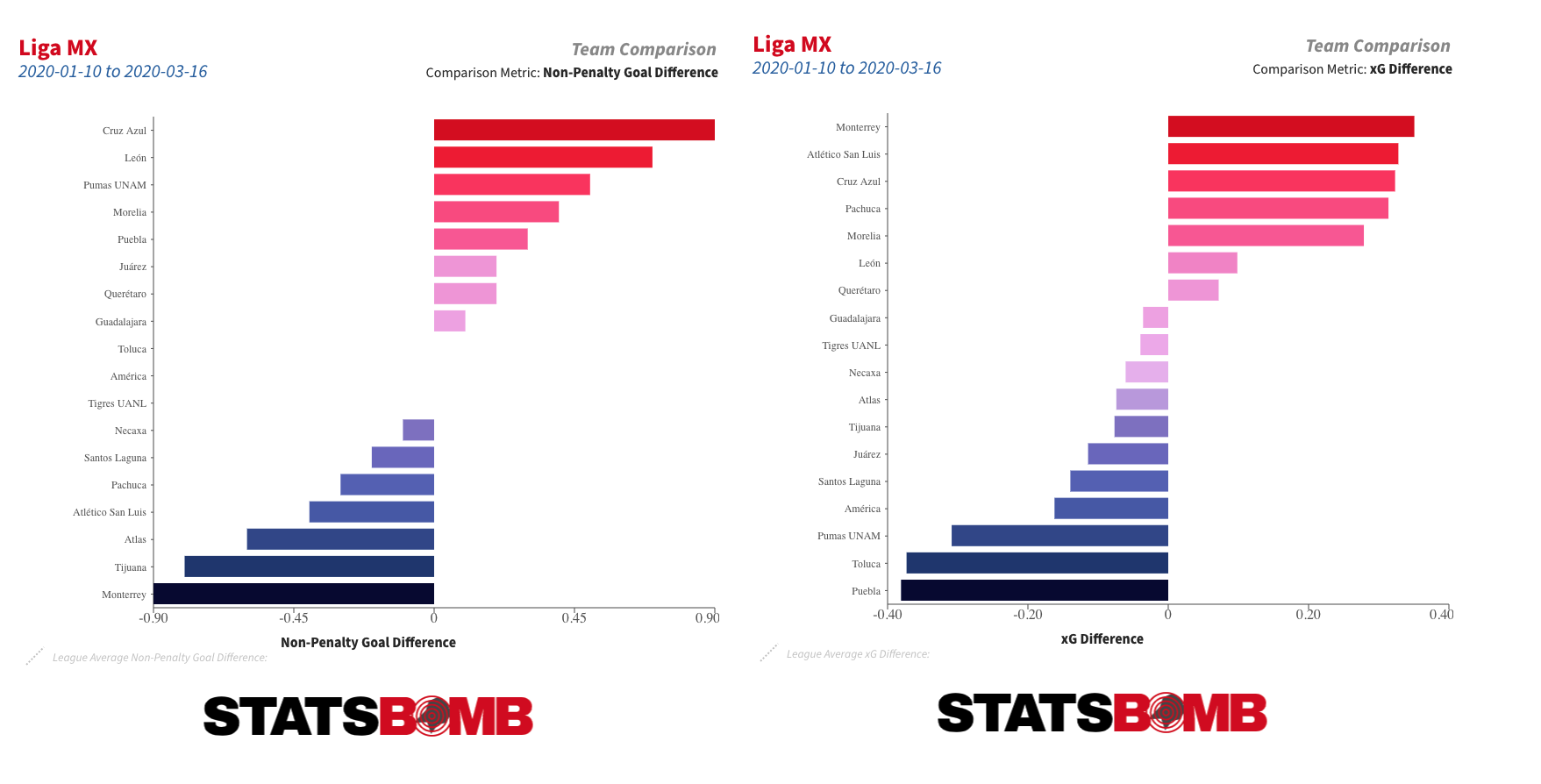 Over time, those kinds of things tend to even themselves out, and that is just as true the other way around. Over the full course of the 2019-20 season, no team outperformed their xG difference to the extent that Necaxa did, but even they started to drift back towards their underlying numbers during the Clausura.
Over time, those kinds of things tend to even themselves out, and that is just as true the other way around. Over the full course of the 2019-20 season, no team outperformed their xG difference to the extent that Necaxa did, but even they started to drift back towards their underlying numbers during the Clausura. 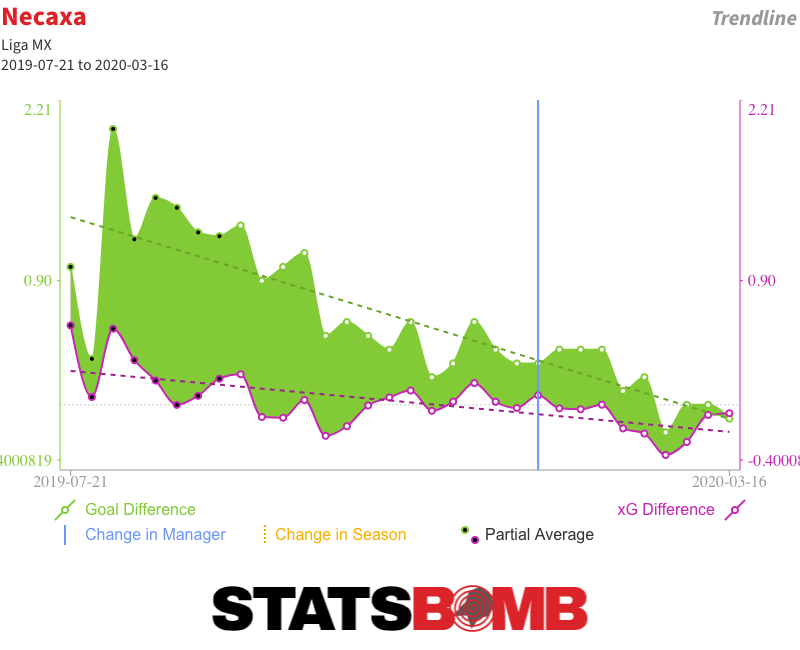 That should be of concern to teams like Puebla and Pumas. Both were in the playoff hunt during the aborted Clausura but had some of the league’s worst underlying numbers. León: The Throughball Masters On an outright basis, León had the best attack in Liga MX last season, and their expected goals tally was also up there with the league’s best. Yet their attack functioned very differently to those of the other high-scoring teams. They took a below league-average number of shots, but their average chance quality was far and away the best in the division.
That should be of concern to teams like Puebla and Pumas. Both were in the playoff hunt during the aborted Clausura but had some of the league’s worst underlying numbers. León: The Throughball Masters On an outright basis, León had the best attack in Liga MX last season, and their expected goals tally was also up there with the league’s best. Yet their attack functioned very differently to those of the other high-scoring teams. They took a below league-average number of shots, but their average chance quality was far and away the best in the division. 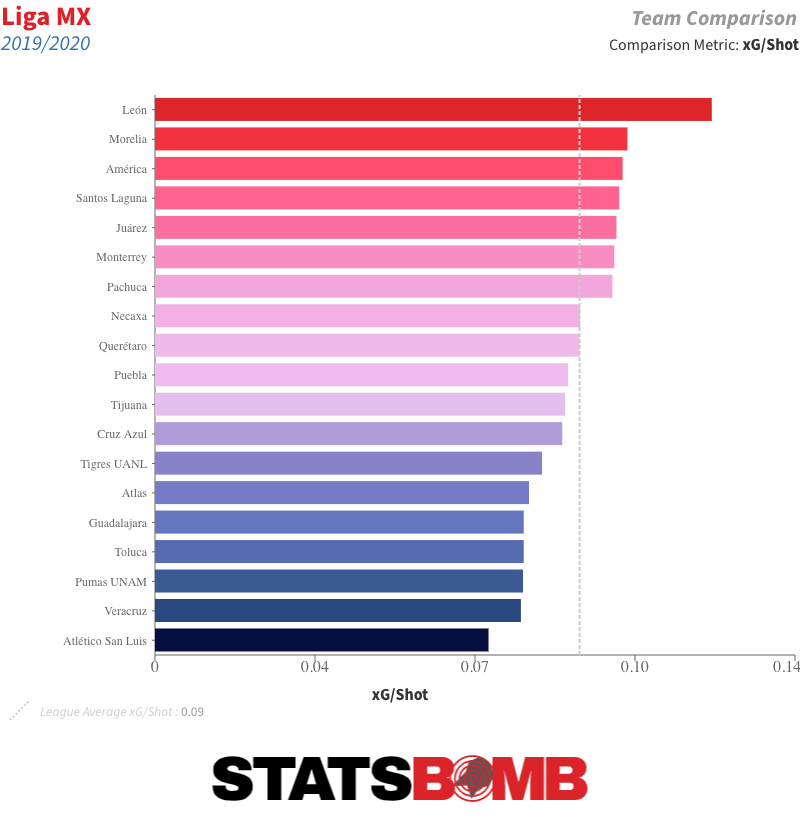 A look at their shot map provides us with a good idea as to why. See all those triangles? Those are shots from throughballs.
A look at their shot map provides us with a good idea as to why. See all those triangles? Those are shots from throughballs.  Let’s separate them out.
Let’s separate them out.  That is a lot of throughball shots -- 11 more than any other side, and almost twice as many on a proportional basis. Over 20% of León’s xG and goals came from them. Throughballs produce some of the highest quality chances in the game, and León create a ton of them. On an individual basis, the league’s top two throughball providers and four of the top five play for Léon: Luis Montes, Joel Campbell, Fernando Navarro and Pedro Aquino. You’ll also find Ángel Mena and Leonardo Ramos inside the top 15. So if you like yourself a good throughball, León are clearly the team to watch. On the opposite end of the scale, Chivas were the only team not to score a single goal from a throughball last season. Lopsided Attacks Last week, we had a look at the most lopsided attacks across the major European leagues, and the same general trends we saw there hold in Liga MX. Teams take a marginally higher percentage of their shots, generate a marginally higher percentage of their xG and score a marginally higher percentage of their goals from the left than the right. As in the major European leagues, shots from the centre account for around 75% of the goals. In the 2019-20 season, Puebla were the team with the biggest swing to one side in terms of the proportion of shots from the left and right that were taken from each side. They took 59.42% of those shots from the left:
That is a lot of throughball shots -- 11 more than any other side, and almost twice as many on a proportional basis. Over 20% of León’s xG and goals came from them. Throughballs produce some of the highest quality chances in the game, and León create a ton of them. On an individual basis, the league’s top two throughball providers and four of the top five play for Léon: Luis Montes, Joel Campbell, Fernando Navarro and Pedro Aquino. You’ll also find Ángel Mena and Leonardo Ramos inside the top 15. So if you like yourself a good throughball, León are clearly the team to watch. On the opposite end of the scale, Chivas were the only team not to score a single goal from a throughball last season. Lopsided Attacks Last week, we had a look at the most lopsided attacks across the major European leagues, and the same general trends we saw there hold in Liga MX. Teams take a marginally higher percentage of their shots, generate a marginally higher percentage of their xG and score a marginally higher percentage of their goals from the left than the right. As in the major European leagues, shots from the centre account for around 75% of the goals. In the 2019-20 season, Puebla were the team with the biggest swing to one side in terms of the proportion of shots from the left and right that were taken from each side. They took 59.42% of those shots from the left: 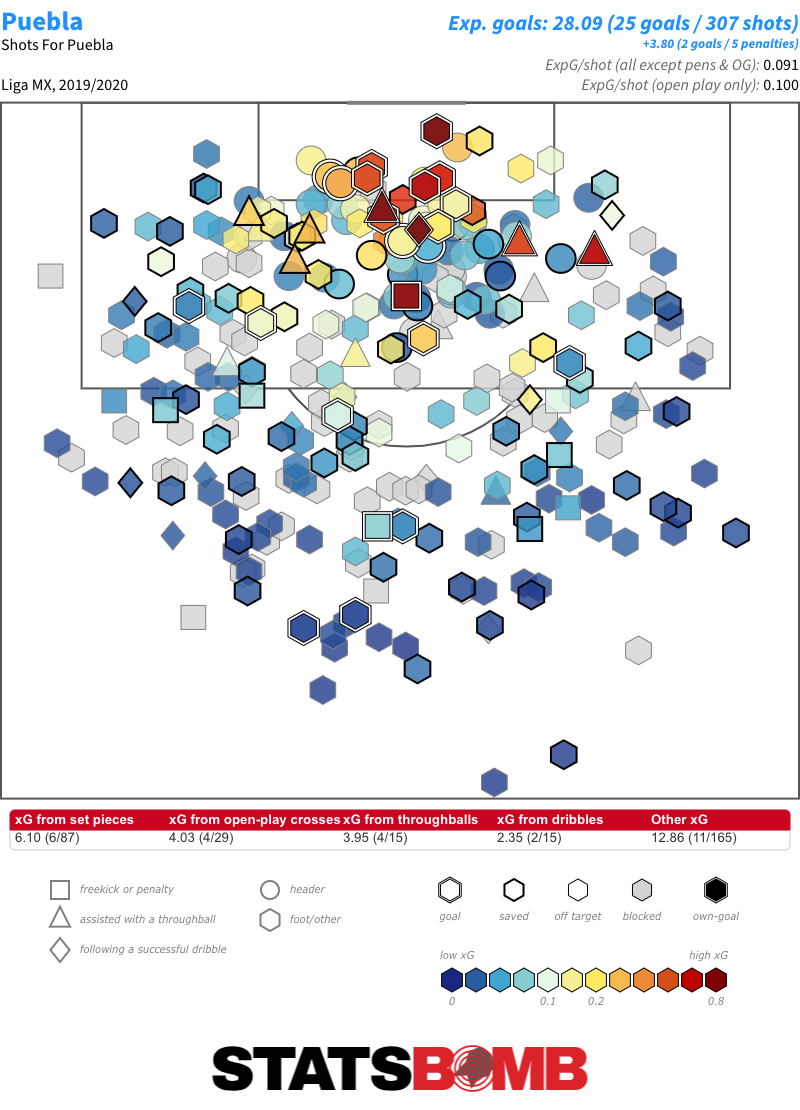 In terms of goals, no team were as lopsided as Necaxa, who scored nearly a quarter of their goals from the right, but only 5.66% from the left. Defensive Styles This graphic shows how each team’s proportion of defensive actions, including StatsBomb’s exclusive pressure data, to opposition passes compares with the league average in each of six vertical zones. The red tones indicate that the team completed an above-average proportion of defensive actions in that zone.
In terms of goals, no team were as lopsided as Necaxa, who scored nearly a quarter of their goals from the right, but only 5.66% from the left. Defensive Styles This graphic shows how each team’s proportion of defensive actions, including StatsBomb’s exclusive pressure data, to opposition passes compares with the league average in each of six vertical zones. The red tones indicate that the team completed an above-average proportion of defensive actions in that zone. 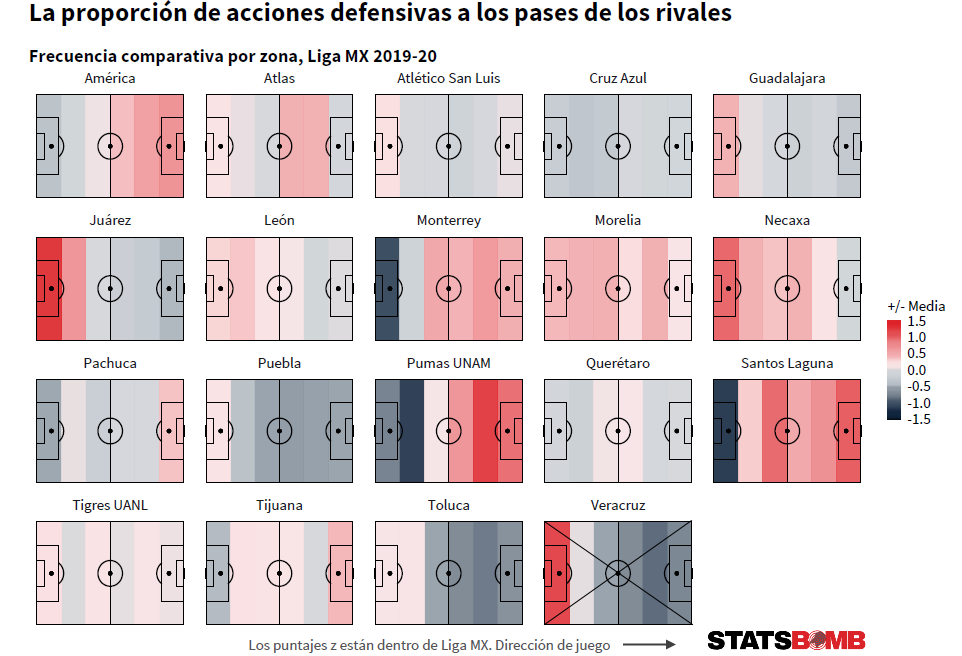 Through this, we can identify groupings of teams with similar defensive styles. If you like proactive teams that defend high up the pitch then Monterrey, Pumas or Santos Laguna might be to your liking. If teams who primarily defend in their own defensive third are your thing then Chivas, Juárez or Toluca might be the ticket. If you’re looking for ones who are pretty much averagely proactive all across the pitch there is always León or Tigres. There is a style for every taste. Talented Young Forwards There were five young forwards, aged 21 or under, who saw at least 900 minutes of action over the course of the truncated 2019-20 season. In order of their combined expected goals and expected goals assisted contribution per 90 minutes, lowest to highest: Diego Abella (Puebla), Germán Berterame (San Luis), José Macías (León/Chivas), Adrián Lozano (Santos Laguna) and Federico Viñas (América). The top two, Lozano and Viñas, have quite different profiles. Lozano is a creator who also posts up solid shot volume; Viñas is an out and out, penalty box centre-forward.
Through this, we can identify groupings of teams with similar defensive styles. If you like proactive teams that defend high up the pitch then Monterrey, Pumas or Santos Laguna might be to your liking. If teams who primarily defend in their own defensive third are your thing then Chivas, Juárez or Toluca might be the ticket. If you’re looking for ones who are pretty much averagely proactive all across the pitch there is always León or Tigres. There is a style for every taste. Talented Young Forwards There were five young forwards, aged 21 or under, who saw at least 900 minutes of action over the course of the truncated 2019-20 season. In order of their combined expected goals and expected goals assisted contribution per 90 minutes, lowest to highest: Diego Abella (Puebla), Germán Berterame (San Luis), José Macías (León/Chivas), Adrián Lozano (Santos Laguna) and Federico Viñas (América). The top two, Lozano and Viñas, have quite different profiles. Lozano is a creator who also posts up solid shot volume; Viñas is an out and out, penalty box centre-forward. 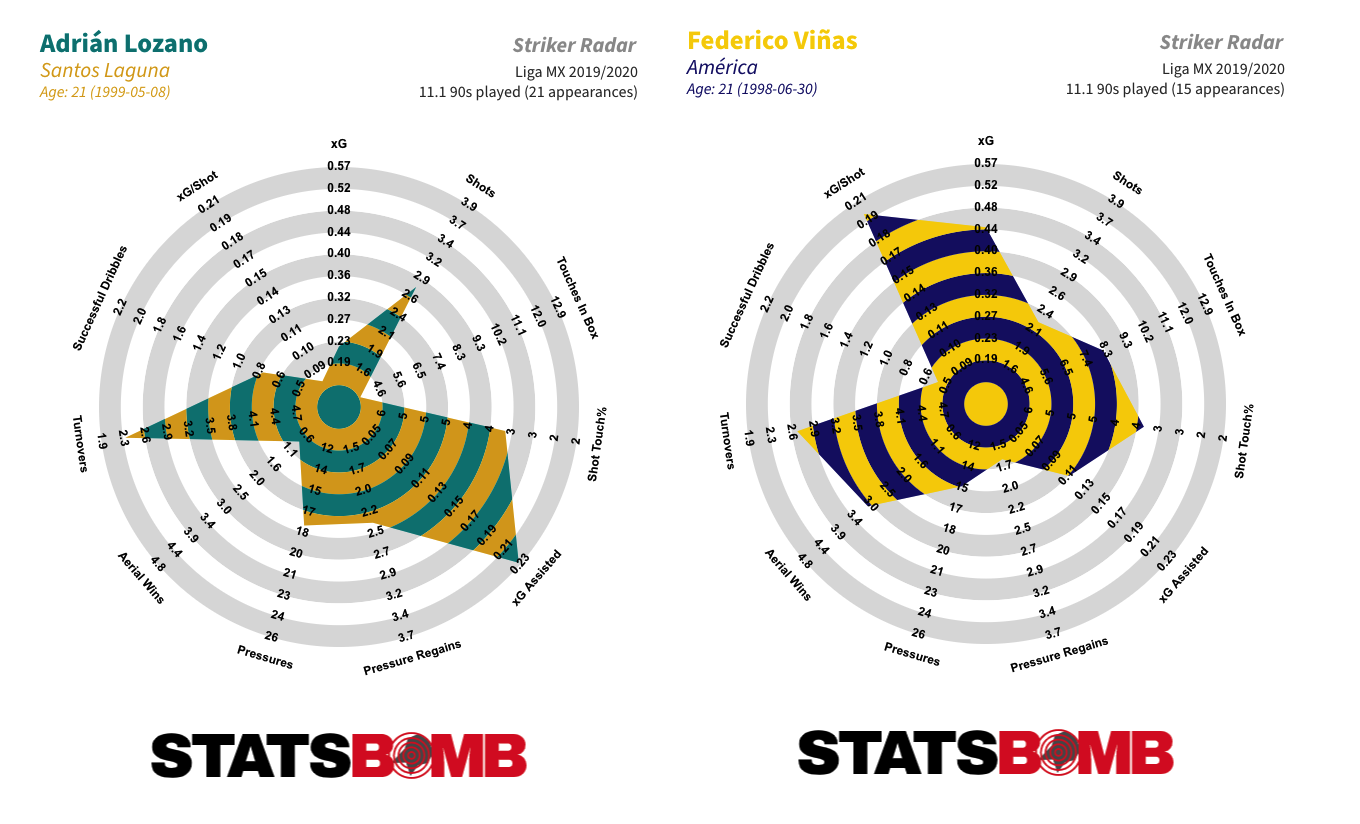 Viñas over-performed his xG tally through the 2019-20 season, converting him into the highest scorer, on a per 90 basis, in the league amongst all players who played at least 900 minutes. But even his xG figure was the second best in the league on that basis.
Viñas over-performed his xG tally through the 2019-20 season, converting him into the highest scorer, on a per 90 basis, in the league amongst all players who played at least 900 minutes. But even his xG figure was the second best in the league on that basis.  Macías is an interesting case. He put up solid numbers at León in the first half of the season (his goal tally was significantly inflated by the five penalties he converted) but then really kicked things up a notch upon returning to his parent club Chivas in January. The question now is if he can maintain that output over a larger sample size.
Macías is an interesting case. He put up solid numbers at León in the first half of the season (his goal tally was significantly inflated by the five penalties he converted) but then really kicked things up a notch upon returning to his parent club Chivas in January. The question now is if he can maintain that output over a larger sample size.  One and Two-Footed Players One of the unique features of the
One and Two-Footed Players One of the unique features of the 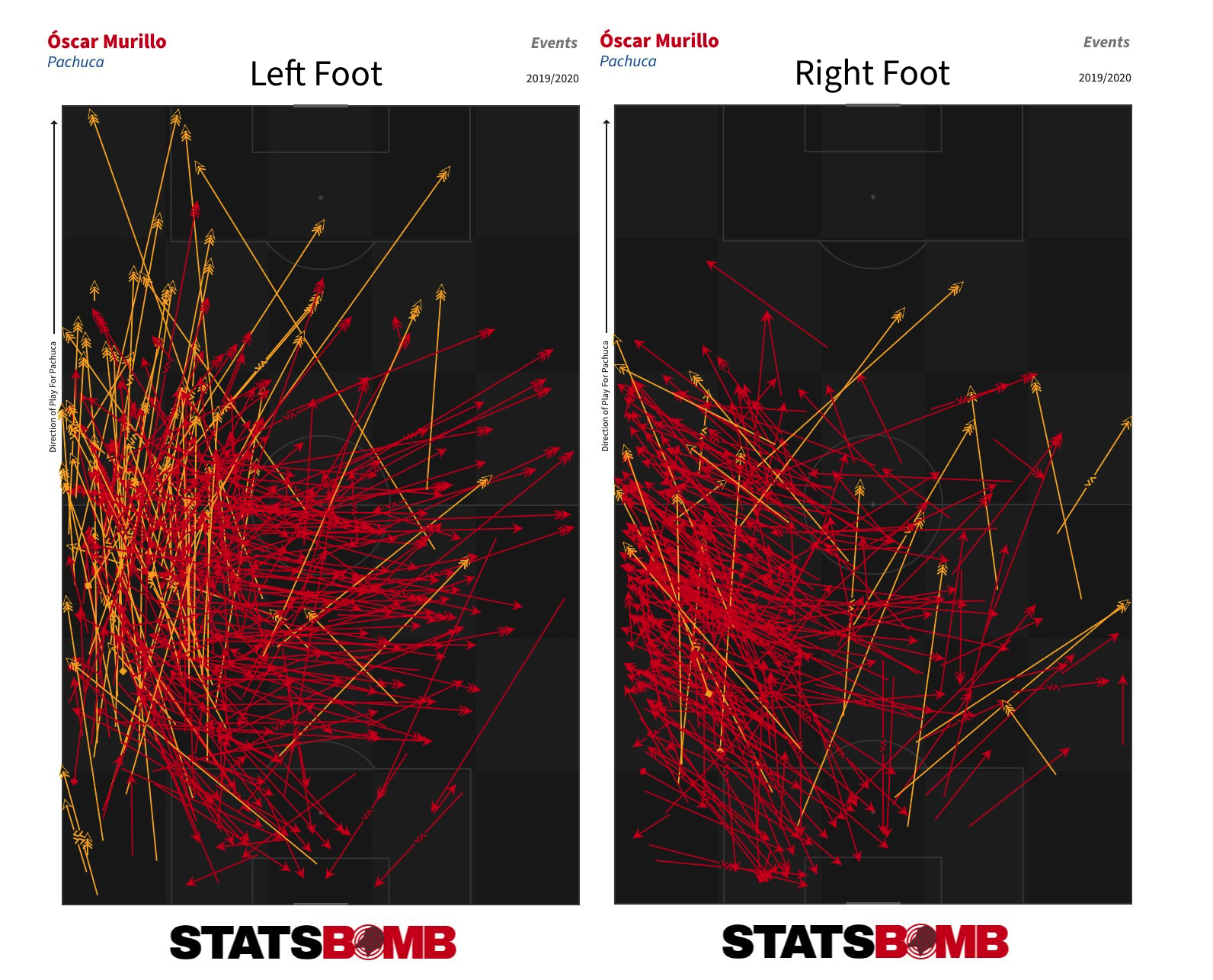 Leonardo Ramos of León and Puebla’s Abella were next up. But who was the least ambidextrous player? Jaime Gómez of Querétaro, who attempted 97% of his passes with his right foot. His teammate Ayron del Valle and León’s Miguel Herrera (now of Pachuca) showed similar skews to their favoured feet. More Stats of Interest If dribblers are your thing, Querétaro were the team to watch last season. Jeison Lucumí and Fabián Castillo were the top two in Liga MX in terms of both attempted and completed dribbles.
Leonardo Ramos of León and Puebla’s Abella were next up. But who was the least ambidextrous player? Jaime Gómez of Querétaro, who attempted 97% of his passes with his right foot. His teammate Ayron del Valle and León’s Miguel Herrera (now of Pachuca) showed similar skews to their favoured feet. More Stats of Interest If dribblers are your thing, Querétaro were the team to watch last season. Jeison Lucumí and Fabián Castillo were the top two in Liga MX in terms of both attempted and completed dribbles. 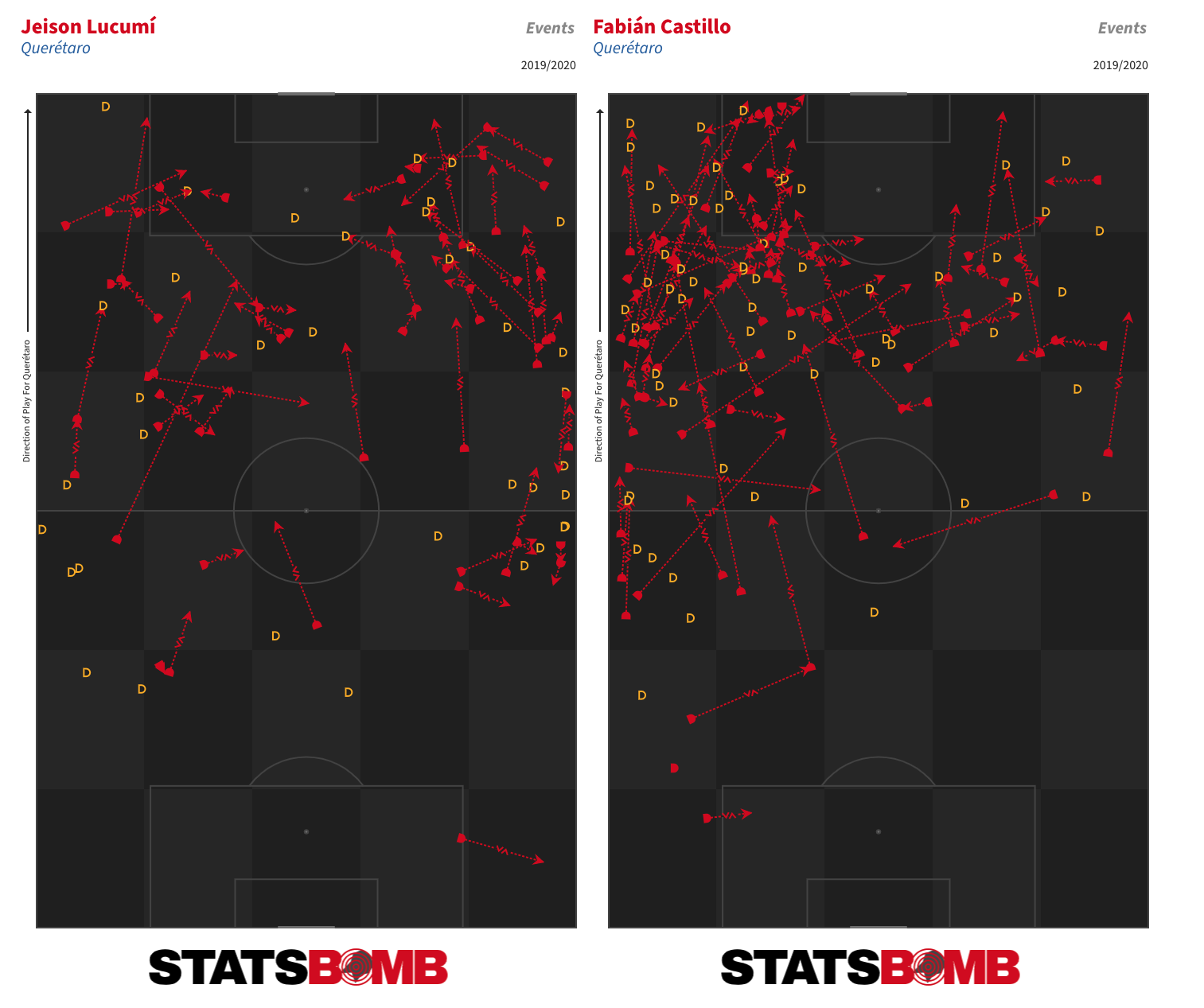 Fernando Gorriarán had the dubious honour of taking the highest number of shots without scoring (46) in Liga MX last season, but the Santos Laguna midfielder was also one of the most defensively active players in the league. Only Luis Quiñones of Tigres and León’s Aquino got through more combined interceptions, pressures and tackles than the Uruguayan on a possession-adjusted basis.
Fernando Gorriarán had the dubious honour of taking the highest number of shots without scoring (46) in Liga MX last season, but the Santos Laguna midfielder was also one of the most defensively active players in the league. Only Luis Quiñones of Tigres and León’s Aquino got through more combined interceptions, pressures and tackles than the Uruguayan on a possession-adjusted basis.  Rodrigo Noya didn’t react well to being pressed last season. The pass completion rate of the Nexaca central defender dropped from 81% in all situations to 57% when he was put under pressure -- a drop of 26 percentage points than was the highest in the league amongst all outfield players who attempted at least 20 passes per 90.
Rodrigo Noya didn’t react well to being pressed last season. The pass completion rate of the Nexaca central defender dropped from 81% in all situations to 57% when he was put under pressure -- a drop of 26 percentage points than was the highest in the league amongst all outfield players who attempted at least 20 passes per 90. 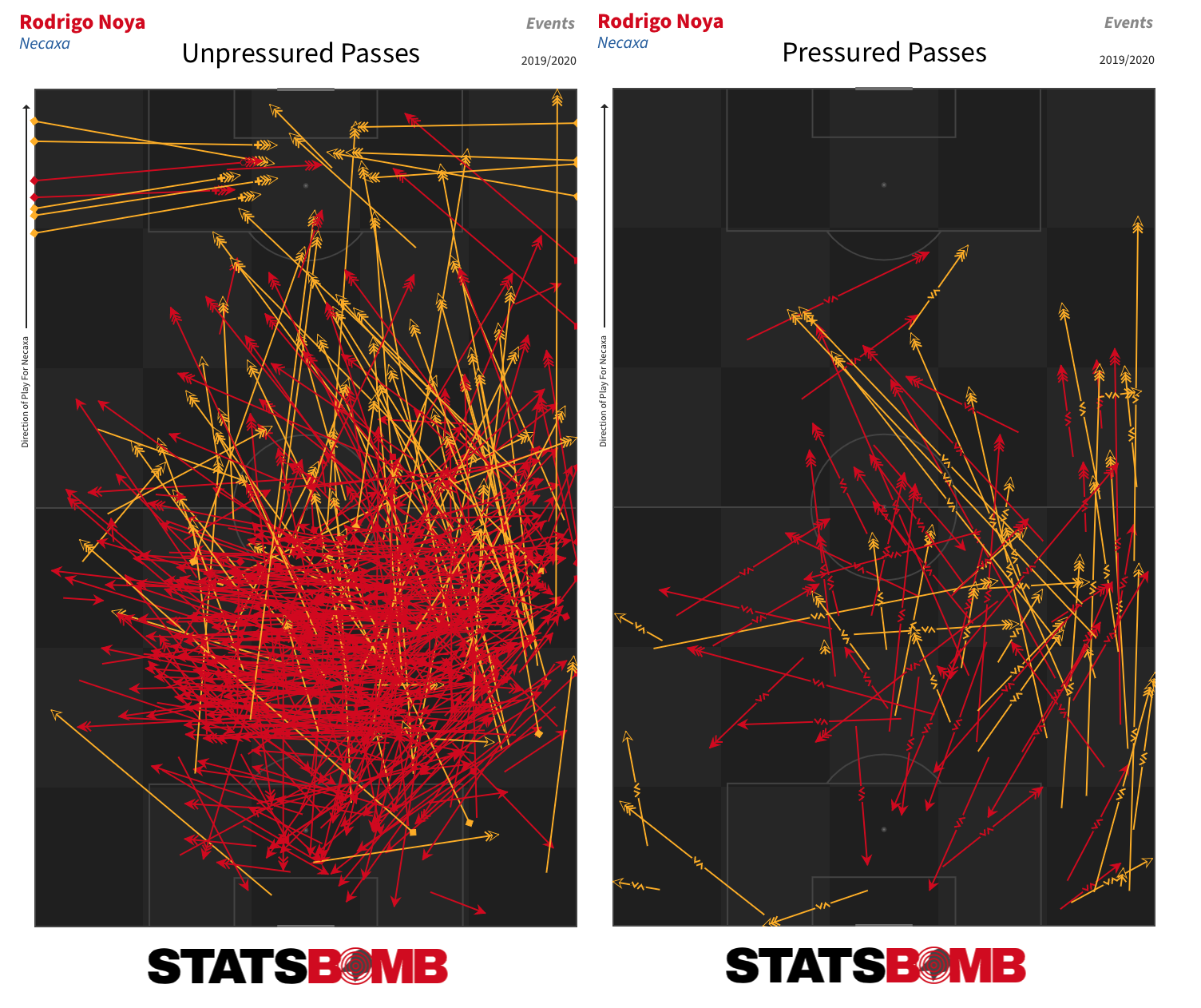 Finally, it was quite clear which teams did the best job of generating chances and goals from set pieces in the 2019-20 season. Cruz Azul, Monterrey, Pumas and Santos Laguna filled the top four places in terms of both set piece xG and set piece goals.
Finally, it was quite clear which teams did the best job of generating chances and goals from set pieces in the 2019-20 season. Cruz Azul, Monterrey, Pumas and Santos Laguna filled the top four places in terms of both set piece xG and set piece goals. 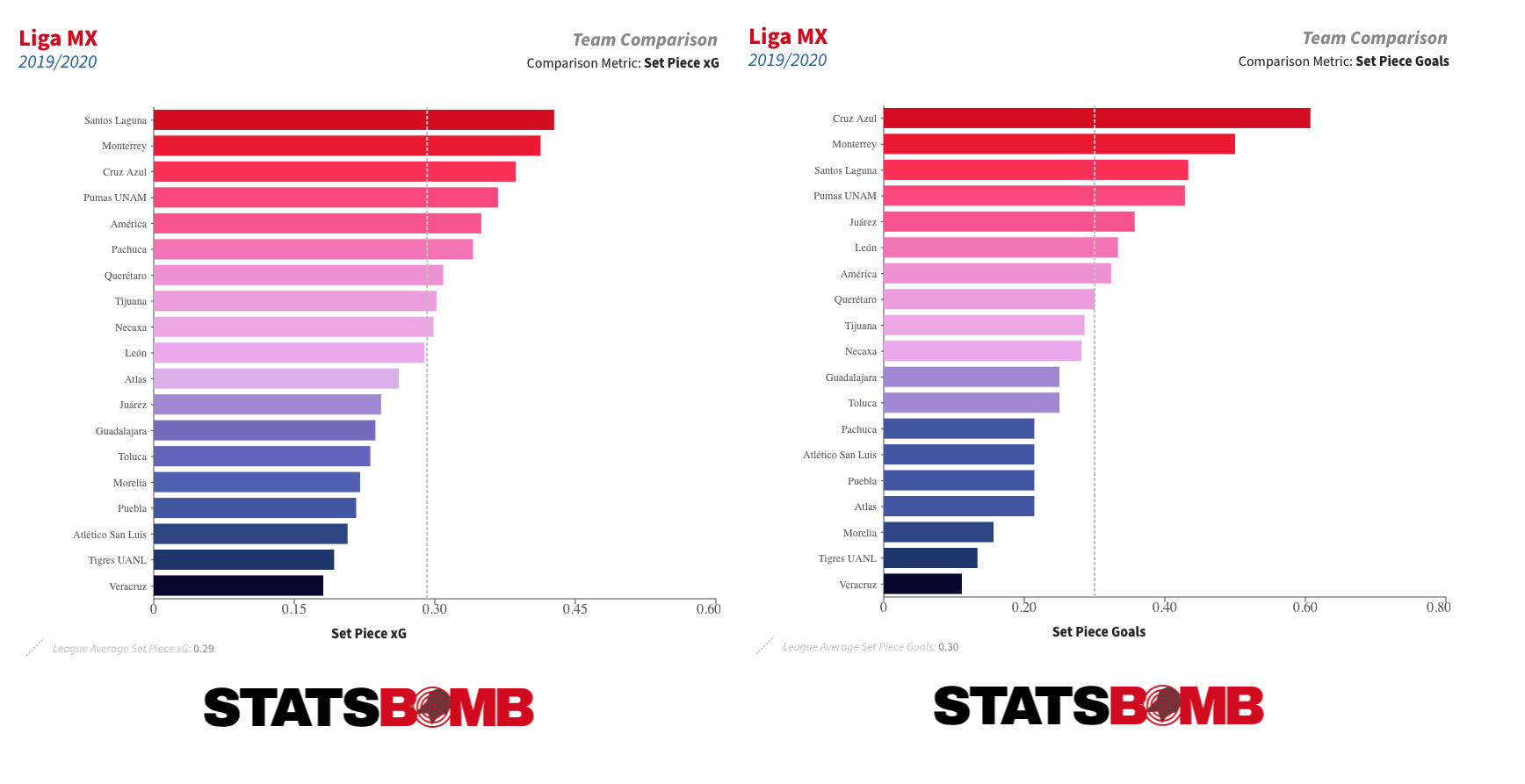
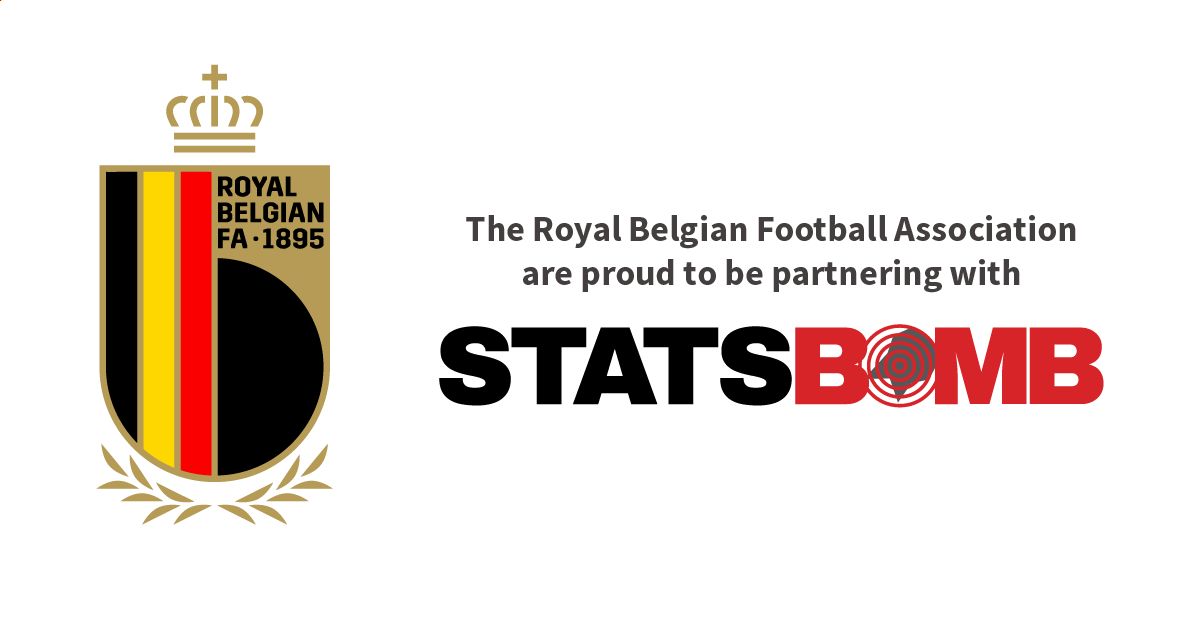
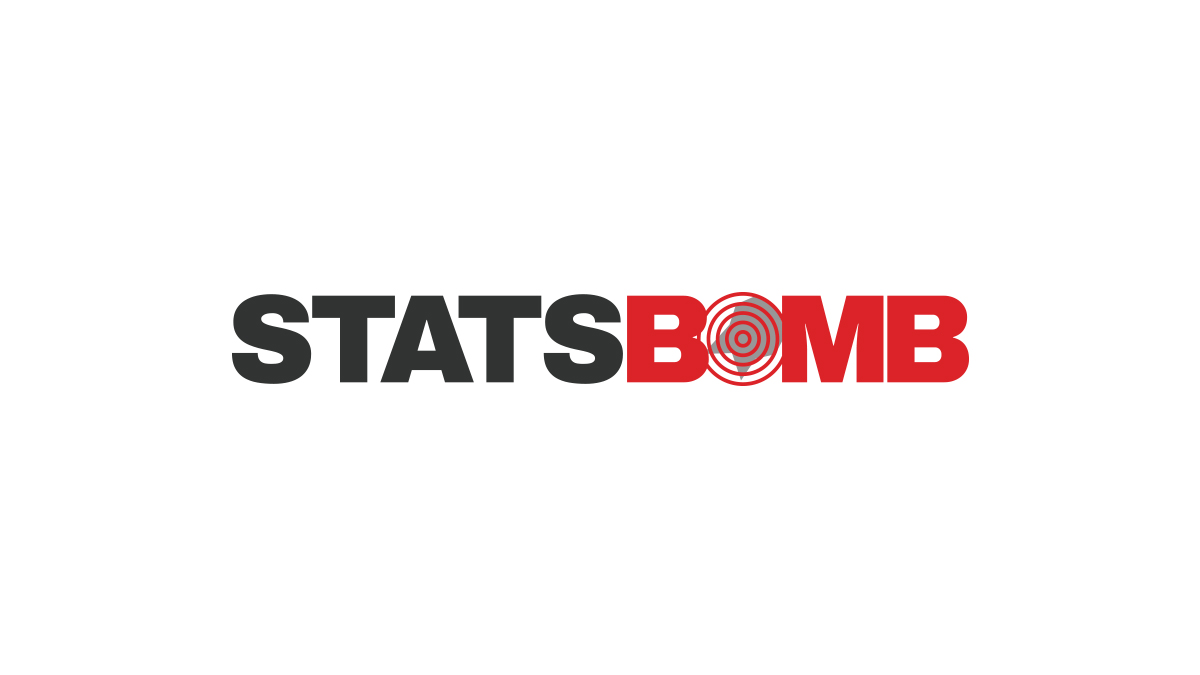
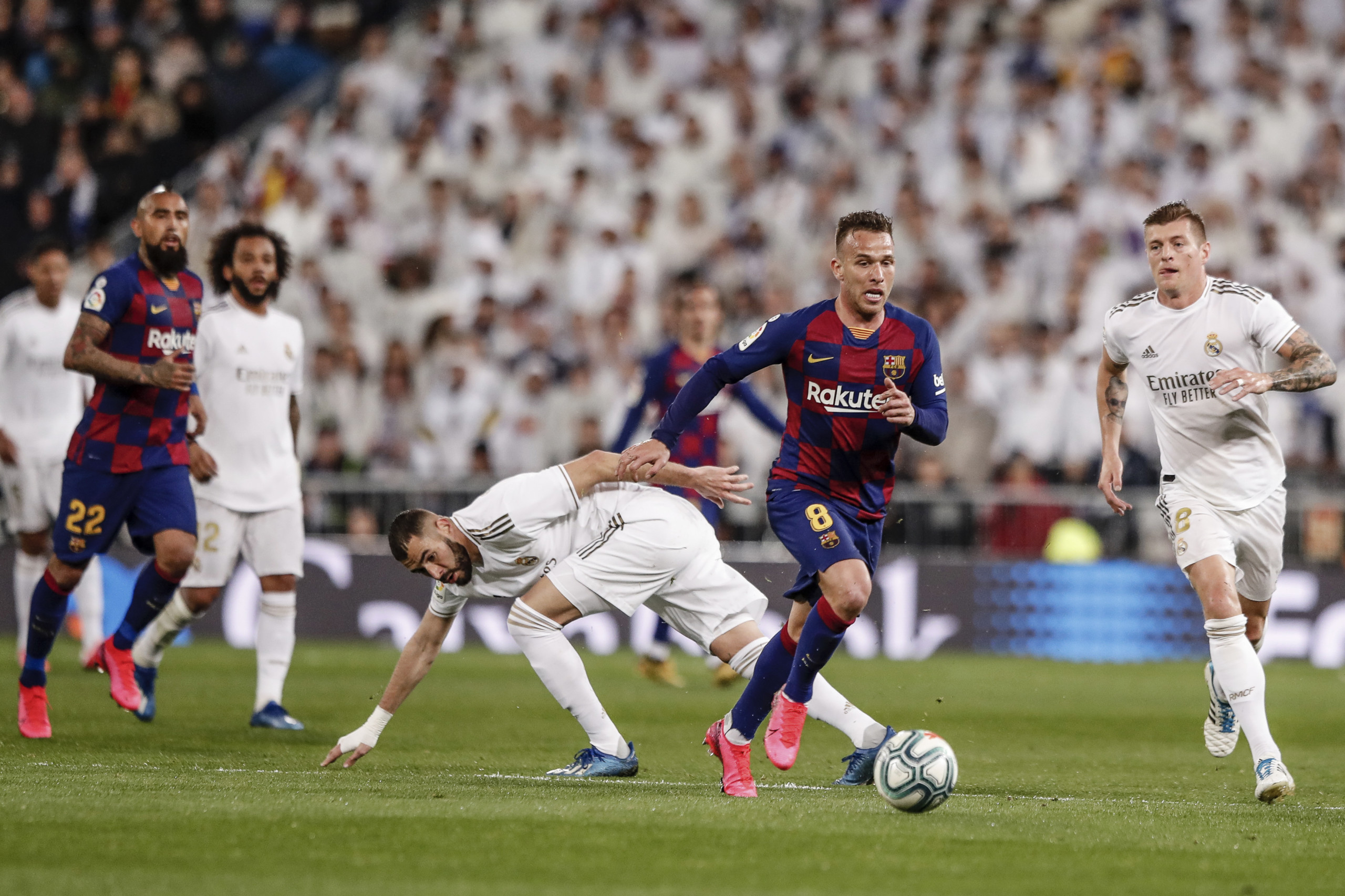
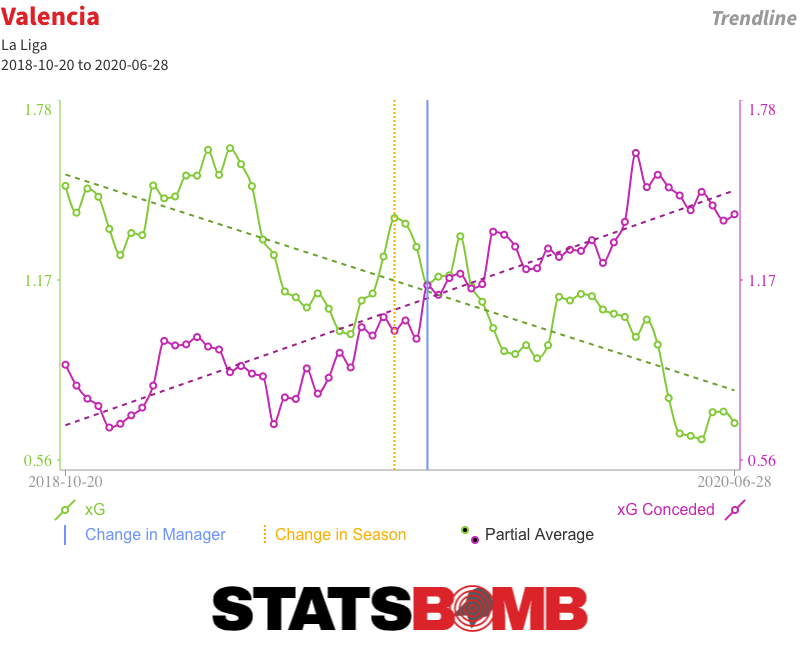 Until recently, Valencia’s results since Albert Celades replaced Marcelino back in mid-September were pretty good. When the league was paused in March, they were seventh in the table, just four points shy of the top four. But the underlying numbers always told a different story, one that results since the restart more accurately reflect. Three defeats in four left Valencia eight points off the top four and Celades without a job. We don’t even really need to dig as deep as expected goals to understand how bad Valencia were under Celades. They took just 8.28 shots per match, the second-lowest tally in the league, and matched that to a league-worst 15.52 conceded. It doesn’t take a genius to work out that giving up seven more shots than you take each week isn’t exactly a formula for sustained success. Back in the days when Total Shots Ratio ruled the analytics roost, we’d probably have considered any team with a shot share of 40% or less to be pretty bad; Valencia under Celades had just a 35% share. If we bring xG into the equation, their average shot quality was better than the quality of those they conceded, but the difference was nowhere near big enough to balance such a large disparity in shot volume. They combined the fourth-lowest xG per match (0.89) with the second-highest xG conceded (1.35) for the third-worst xG difference (-0.46) in the division. Those are the numbers of relegation candidates rather than European aspirants. Results hid those issues. Valencia consistently over-performed their underlying numbers. Even with their slowdown post-restart, they were still running almost nine goals ahead of expectation when Celades was relieved of his duties.
Until recently, Valencia’s results since Albert Celades replaced Marcelino back in mid-September were pretty good. When the league was paused in March, they were seventh in the table, just four points shy of the top four. But the underlying numbers always told a different story, one that results since the restart more accurately reflect. Three defeats in four left Valencia eight points off the top four and Celades without a job. We don’t even really need to dig as deep as expected goals to understand how bad Valencia were under Celades. They took just 8.28 shots per match, the second-lowest tally in the league, and matched that to a league-worst 15.52 conceded. It doesn’t take a genius to work out that giving up seven more shots than you take each week isn’t exactly a formula for sustained success. Back in the days when Total Shots Ratio ruled the analytics roost, we’d probably have considered any team with a shot share of 40% or less to be pretty bad; Valencia under Celades had just a 35% share. If we bring xG into the equation, their average shot quality was better than the quality of those they conceded, but the difference was nowhere near big enough to balance such a large disparity in shot volume. They combined the fourth-lowest xG per match (0.89) with the second-highest xG conceded (1.35) for the third-worst xG difference (-0.46) in the division. Those are the numbers of relegation candidates rather than European aspirants. Results hid those issues. Valencia consistently over-performed their underlying numbers. Even with their slowdown post-restart, they were still running almost nine goals ahead of expectation when Celades was relieved of his duties. 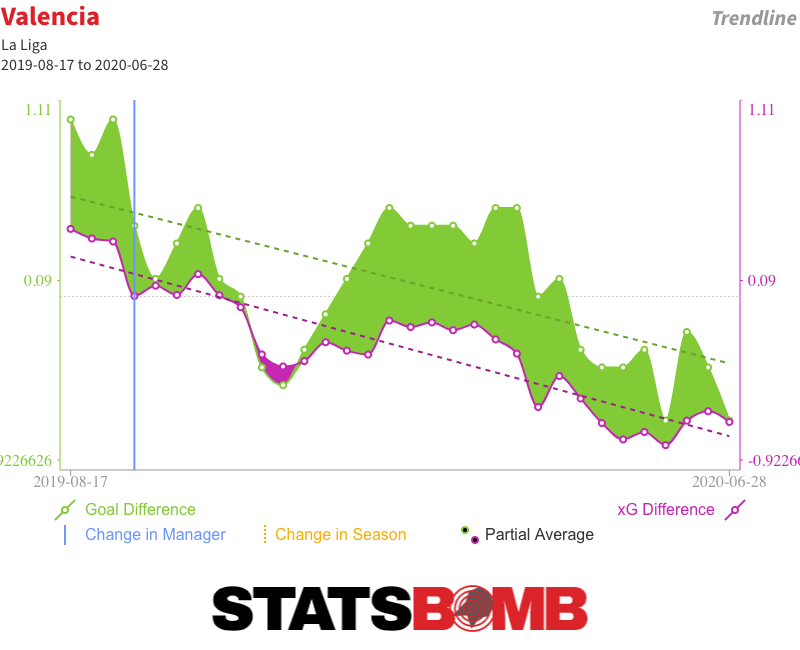 As is almost always the case, there have been attempts to create a narrative arc, to say that things were okay until injuries took hold or to identify a tipping point when control of the dressing room was lost. But the truth is that Valencia were never very good under Celades. It just took a little while for results to reflect that reality. Arthur Leaves, Barcelona Get Older Still Consecutive draws against Celta Vigo and Atlético Madrid have probably ended Barcelona’s challenge for La Liga. Even if they win all five of their remaining matches, Real Madrid can afford to drop four points in their remaining six and still claim the title thanks to their superior head-to-head record. Off the pitch, Barcelona have this week confirmed what essentially amounts to a swap deal with Juventus that will see the Italian club pay an initial €72 million for Arthur at the same time as Barcelona put down €60 million for Miralem Pjanic. It is not a move that makes much sporting sense. The two players have performed different roles this season, which complicates a direct comparison. But even if we accept that stylistic differences aside they are probably about par in terms of present ability, it remains difficult to form a cogent argument for swapping a soon-to-be 24-year-old for a 30-year-old. Particularly when Barcelona already have a large contingent of post-peak players gobbling up minutes.
As is almost always the case, there have been attempts to create a narrative arc, to say that things were okay until injuries took hold or to identify a tipping point when control of the dressing room was lost. But the truth is that Valencia were never very good under Celades. It just took a little while for results to reflect that reality. Arthur Leaves, Barcelona Get Older Still Consecutive draws against Celta Vigo and Atlético Madrid have probably ended Barcelona’s challenge for La Liga. Even if they win all five of their remaining matches, Real Madrid can afford to drop four points in their remaining six and still claim the title thanks to their superior head-to-head record. Off the pitch, Barcelona have this week confirmed what essentially amounts to a swap deal with Juventus that will see the Italian club pay an initial €72 million for Arthur at the same time as Barcelona put down €60 million for Miralem Pjanic. It is not a move that makes much sporting sense. The two players have performed different roles this season, which complicates a direct comparison. But even if we accept that stylistic differences aside they are probably about par in terms of present ability, it remains difficult to form a cogent argument for swapping a soon-to-be 24-year-old for a 30-year-old. Particularly when Barcelona already have a large contingent of post-peak players gobbling up minutes. 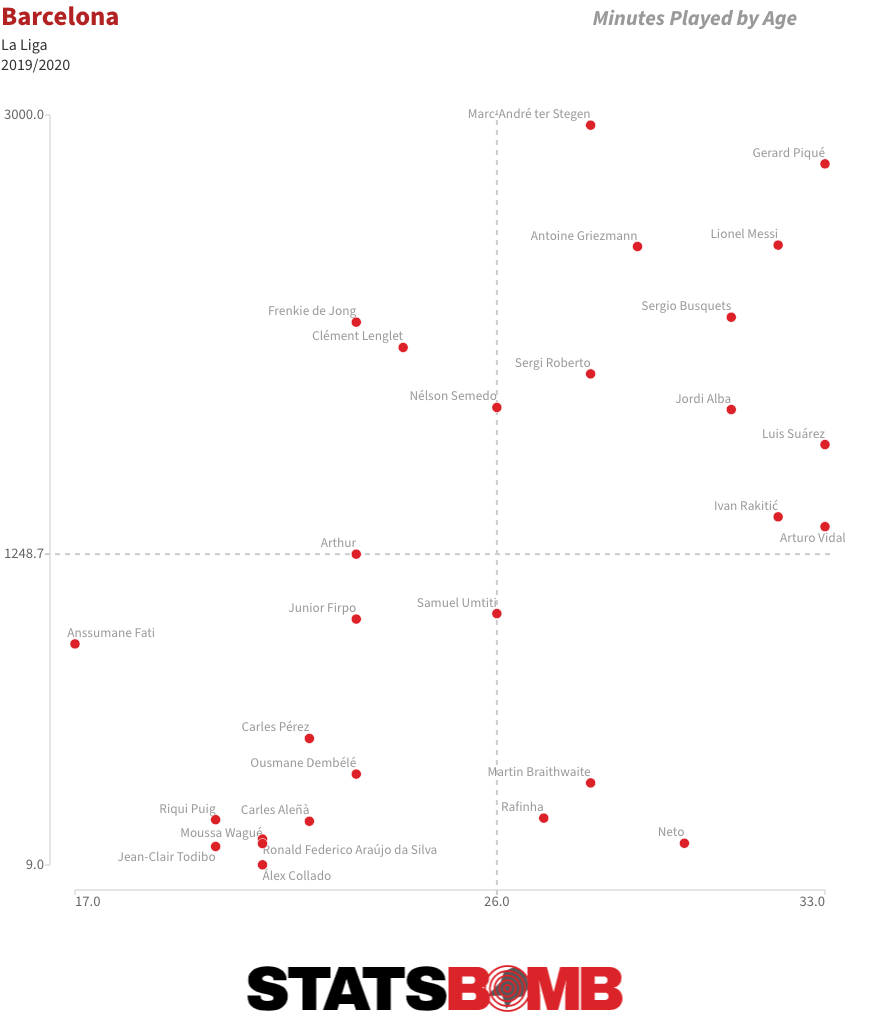 The truth is that this deal isn’t about what happens on the pitch; it’s about moving around figures on a spreadsheet to balance budgets. Both teams had deficits to make up and constructed a mutual means of doing so. Alternative scenarios that revolve around Barcelona selling Arthur but reinvesting the money in a young midfielder or banking it and promoting from within simply aren’t realistic; Juventus would never have paid that much for him if they didn’t have €60 million coming right back the other way. Performance may not have been the primary driver behind Arthur’s departure, but it is also fair to say that he hasn’t quite taken the step forward some at the club had hoped for. Prior to the season start, then-coach Ernesto Valverde set him the target of increasing his attacking output, and
The truth is that this deal isn’t about what happens on the pitch; it’s about moving around figures on a spreadsheet to balance budgets. Both teams had deficits to make up and constructed a mutual means of doing so. Alternative scenarios that revolve around Barcelona selling Arthur but reinvesting the money in a young midfielder or banking it and promoting from within simply aren’t realistic; Juventus would never have paid that much for him if they didn’t have €60 million coming right back the other way. Performance may not have been the primary driver behind Arthur’s departure, but it is also fair to say that he hasn’t quite taken the step forward some at the club had hoped for. Prior to the season start, then-coach Ernesto Valverde set him the target of increasing his attacking output, and 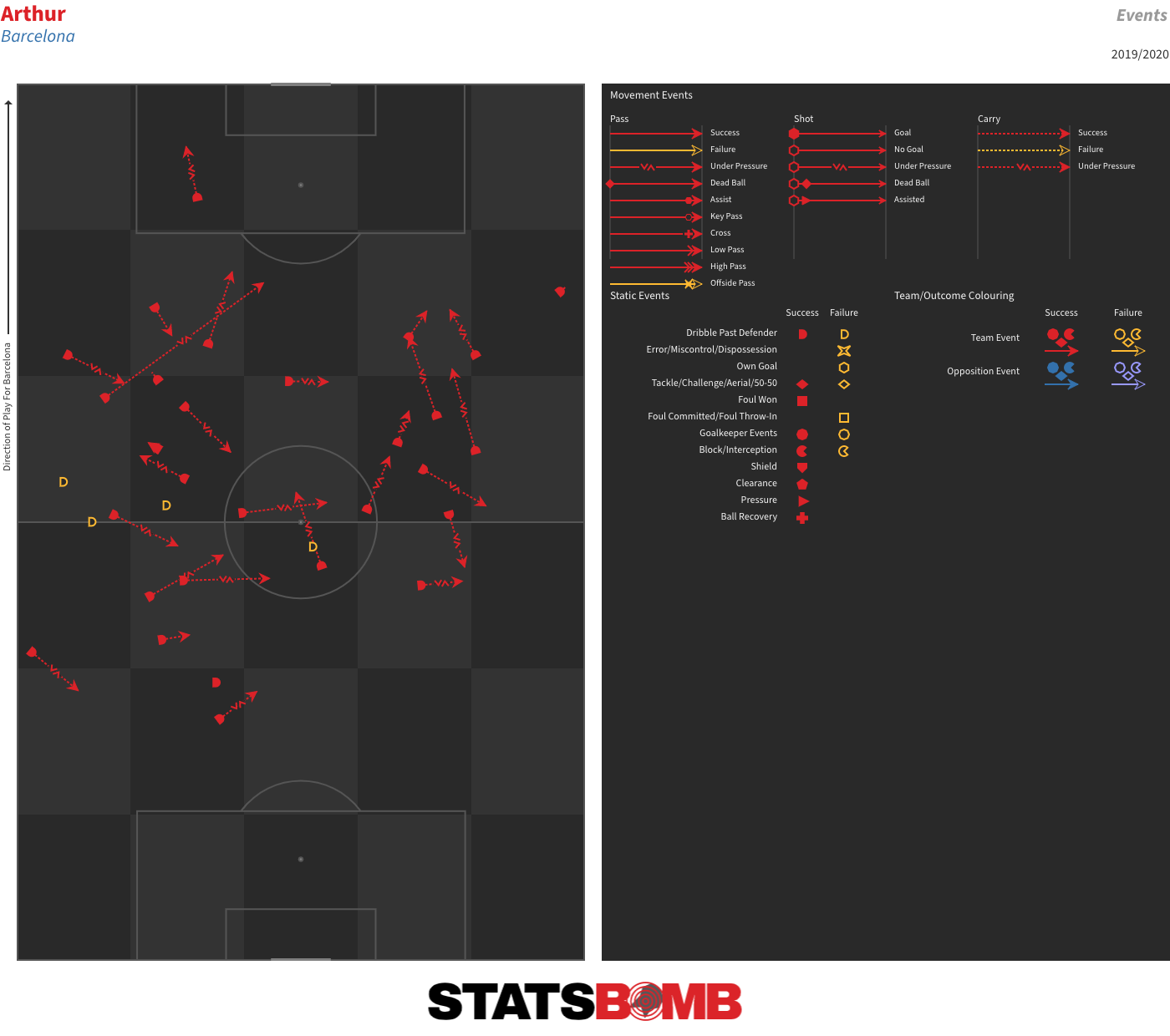 He’s also carried the ball further per 90 than any of the league’s other central midfielders.
He’s also carried the ball further per 90 than any of the league’s other central midfielders. 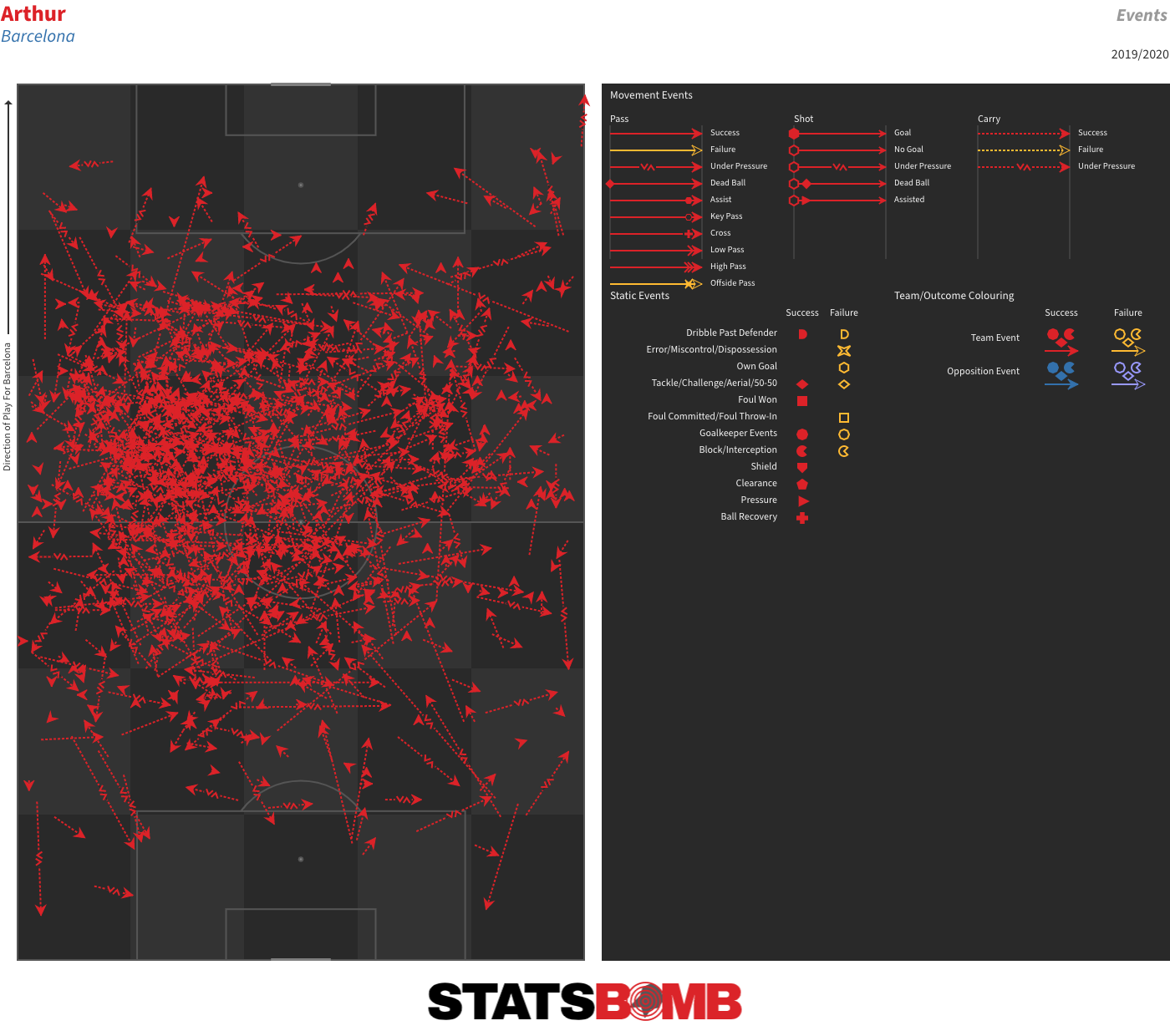 Add that to a very solid overall passing game and you have a player who probably deserved the benefit of at least another season to try and up his final-third output and offer a bit more defensively. Particularly so given how difficult it is to untangle some of his stagnant final-third output from the general attacking (and overall) decline at Barcelona. As it was, he represented the most sellable asset of a club who needed to balance their books. The fitness problems that have seen him miss a number of matches with knocks and niggling injuries arguably created enough doubts around him to justify Barcelona cashing in on him in a favourable deal. It’s just very hard to say that this was it.
Add that to a very solid overall passing game and you have a player who probably deserved the benefit of at least another season to try and up his final-third output and offer a bit more defensively. Particularly so given how difficult it is to untangle some of his stagnant final-third output from the general attacking (and overall) decline at Barcelona. As it was, he represented the most sellable asset of a club who needed to balance their books. The fitness problems that have seen him miss a number of matches with knocks and niggling injuries arguably created enough doubts around him to justify Barcelona cashing in on him in a favourable deal. It’s just very hard to say that this was it.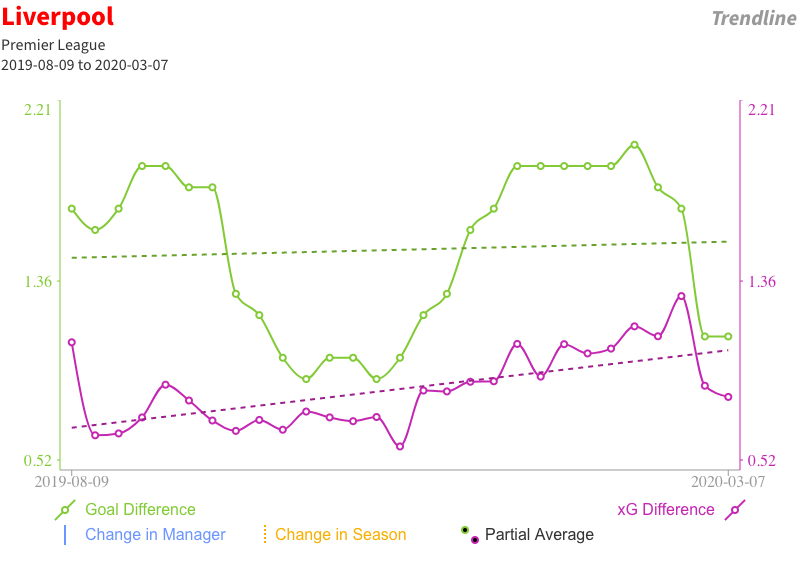
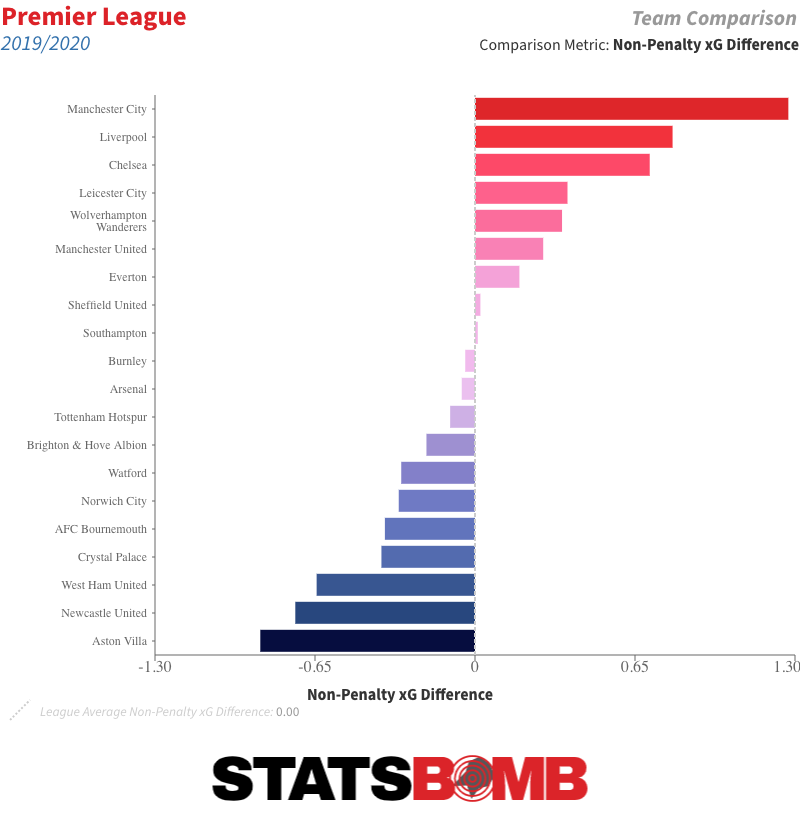 Manchester United and Wolverhampton Wanderers are separated by just two points, and are pretty much neck and neck on expected goal (xG) difference. The underlying numbers over the last 10 matches suggest the momentum is with Wolves...
Manchester United and Wolverhampton Wanderers are separated by just two points, and are pretty much neck and neck on expected goal (xG) difference. The underlying numbers over the last 10 matches suggest the momentum is with Wolves... 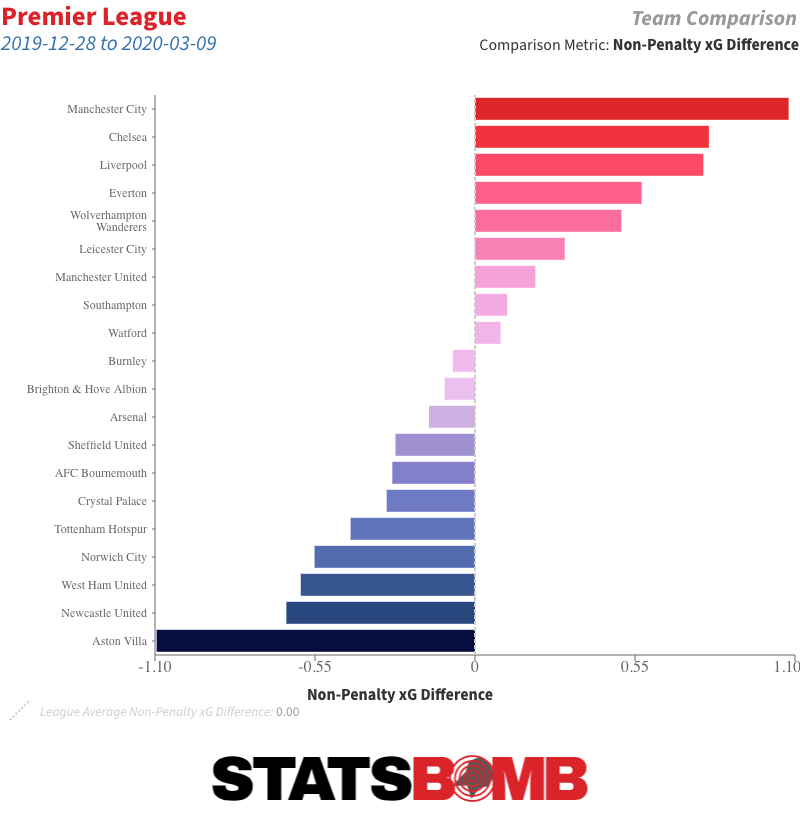 ...but it is United who have taken more points in that time: 17 to 13. These things often take much longer than nine matches to shake themselves out, especially when the differences are fairly minimal. United will also benefit from the return from injury of Marcus Rashford, their primary attacking contributor.
...but it is United who have taken more points in that time: 17 to 13. These things often take much longer than nine matches to shake themselves out, especially when the differences are fairly minimal. United will also benefit from the return from injury of Marcus Rashford, their primary attacking contributor. 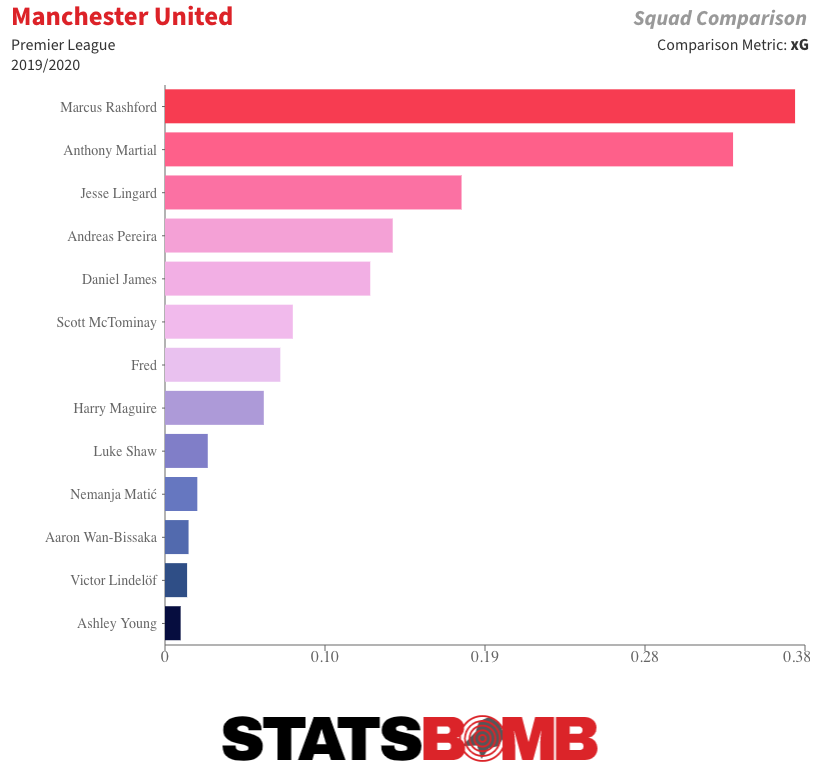 Tottenham Hotspur have also profited from the pause in action, as it has allowed them to recover some much-needed firepower in the form of Harry Kane and Heung-Min Son (as well as January recruit Steven Bergwijn).
Tottenham Hotspur have also profited from the pause in action, as it has allowed them to recover some much-needed firepower in the form of Harry Kane and Heung-Min Son (as well as January recruit Steven Bergwijn). 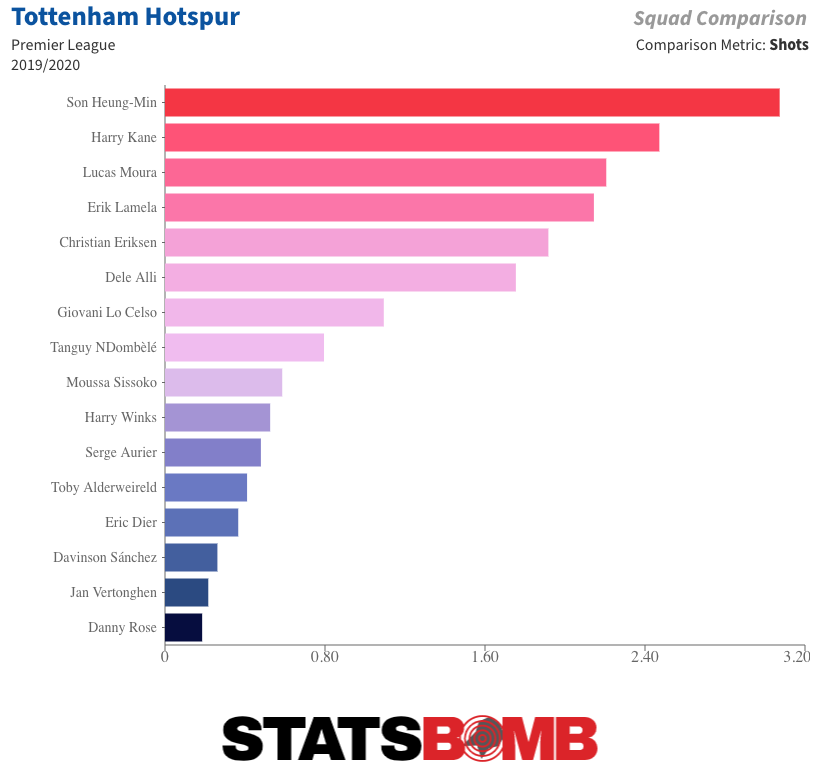 That alone is unlikely to turn things around for a side who after an initial surge under Jose Mourinho had combined mid-table results with downright sad underlying numbers in the lead up to the league stoppage, but it certainly won’t hurt their chances. Sheffield United are a couple of points ahead of Spurs and have a game in hand that if won would see them leapfrog United into fifth. They’ve already defied the odds by coming up and immediately establishing themselves as a very solid top-flight side, and while their numbers aren’t as good as those of some of the teams around them, they are still very much in the mix. Arsenal are at the back end of the group, and haven’t really shown enough
That alone is unlikely to turn things around for a side who after an initial surge under Jose Mourinho had combined mid-table results with downright sad underlying numbers in the lead up to the league stoppage, but it certainly won’t hurt their chances. Sheffield United are a couple of points ahead of Spurs and have a game in hand that if won would see them leapfrog United into fifth. They’ve already defied the odds by coming up and immediately establishing themselves as a very solid top-flight side, and while their numbers aren’t as good as those of some of the teams around them, they are still very much in the mix. Arsenal are at the back end of the group, and haven’t really shown enough 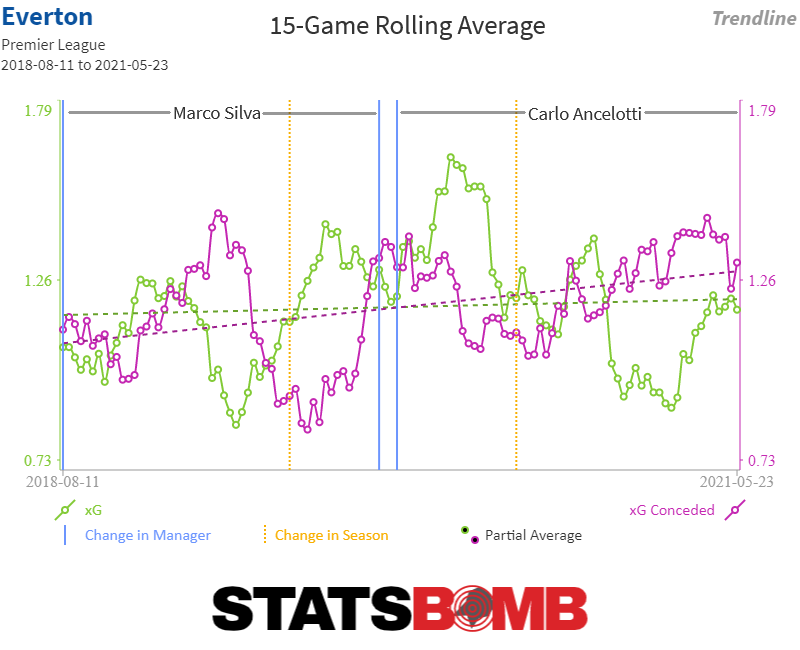 Relegation At the bottom of the table, there are probably six teams fighting to avoid filling the three relegation spots. Southampton, five points up the road from 15th placed Brighton and seven points clear of the bottom three, will likely be okay. [table id=84 /] Norwich are four points adrift at the bottom and it’s honestly difficult to see them making up the six points that separate them from safety. Their attempt to
Relegation At the bottom of the table, there are probably six teams fighting to avoid filling the three relegation spots. Southampton, five points up the road from 15th placed Brighton and seven points clear of the bottom three, will likely be okay. [table id=84 /] Norwich are four points adrift at the bottom and it’s honestly difficult to see them making up the six points that separate them from safety. Their attempt to 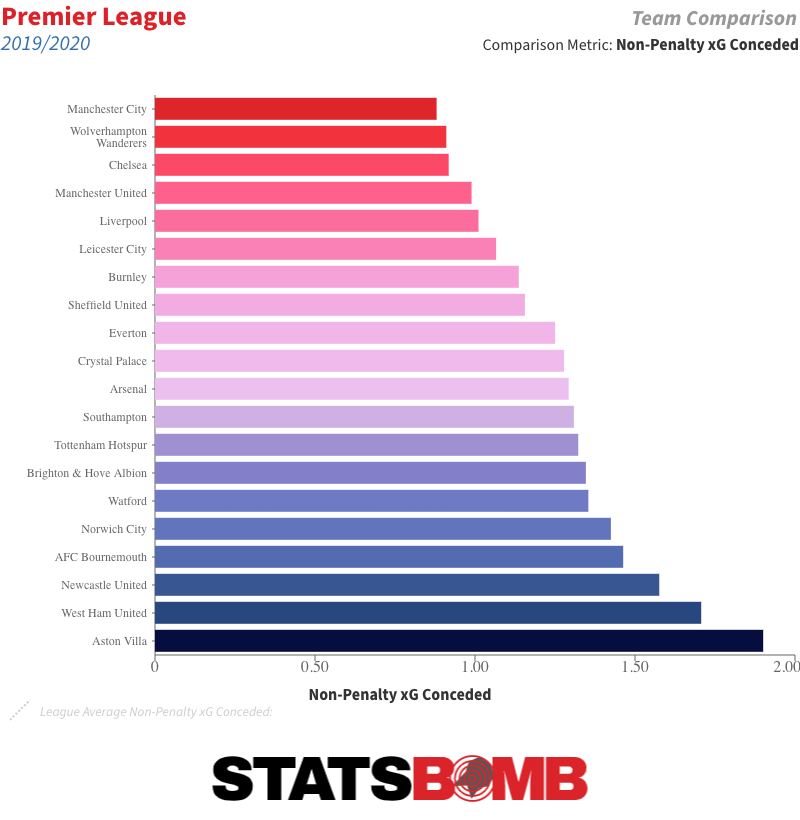 When your are conceding an average of two goals per match, you need your attack to be pretty damn good. Villa’s is only okay. They do, though, have a game in hand over those around them. Then comes the real action, four teams separated by just two points: Bournemouth, Watford, West Ham and Brighton. It is an incredibly hard race to call, and in truth, it wouldn’t be all that surprising if a similar number of points covered them come the end of the campaign. Watford have the momentum. Since Nigel Pearson became their third head coach of the season in early December, they’ve matched top-half results to top-half underlying numbers. There has been clear improvement, especially in defence.
When your are conceding an average of two goals per match, you need your attack to be pretty damn good. Villa’s is only okay. They do, though, have a game in hand over those around them. Then comes the real action, four teams separated by just two points: Bournemouth, Watford, West Ham and Brighton. It is an incredibly hard race to call, and in truth, it wouldn’t be all that surprising if a similar number of points covered them come the end of the campaign. Watford have the momentum. Since Nigel Pearson became their third head coach of the season in early December, they’ve matched top-half results to top-half underlying numbers. There has been clear improvement, especially in defence. 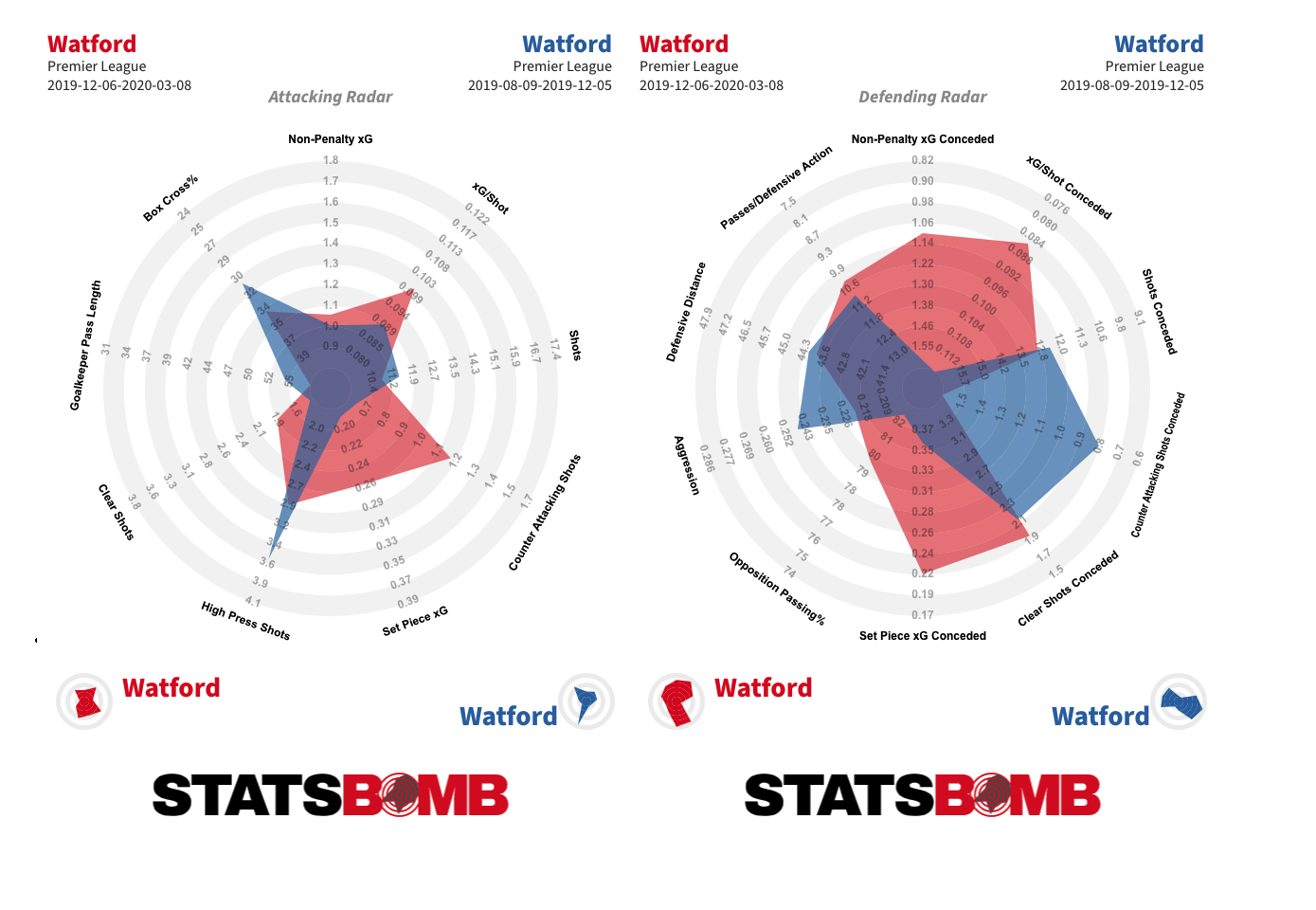 David Moyes has not yet had the same effect at West Ham. Results and underlying numbers have actually got marginally worse there since he replaced Manuel Pellegrini at the end of December. The stylistic changes are clear: deeper and more passive defending, and a greater reliance on transitional phases to create shots. The end result is all but unchanged.
David Moyes has not yet had the same effect at West Ham. Results and underlying numbers have actually got marginally worse there since he replaced Manuel Pellegrini at the end of December. The stylistic changes are clear: deeper and more passive defending, and a greater reliance on transitional phases to create shots. The end result is all but unchanged. 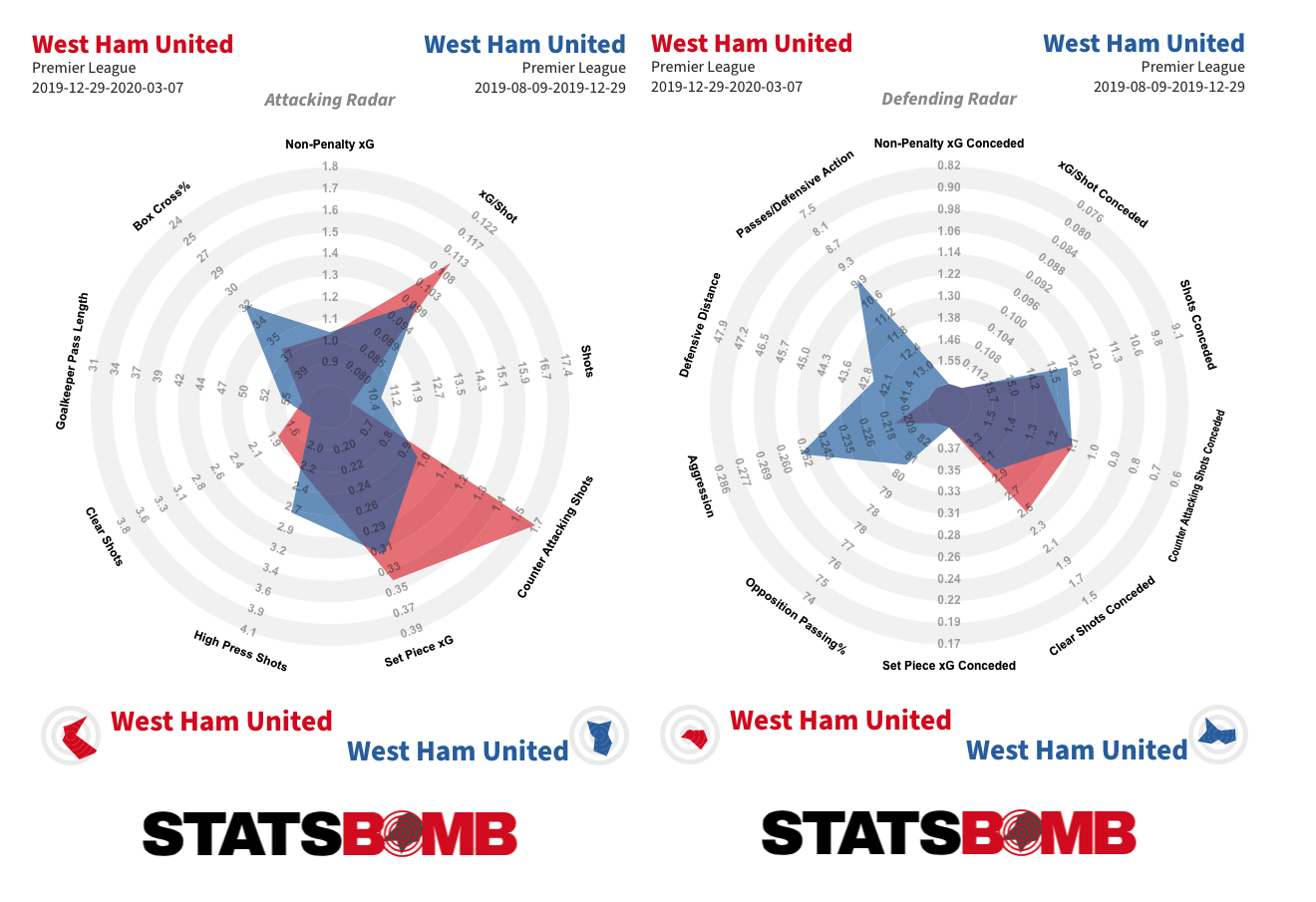 Bournemouth are one of the worst six teams by the underlying numbers and slipped into the bottom three off the back of three defeats and a draw prior to the league stoppage. They don’t inspire a great deal of confidence at either end of the pitch, and may have to lean on their
Bournemouth are one of the worst six teams by the underlying numbers and slipped into the bottom three off the back of three defeats and a draw prior to the league stoppage. They don’t inspire a great deal of confidence at either end of the pitch, and may have to lean on their 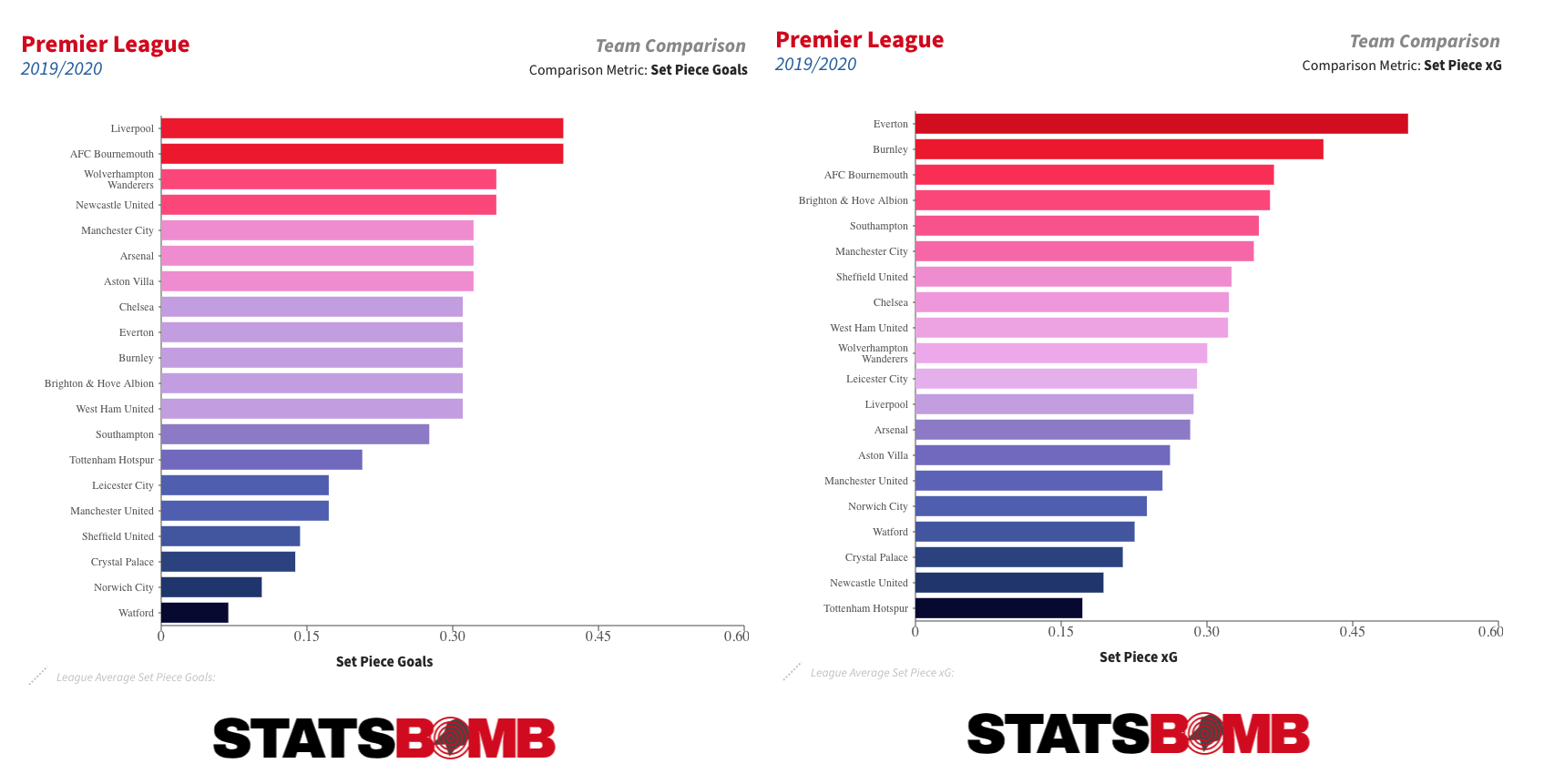 Brighton are yet to win a match this calendar year, and in fact have won only once in their last 14. No team have taken fewer points in 2020. While it is fairly easy to
Brighton are yet to win a match this calendar year, and in fact have won only once in their last 14. No team have taken fewer points in 2020. While it is fairly easy to 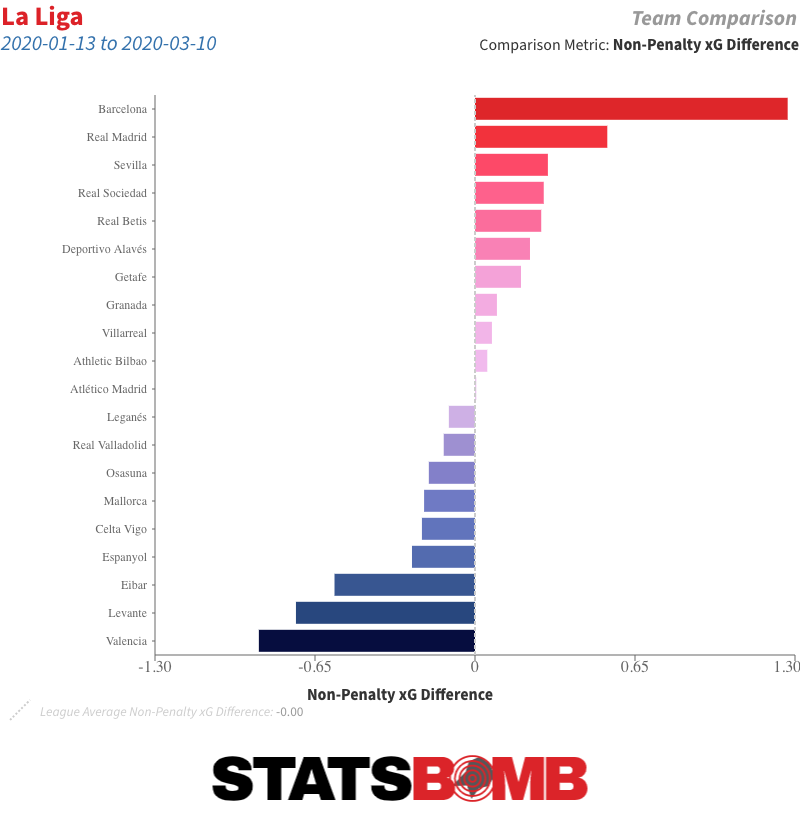 Setién’s heavily possession-based style should also be a good fit for the hectic fixture list that, if everything runs smoothly, will see the teams play their remaining 11 matches over the course of just over five weeks of action. There are some counterpoints. On paper, Madrid look to have the easier run-in. The pause has also given Eden Hazard the opportunity to recover from what seemed likely to be a season-ending injury. With Marco Asensio likewise closing in on a return, Madrid look better equipped than they might otherwise have been to go toe-to-toe for the title. European Places The contest for the two remaining Champions League places will be a thrilling watch. Just two points currently span Sevilla in third, Real Sociedad in fourth, Getafe in fifth and Atlético Madrid in sixth. Sevilla possibly have a slight edge. January signings
Setién’s heavily possession-based style should also be a good fit for the hectic fixture list that, if everything runs smoothly, will see the teams play their remaining 11 matches over the course of just over five weeks of action. There are some counterpoints. On paper, Madrid look to have the easier run-in. The pause has also given Eden Hazard the opportunity to recover from what seemed likely to be a season-ending injury. With Marco Asensio likewise closing in on a return, Madrid look better equipped than they might otherwise have been to go toe-to-toe for the title. European Places The contest for the two remaining Champions League places will be a thrilling watch. Just two points currently span Sevilla in third, Real Sociedad in fourth, Getafe in fifth and Atlético Madrid in sixth. Sevilla possibly have a slight edge. January signings 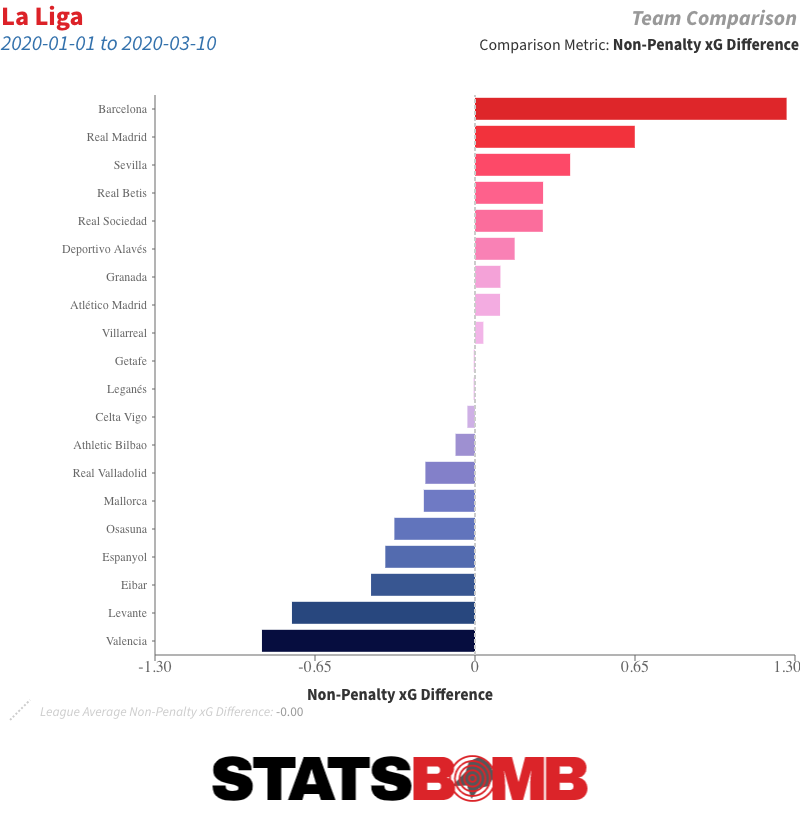 But this is a very difficult race to call. Real Sociedad have won admirers as a young and vibrant team playing attractive football, but they look to have the toughest schedule of any of the top-four aspirants. Getafe have been on a tear since the turn of the year, but can they maintain their intense play style through the crammed fixture list? With their
But this is a very difficult race to call. Real Sociedad have won admirers as a young and vibrant team playing attractive football, but they look to have the toughest schedule of any of the top-four aspirants. Getafe have been on a tear since the turn of the year, but can they maintain their intense play style through the crammed fixture list? With their 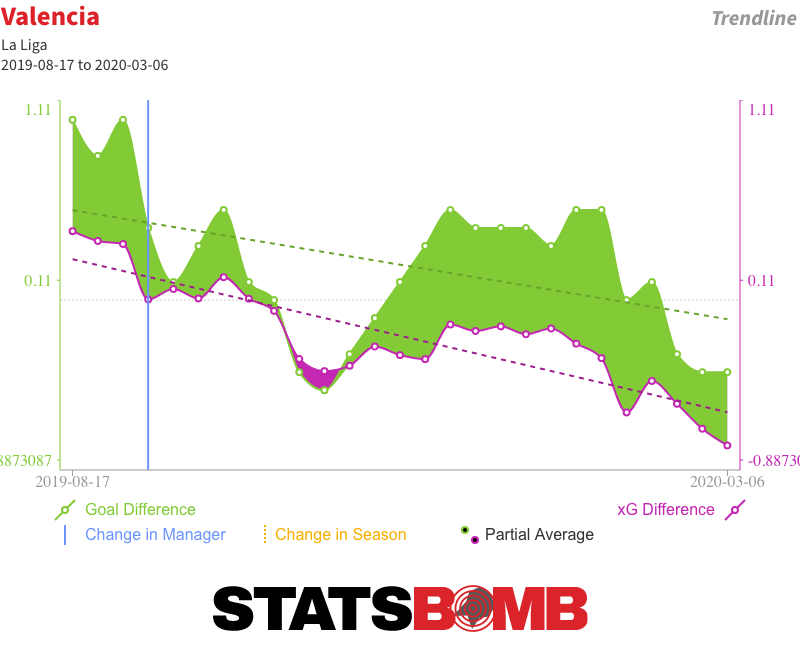 Valencia’s numbers are trending in the wrong direction, and it seems improbable that a team taking less than nine shots a match while conceding nearly 15 can continue to get the results necessary to keep pace with those ahead. In fact, their seventh place, a position that could yield a Europa League spot depending on the outcomes of domestic and continental cup competitions, could come under threat from behind. Villarreal have been frustratingly inconsistent but have enough quality in attack to make up the four-point difference if things go their way. Granada have impressed on their return to the top flight and made a good start to 2020. But that’s probably it. Athletic Club have one of the best defensive records in the league but their attacking output is below average, and they’ve benefited from a positive swing versus their underlying numbers. They’ve also taken just 11 points from their last 12 fixtures. The Copa del Rey final against Basque rivals Real Sociedad would seem to offer their best hope of European qualification. Relegation There are three relegation places to be filled and six teams trying to avoid them. While there is still an outside chance that Alavés or Levante might get dragged into it, the battle against the drop is likely to be contested by Espanyol, Leganés, Mallorca, Celta Vigo, Eibar and Real Valladolid. Espanyol are bottom of the pile. Results have improved considerably since Abelardo became their third head coach of the campaign late into December, but there hasn’t been an
Valencia’s numbers are trending in the wrong direction, and it seems improbable that a team taking less than nine shots a match while conceding nearly 15 can continue to get the results necessary to keep pace with those ahead. In fact, their seventh place, a position that could yield a Europa League spot depending on the outcomes of domestic and continental cup competitions, could come under threat from behind. Villarreal have been frustratingly inconsistent but have enough quality in attack to make up the four-point difference if things go their way. Granada have impressed on their return to the top flight and made a good start to 2020. But that’s probably it. Athletic Club have one of the best defensive records in the league but their attacking output is below average, and they’ve benefited from a positive swing versus their underlying numbers. They’ve also taken just 11 points from their last 12 fixtures. The Copa del Rey final against Basque rivals Real Sociedad would seem to offer their best hope of European qualification. Relegation There are three relegation places to be filled and six teams trying to avoid them. While there is still an outside chance that Alavés or Levante might get dragged into it, the battle against the drop is likely to be contested by Espanyol, Leganés, Mallorca, Celta Vigo, Eibar and Real Valladolid. Espanyol are bottom of the pile. Results have improved considerably since Abelardo became their third head coach of the campaign late into December, but there hasn’t been an 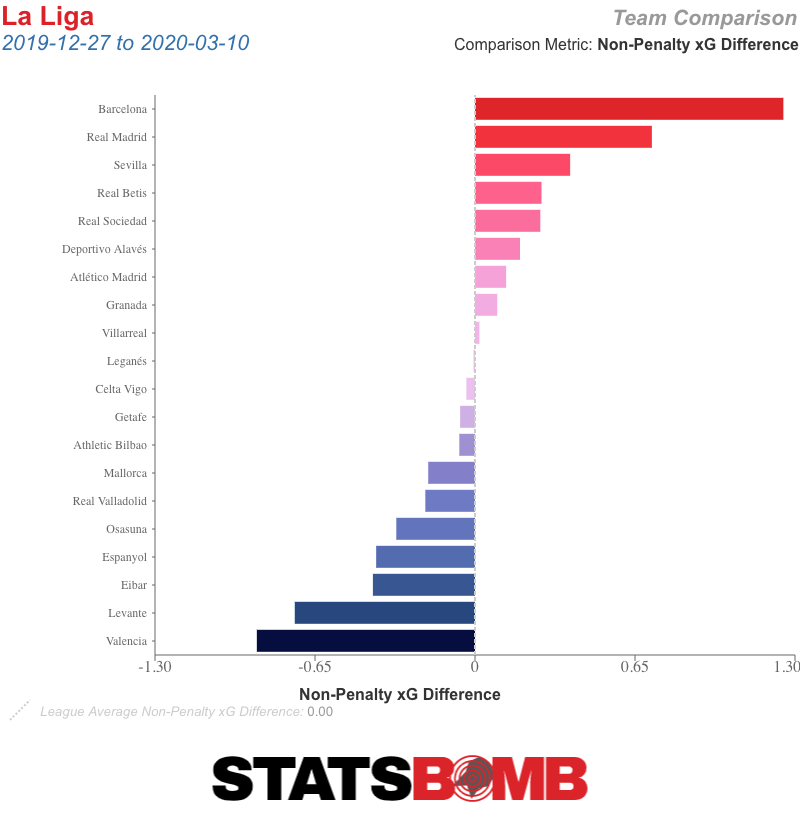 With other teams towards the foot of the table also picking up good points in the lead up to the league stoppage, they are still six points shy of safety. All is not lost. There is still over a quarter of the campaign to be played. But Espanyol are not in a good position right now. Second from bottom are Leganés. They’ve had mid-table underlying numbers all season but have consistently underperformed those numbers at both ends of the pitch.
With other teams towards the foot of the table also picking up good points in the lead up to the league stoppage, they are still six points shy of safety. All is not lost. There is still over a quarter of the campaign to be played. But Espanyol are not in a good position right now. Second from bottom are Leganés. They’ve had mid-table underlying numbers all season but have consistently underperformed those numbers at both ends of the pitch.  Their luck may yet turn, but the January departures of En-Nesyri and Martin Braithwaite, between them scorers of almost half of their league-low tally of 21 goals, certainly didn’t help their cause. Next up are Mallorca, Celta Vigo and Eibar, all separated by just two points between 18th and 16th. Mallorca have shown signs of improvement since the turn of the year, particularly in defence, but they have one of the hardest closing schedules and a thin squad. Things look brighter for Celta Vigo, who have been
Their luck may yet turn, but the January departures of En-Nesyri and Martin Braithwaite, between them scorers of almost half of their league-low tally of 21 goals, certainly didn’t help their cause. Next up are Mallorca, Celta Vigo and Eibar, all separated by just two points between 18th and 16th. Mallorca have shown signs of improvement since the turn of the year, particularly in defence, but they have one of the hardest closing schedules and a thin squad. Things look brighter for Celta Vigo, who have been 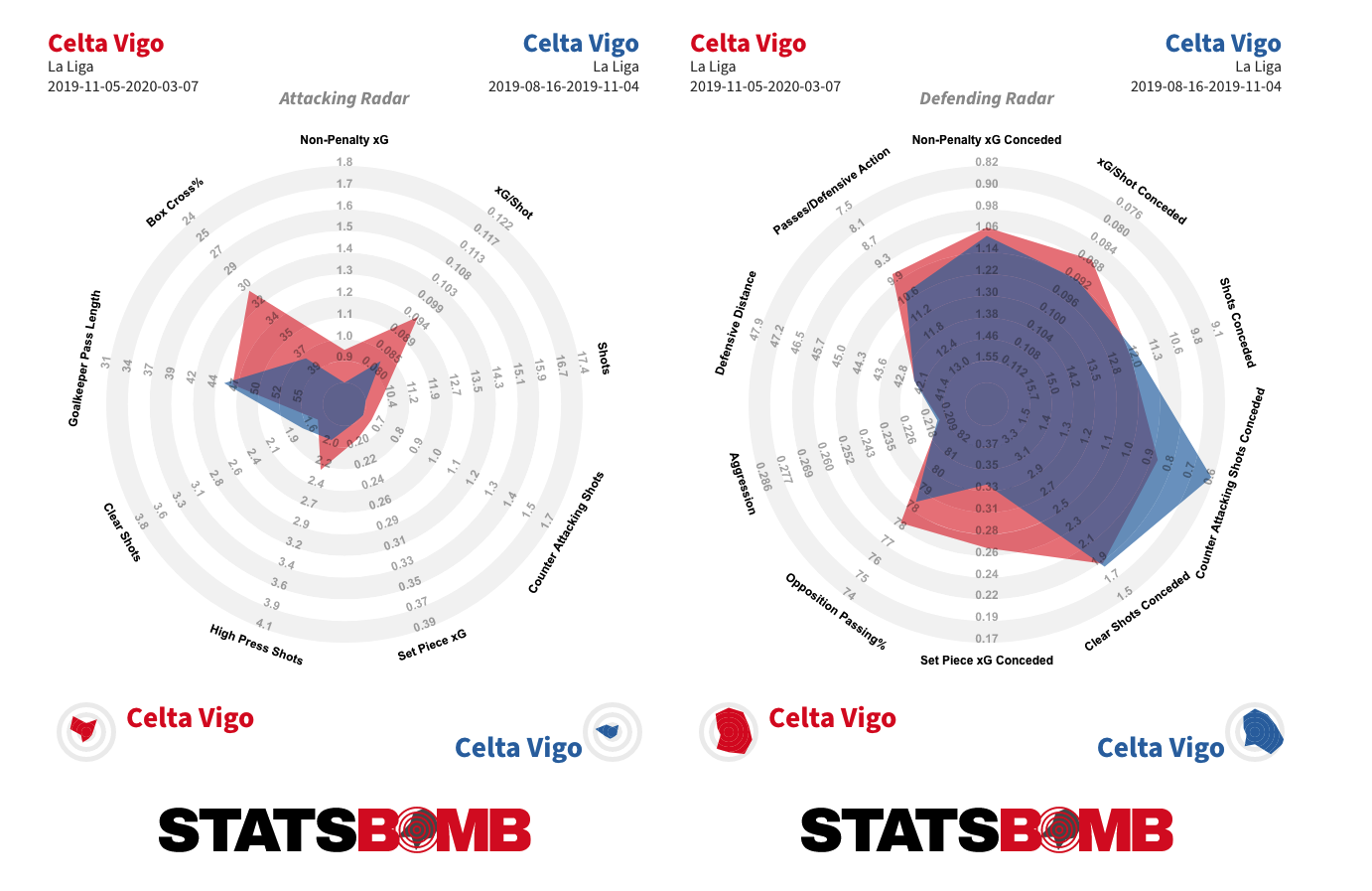 Eibar might be in trouble. While they’ve improved upon their pitiful early season performances, they’ve still been one of the worst three teams in the division by the underlying numbers since the turn of the year. A combination of the league’s oldest squad and an aggressive play style is unlikely to mesh well with the condensed schedule. Valladolid have a four-point cushion over the last relegation place. While they are far from home and dry, if they can continue to pick up points at their current rate -- which seems doable considering they are performing pretty much exactly in line with their underlying numbers -- it is unlikely that three teams will overtake them.
Eibar might be in trouble. While they’ve improved upon their pitiful early season performances, they’ve still been one of the worst three teams in the division by the underlying numbers since the turn of the year. A combination of the league’s oldest squad and an aggressive play style is unlikely to mesh well with the condensed schedule. Valladolid have a four-point cushion over the last relegation place. While they are far from home and dry, if they can continue to pick up points at their current rate -- which seems doable considering they are performing pretty much exactly in line with their underlying numbers -- it is unlikely that three teams will overtake them.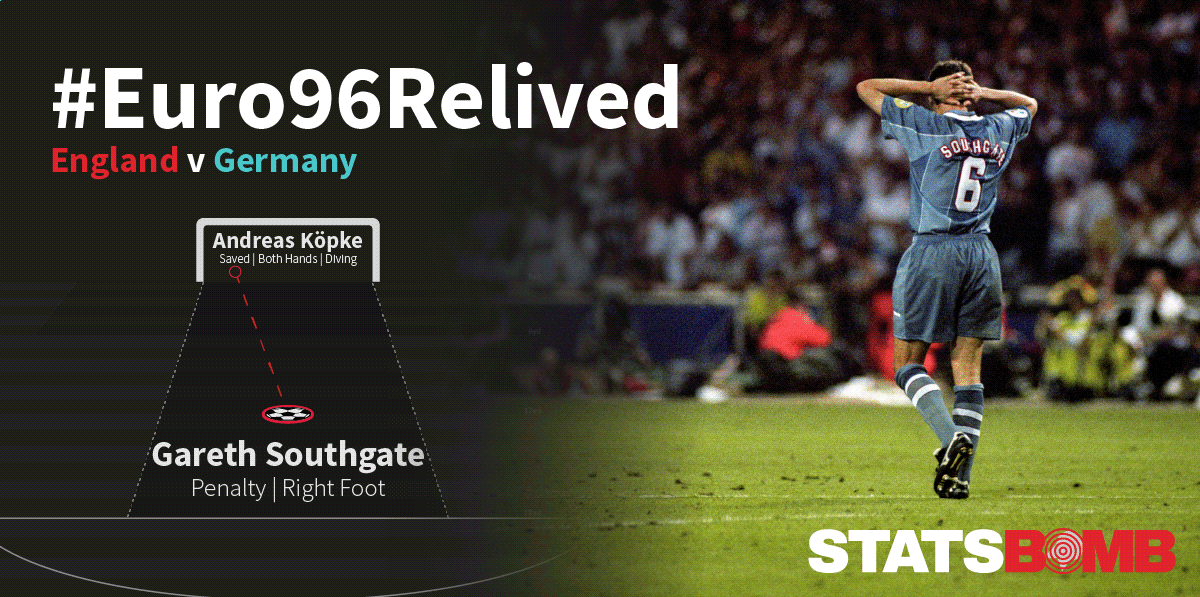
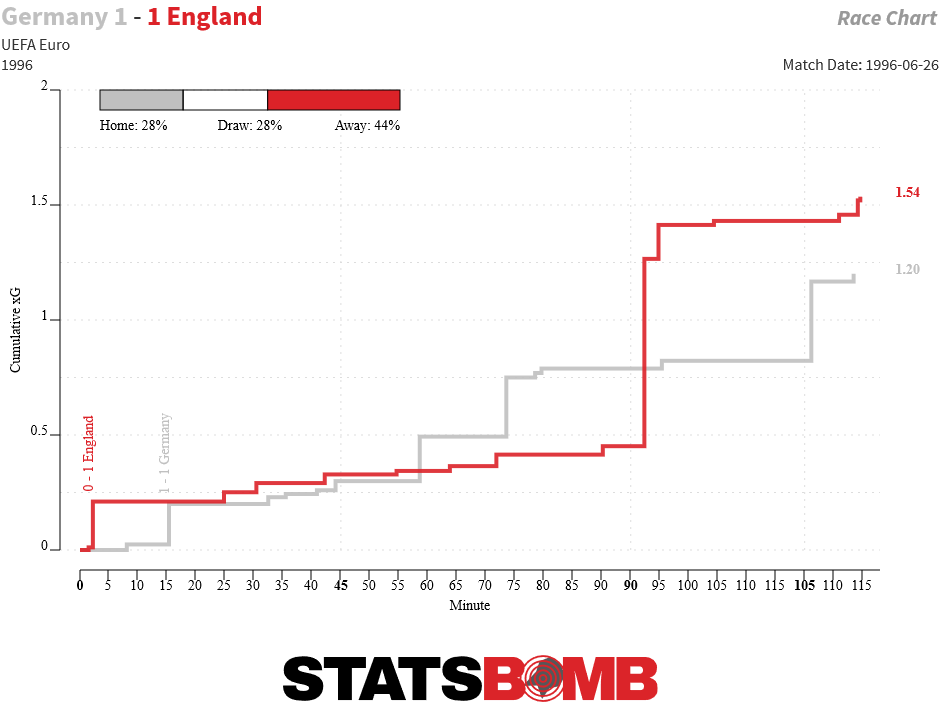 The game was as close as the final score suggested. Two early goals parked the sides at 1-1, a scoreline that persisted to the end of extra time. England had not one but two huge chances to win the game late on. Darren Anderton hit the post with the net gaping, as he tried to turn a ball that had trickily landed behind him, then famously Paul Gascoigne failed to connect with a cross that seemed easier to finish than not. No touch, no shot and therefore no mention in the sequence:
The game was as close as the final score suggested. Two early goals parked the sides at 1-1, a scoreline that persisted to the end of extra time. England had not one but two huge chances to win the game late on. Darren Anderton hit the post with the net gaping, as he tried to turn a ball that had trickily landed behind him, then famously Paul Gascoigne failed to connect with a cross that seemed easier to finish than not. No touch, no shot and therefore no mention in the sequence: 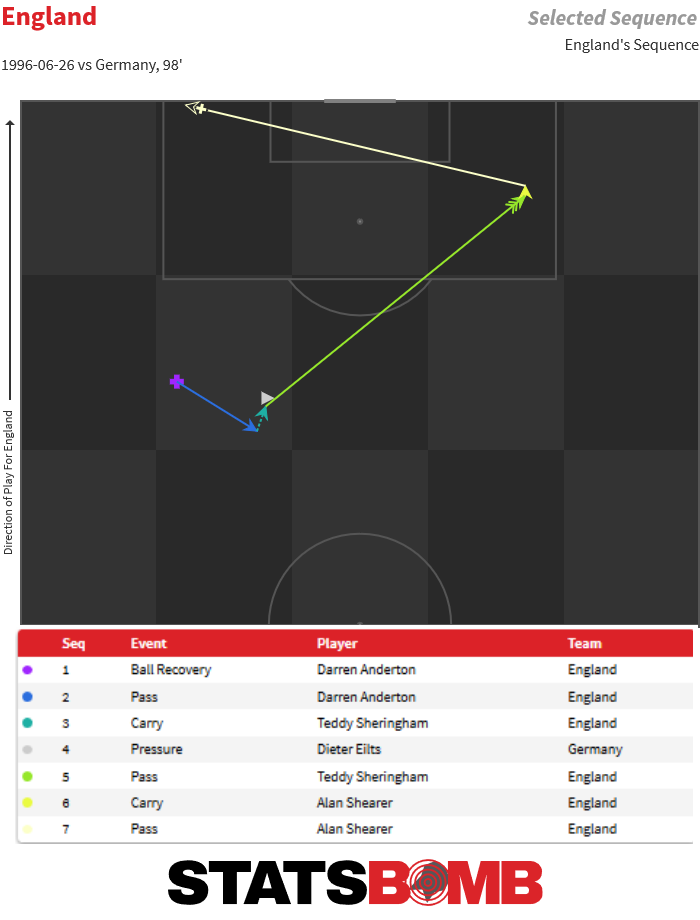
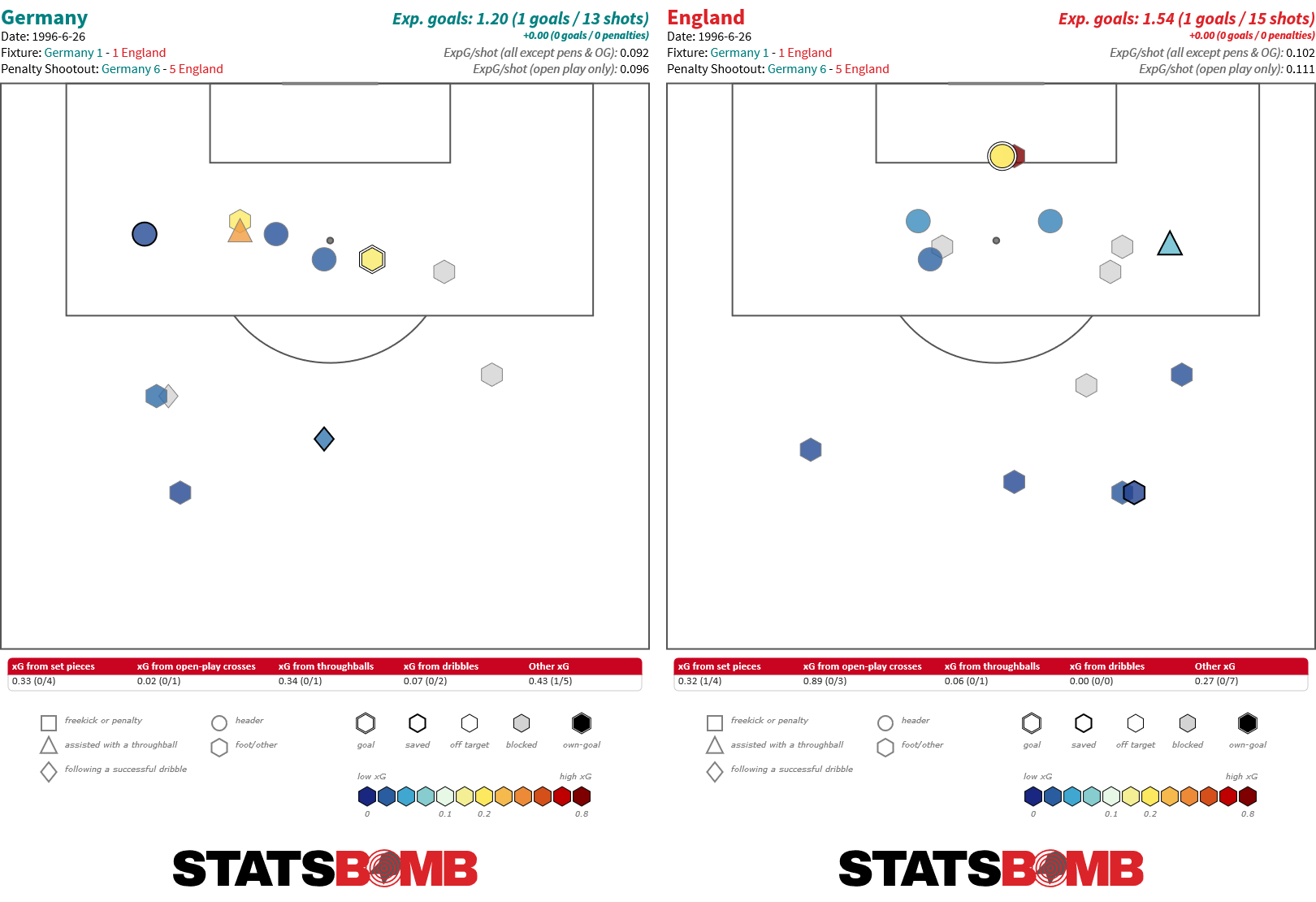 As we can see this was not a game of high quality chances. Apart from Anderton's miss, Alan Shearer's 3rd minute opener was the only shot significantly in advance of the penalty sport for either side. England once again tweaked their formation in this game, with three centre backs in a nominal 3-5-2 system, with wingers rather than traditional full backs placed in the wide slots:
As we can see this was not a game of high quality chances. Apart from Anderton's miss, Alan Shearer's 3rd minute opener was the only shot significantly in advance of the penalty sport for either side. England once again tweaked their formation in this game, with three centre backs in a nominal 3-5-2 system, with wingers rather than traditional full backs placed in the wide slots: 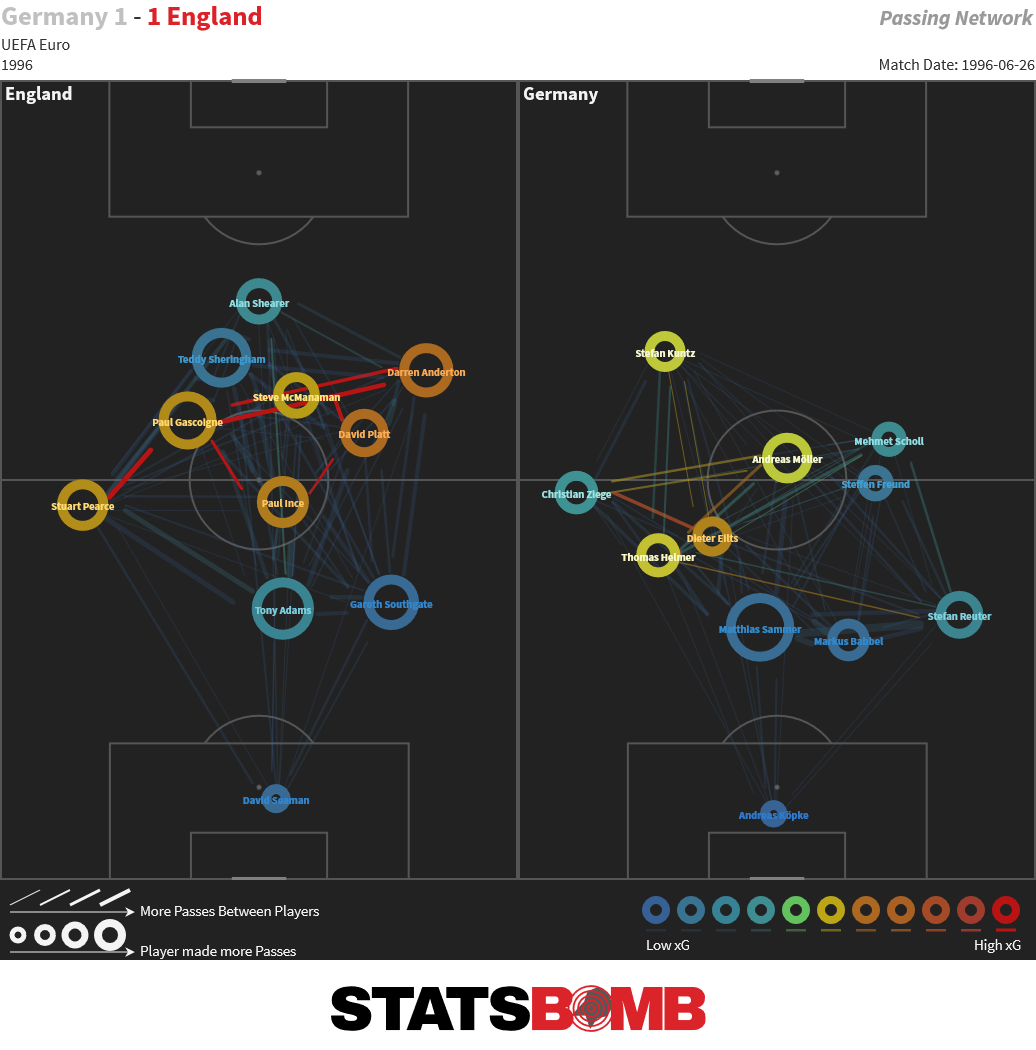 Unusually England did not make a substitution during the whole game, which gives us a unique opportunity to compare the first and second half pass positions without the interruption of replacements:
Unusually England did not make a substitution during the whole game, which gives us a unique opportunity to compare the first and second half pass positions without the interruption of replacements: 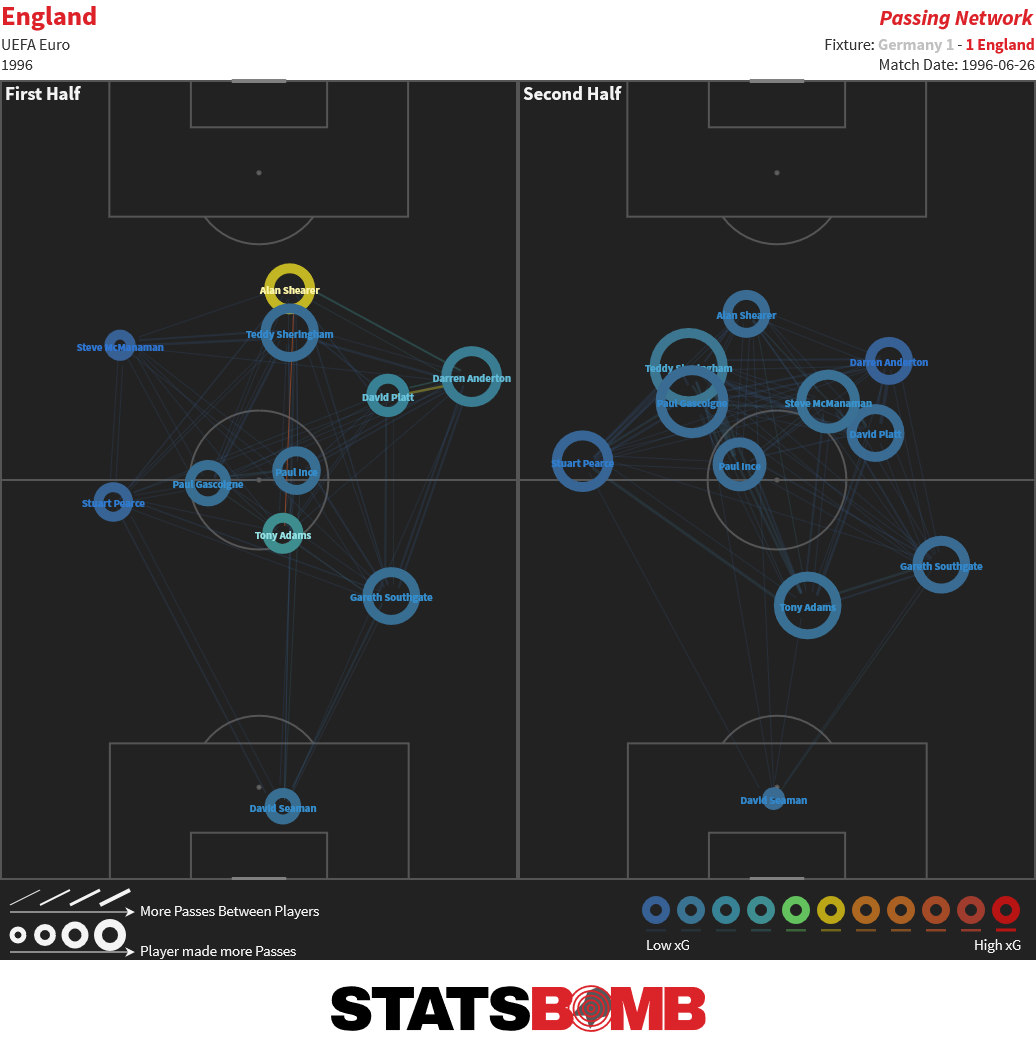 Steve McManaman and Darren Anderton kept to their wings in the first half, but were far more flexible in the second half. Gascoigne too saw a change in role from half to half, as he moved forwards as the game went on. Territory wise, England had far the better of it. Six players attempted over twenty passes in Germany's final third, while no German player attempted more than fifteen at the opposite end. David Platt in particular was neat and tidy with 94% passing, while unusually for a forward, Teddy Sheringham got through the most volume; 75 passes in total. In the end though, they couldn't make it pay and the game went to penalties.
Steve McManaman and Darren Anderton kept to their wings in the first half, but were far more flexible in the second half. Gascoigne too saw a change in role from half to half, as he moved forwards as the game went on. Territory wise, England had far the better of it. Six players attempted over twenty passes in Germany's final third, while no German player attempted more than fifteen at the opposite end. David Platt in particular was neat and tidy with 94% passing, while unusually for a forward, Teddy Sheringham got through the most volume; 75 passes in total. In the end though, they couldn't make it pay and the game went to penalties. 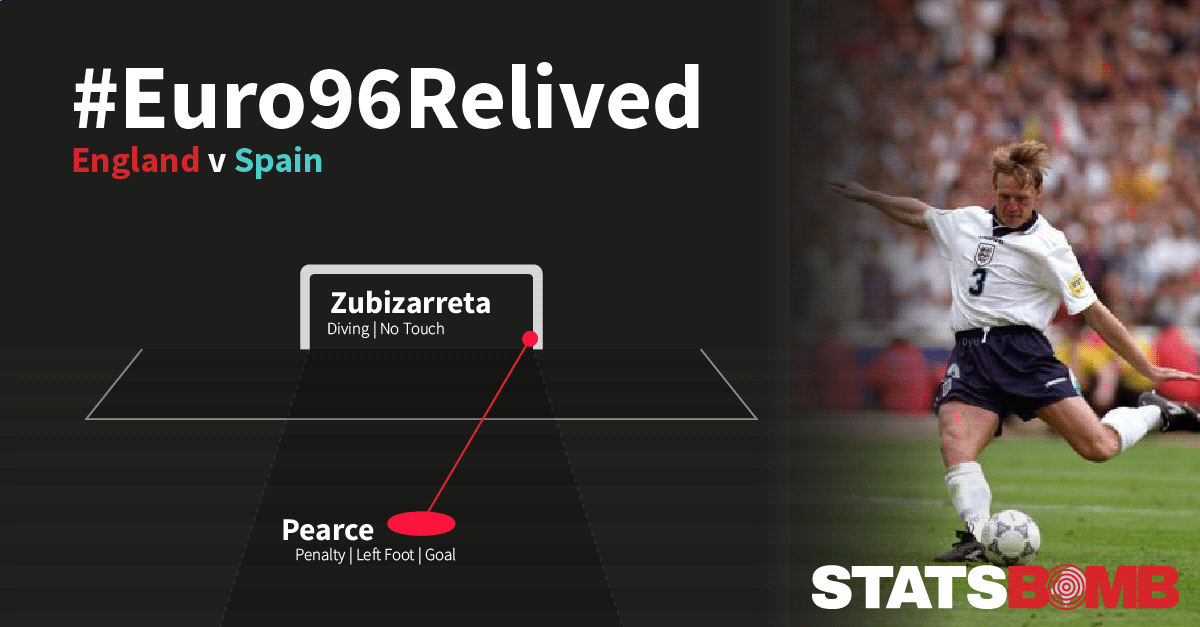
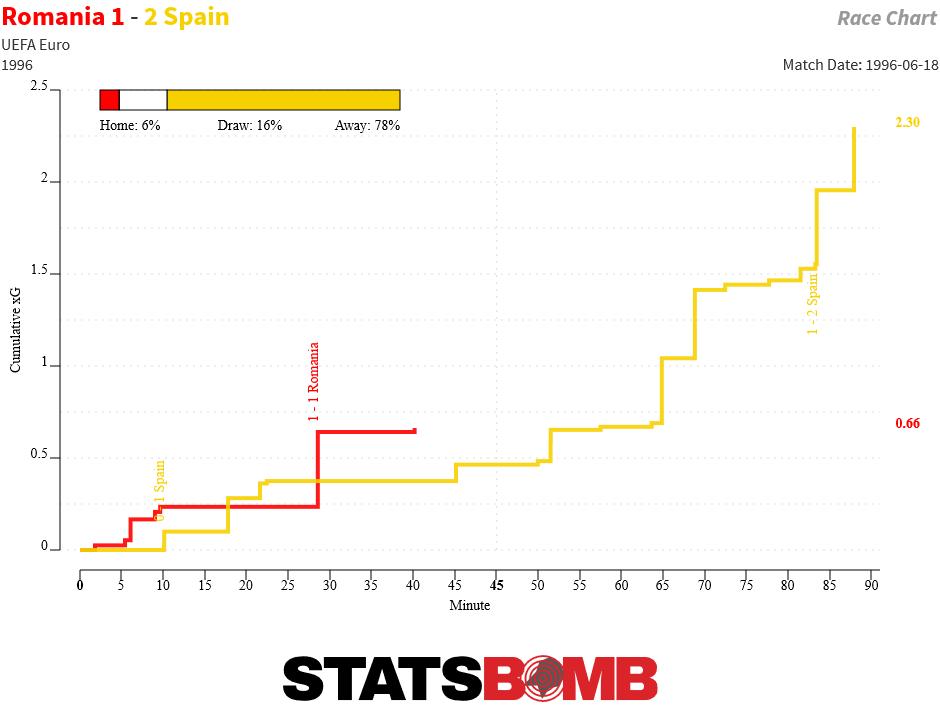 This game would be different though, up against an English team who top scored in the group stages. In the event the game was fairly cagey and even. Both team attempted around 600 passes and completed them at a percentage in the low 70s and while the shots were frequent, good chances were few:
This game would be different though, up against an English team who top scored in the group stages. In the event the game was fairly cagey and even. Both team attempted around 600 passes and completed them at a percentage in the low 70s and while the shots were frequent, good chances were few: 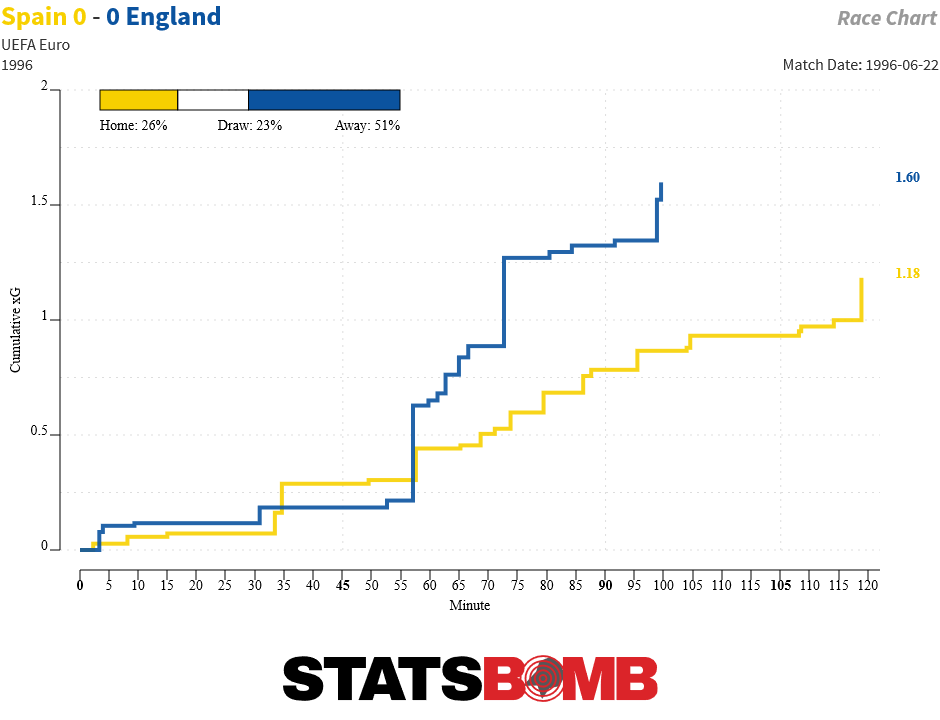 Did England tire? Surely they didn't try and hold for penalties? Regardless they had no shots in the second half of extra time. Overall, Spain outshot England 21 to 17 but their shot quality and accuracy was poor; just one shot on target and a lot of efforts from long range:
Did England tire? Surely they didn't try and hold for penalties? Regardless they had no shots in the second half of extra time. Overall, Spain outshot England 21 to 17 but their shot quality and accuracy was poor; just one shot on target and a lot of efforts from long range: 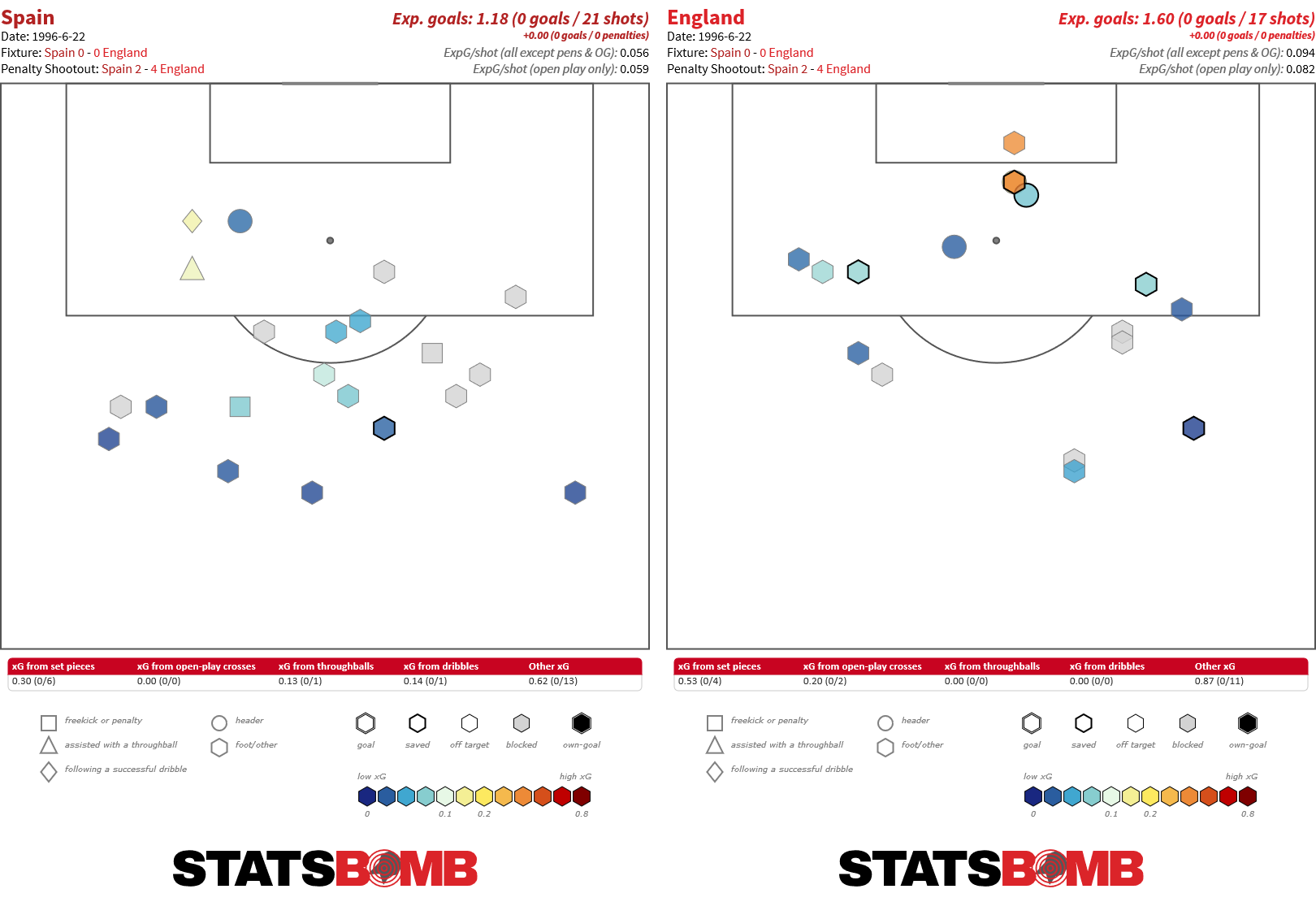 And so penalties took centre stage, with memories of England's 1990 World Cup still fresh.
And so penalties took centre stage, with memories of England's 1990 World Cup still fresh. 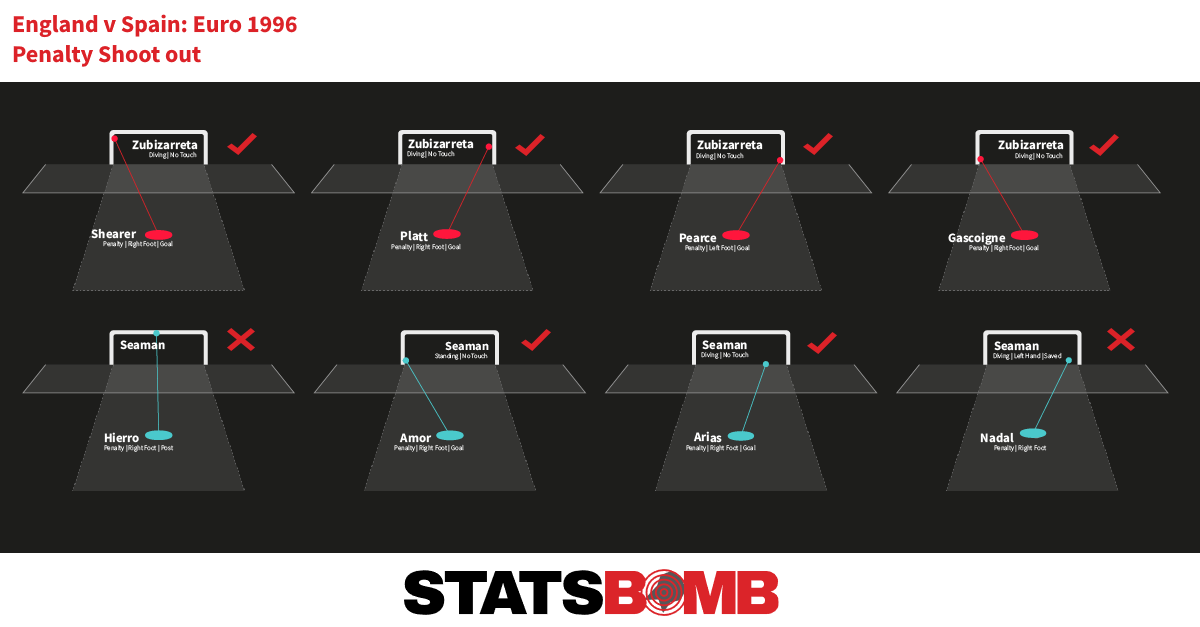 Shearer scored with aplomb, Fernando Hierro--who had taken the most shots in the game-7-with no success, failed again as he crashed the ball against the bar. David Platt scored, as did Guillermo Amor. Stuart Pearce stepped up next, like Platt he'd taken a penalty against Germany six years before, however unlike Platt he'd missed. Time for redemption? A trademark powerful strike answered that question with a resounding "yes" and the Wembley crowd responded wildly. Alberto Belsué scored to temporarily quieten them, Paul Gascoigne scored to raise the noise levels once more. Lastly Miguel Ángel Nadal stepped up, put the ball to David Seaman's left and the keeper guessed correctly. The semi-finals and Germany beckoned for England.
Shearer scored with aplomb, Fernando Hierro--who had taken the most shots in the game-7-with no success, failed again as he crashed the ball against the bar. David Platt scored, as did Guillermo Amor. Stuart Pearce stepped up next, like Platt he'd taken a penalty against Germany six years before, however unlike Platt he'd missed. Time for redemption? A trademark powerful strike answered that question with a resounding "yes" and the Wembley crowd responded wildly. Alberto Belsué scored to temporarily quieten them, Paul Gascoigne scored to raise the noise levels once more. Lastly Miguel Ángel Nadal stepped up, put the ball to David Seaman's left and the keeper guessed correctly. The semi-finals and Germany beckoned for England.